#Turtlethon
Explore tagged Tumblr posts
Note
The other one is much later in the show's run, in "Dirk Savage: Mutant Hunter", when we learn that Shredder continued to experiment on innocent people, over a period of years, to the point where there were so many mutants running around town that a politician could run on an anti-mutant campaign platform.
Do you remember exact dialogue on that? I watched that episode recently and the only thing I remember was that Tokka & Rahzar were stated to be the result of the Shredder experimenting on Zoo Animals, which I assume to be a reference to the Groundchuck and Dirtbag episodes.
As for the other mutants like the Giraffe lady and mutant bird, I assumed they weren't Shredder experiments but just people or animals that got hit by carelessly placed mutagen during the show's shenanigans rather than deliberate experiments.
Also I feel Baxter Stockman's harsh treatment from Shredder and Krang may have been because he was something of an outsider; being coerced into working for them and once trying to betray the Shredder. Rocksteady and Bebop's gangs were thugs that had been working for them to begin with, so I feel they'd get better treatment.
Upon reflection (and going back and watching the opening of the Dirk Savage ep again) I think you're right: the intent seems to be that the events in the zoo during the Turtleoids special have led to the creation of subsequent mutants over a period of a few years. I'm many months removed from watching the show at this point, so I was basing that on what I wrote at the time and my already potentially fuzzy recollections.
Regarding Shredder and the gang (and by extension, Krang/Baxter) I think where you stand on Shredder's willingness to undo their mutations probably depends on how evil you interpret him to be...
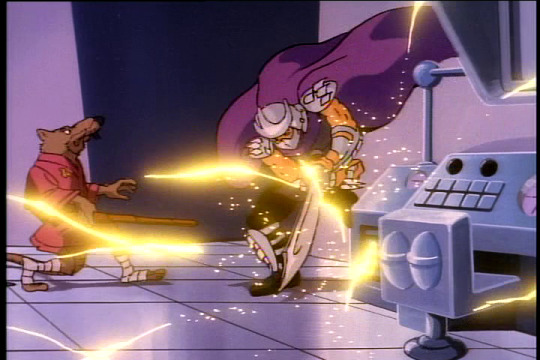
This Shredder is presented as a credible ninja master and criminal mastermind, and is the one who mutated the gang members...
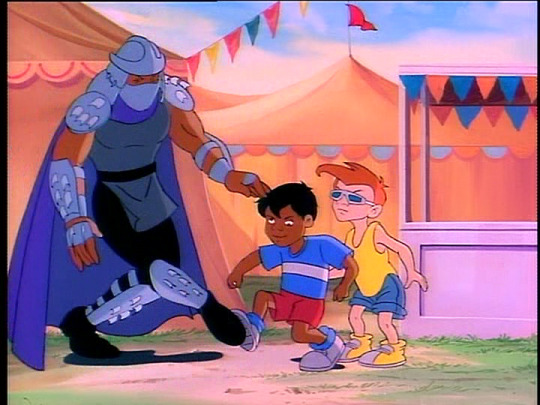
This Shredder is considerably less capable, to put it mildly, and if we're being honest more in-line with how he's presented for the bulk of the series. Outside of his feud with Splinter and the Turtles, his desire for world domination seems to be entirely rooted in his own vanity and self-aggrandizement.
His villainy/competence isn't a binary thing IMO, I think it can be charted on a spectrum depending on the era of the show and who's writing, but as a trend it keeps nudging into ineffectual goofball gradually up to the beginning of season eight, when it dramatically swings back in the opposite direction.
On that basis, I think the likelihood of Shredder undoing the mutations of the gang and letting them go depends on which point in the show it actually happens. If we're assuming it's in the window between S1 and S2 then maybe not, but after the S2 opener the way he's presented changes considerably and he seems to be borderline subservient to Krang rather than the two of them being in a fifty-fifty partnership. At that point I could see him just releasing the gang on the basis that he has enough to deal with, and doesn't need them hanging around.
In regards to Krang (and his attempted vaporizing of Baxter), I've long been of the opinion that as an alien warlord he likely places little value on human life, but I kind of like the idea that the presence of Shredder, Rocksteady & Bebop in the Technodrome softens him a bit and prevents him from being a total monster, in part because their incompetence invariably scuppers all of his plans and stops him doing any significant harm in the end. It's notable that he ordered Baxter's execution while Shredder, Rocksteady and Bebop were all on Earth, and there was no-one around to reason with him; I don't know if I'd go so far as to say they serve as his conscience, but, y'know... something like that!
#TMNT#TMNT 1987#Turtlethon#Shredder#Shredder TMNT#Imagine having Shredder Rocksteady and Bebop as the angels on your shoulder keeping you from being even worse
9 notes
·
View notes
Text
I’m briefly resurfacing from my turtle craze to post a question...
Has anyone else started getting an increase of questionable profiles following them on tumblr recently? Or is it just me?
I’m tempted to say they’re just bots and block them, especially with the profile pictures on some of them (with empty pages to boot). What do you think?
#I mean...they're not doing anything BAD exactly...#But I just don't like it#What can bots even DO on Tumblr?#Other than being mildly annoying I mean#Anyway#I'm off to block some of them before going back to my turtlethon/tmnt fanfics#Later!
3 notes
·
View notes
Note
Hi there!! I’m such a big fan of your reviews, you did a great job with them!! 😄
My biggest questions would be;
Who’s your favorite turtle? And if you had to choose just five episodes from the series, which ones would be your all time favorites? 😁
Thank you!! Have a great day!!
Thank you so much for the kind words! For the record, I'm Team Donnie, always a big fan of the inventor/scientist archetype. (Also my favourite colour is purple, so he gets an extra point right there.)
I feel like when it comes to picking the top five episodes the natural inclination is just to pick the first five, and with good reason; nothing that came after S1 had as much time, care or money afforded to it. So just to make things interesting, I'm going to set everything from season one aside and pick five more episodes that I think also deserve to be celebrated.
5. THE DIMENSION X STORY
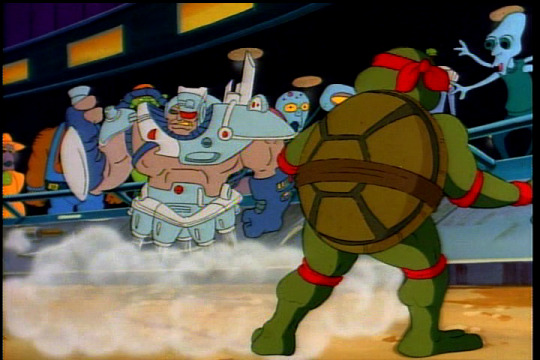
The Turtles having to fight their way into the Technodrome (and back out again) somehow never fully lost its allure. This one and "Shredder's Mom" both rank highly in my estimation, and while this is the less visually impressive of the two I think it wins out for how willing it is to mix things up, sending the Channel 6 regulars to Dimension X while two of the Turtles remain behind. Wild, far flung adventures that tap into the more sci-fi aspects of TMNT, and the cherry on top is that this is easily Vernon's best episode - it turns out he's more interesting as April's rival when he's doing well and she has to work to regain the upper hand.
4. THE NINJA SWORD OF NOWHERE

This one gets few points for innovation - Shredder and his crew jostling with the Turtles for control of some ancient magical artifact or high-tech invention is standard stuff for season three, and in this case, it's a dimension-hopping ninja sword. But rarely, if ever, has it been done this well. Splinter and Shredder battling in dimensional limbo is great, and the animation team handling this one really went above and beyond. Ninja Sword of Nowhere almost feels like it should have been held up as a textbook example of what a Turtles episode circa 1989/90 should be, a reference point that could be shown to writers or animators for what the show should be trying to acheive.
3. SPLINTER VANISHES

The intended 100th episode, even if it didn't turn out that way, and one that I remember feeling like a big deal while watching it as a kid that still held up upon revisiting it as an adult. I always know it's a really good ep when writing the entry for it takes hours as I agonise over it, trying to make sure I articulate everything I want to get across to the best of my ability, and I remember dwelling on this one for a looong time, thinking about how the story compels the Turtles - and us - to consider what happens when the adventures end, when it's time to grow up and move on. Probably the most emotionally resonant episode of TMNT '87, and even though Splinter does not come across well by the end of it, the journeys we go on with each of the Turtles as they explore their post-hero lives easily outweigh that. The fact that "Splinter Vanishes" accomplishes all of this and is a non-Shredder episode - when let's face it, they're more often than not filler shows - makes it all the more remarkable.
2. SHREDDER TRIUMPHANT!
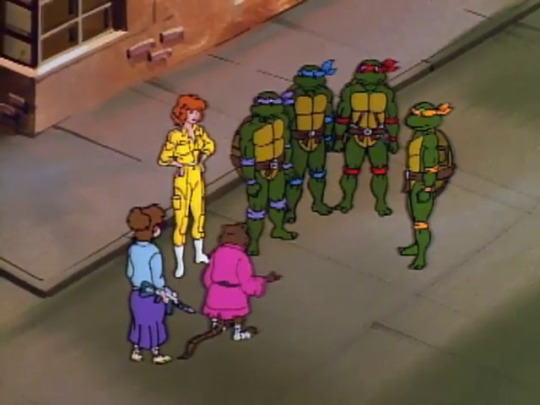
I have mixed feelings about the show continuing into the Red Sky era because this episode, the season seven finale, felt like it had brought TMNT '87 to its natural end point. I love how it plays upon the sense that the Turtles (and the viewers) have that they've seen and done this all a million times before, and it quickly becomes apparent that this time things are different, that finally Shredder and Krang are competent and have learned from all their previous losses, setting the stage for one final showdown. All the main characters - the Turtles, Splinter, the Technodrome regulars and the Channel 6 crew - get their chance to shine and show how they've grown over the course of the show's run. A milestone episode for sure.
1. TURTLES ON TRIAL
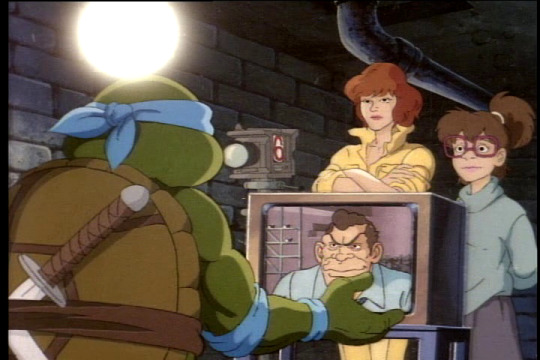
I think for me this is still The One, the single episode outside of the first season that I'd consider peak TMNT. It's also the first episode I remember seeing on TV, which I think set me up to have entirely unrealistic expectations about how good Turtles would be; fortunately the rest of the run was still a good time even if we never quite got here again.
I like to see my heroes really have to go through the wringer, to have everything thrown at them and somehow just about make it out victorious, and so the environment we see the Turtles forced to contend with here, a city full of people who have been conditioned to be actively hostile towards them, while they're also dealing with the usual Shredder/Krang stuff, makes for compelling television. Yes, Clayton Kellerman and "On Trial" are a perfect encapsuation of the media landscape at the time - which still feels relevant today - but on top of that this is a gorgeous episode with some terrific battles between the Turtles and Shredder's bunch. It's simply the bee's knees. (Or should that be the turtle's knees?)
#teenage mutant ninja turtles#tmnt#turtlethon#tmnt 1987#I really wanted to put The Big Blow-Out on here because it felt like such a huge deal at the time but visually that one is a MESS
9 notes
·
View notes
Note
There was also a mention of a "Gold Trumpet tower" building you mentioned in "Dontatello Trashes Slash", implying there may be a "Trumpet" businessman, to join McDonald Crump, Donald J. Lofty, Fenton Q. Hackenbrush and AJ Howard.
PS: Let me know if you have my other asks and are working on answering them or aren't interested?
Apologies for the delay, I've been overwhelmed with other projects and will have to be selective about what I can answer at the moment - and some questions I just honestly don't have a good answer for, but let me have a stab at this one!
We discussed in the past how the show would be improved by consolidating all the under-developed gangster and mad scientist characters into just one of each archetype, and I think you could do the same for a lot of these guys. It's the kind of thing that, if more time had been spent developing the world around the Turtles early on, there really would have been a case for, but as I've written about previously there was clearly a feeling that the show has to keep focus on the Turtles themselves at all times, and on the action unfolding in the present moment. Outside of the Channel 6 crew (and even that's being generous), TMNT '87 really isn't interested in doing anything in the long term with anyone outside of the dozen or so main recurring characters. At least not until the Red Sky years, when there seems to have been a recognition that the show's audience was getting older and the storytelling needed to age up with them.
With that said, I think if the show's approach had been more like S8 from the outset, you could have one character who fills this Trump expy role throughout, who's responsible for a lot of the big, often regrettable business developments the Turtles encounter over the course of the series. I'm conflicted as to whether the portrayal of such a character leans towards wealthy doofus (like Crump or Lofty) or the actively hostile business mogul (Howard) - maybe they begin like the former and are gradually revealed to be more like the latter, as the Turtles invariably happen to be on the scene trying to save the day whenever their assorted business blunders are unfolding.
#Turtlethon#I hear not-Trump is also calling out that April O' Neil and the failing Channel 6 news#Channel 6 also gets a lot of phone calls from someone called “John Barron”
2 notes
·
View notes
Text
Reflections & The Road Ahead

ABOVE: The Turtles make a promotional appearance in the UK, circa 1990. These puffy versions of the green teens showed up on TV and in the press often during Turtlemania, and resemble the characters as they were depicted on licensed Hero Turtles items during that era.
I’m old enough at this point to feel comfortable in saying that life is full of periods of awkward re-adjustment, where the world moves around you and it can take a while to find your bearings. You go to school for years and it feels like it’ll never end, then one day you’re just... done. A day job that perhaps you feel like you’ll be doing until you reach old age and keel over abruptly ends for whatever reason, and suddenly your routine is gone, leaving you wondering what to do with yourself.
Years ago, on a whim, I made the decision to re-watch the 1987 Teenage Mutant Ninja Turtles cartoon from the beginning and live-tweet about it over on the birdsite. Things were stop-start in the beginning, but at some point during the pandemic the project began gathering momentum. The threads got longer, my need to point out every weird little thing that happens in any given Turtles episode outgrowing the format of a Twitter thread. And so, almost exactly two years ago, Turtlethon made the jump to Tumblr, and in short order the format for each entry began to take shape: a beat-for-beat walk through a single episode of TMNT, complete with screengrabs and the occasional video clip, and an analysis of why that particular adventure does (or doesn’t) land, typically 2,000 words in length, longer still if it’s really good – or exceptionally bad.
In time, we settled into a routine: two new entries would appear every week, on Tuesdays and Thursdays. Sticking with that turned out to be an undertaking that I vastly underestimated the scope of early on, and there were times where the obligation to write about, screencap, edit and post about Turtles became exhausting, but I didn’t want this to be a project I abandoned halfway through. It was of the utmost importance to me to persevere, to get to the end no matter what.


Now that day has been and gone. We watched Splinter hurriedly declare the Turtles to be his equals, the credits rolled, and honestly it was all underwhelming. Upon further reflection, there’s no doubt there was more story to be told – there's no way Mung angrily telling Dregg he’d gone mad was the intended payoff to him getting pushed around all season – and presumably that’s something we would’ve seen followed up on had the show returned in 1997. But that’s not the world we live in, and so instead, we have to assess Teenage Mutant Ninja Turtles as it is: the 192 (or 193) adventures that were broadcast, which we can now observe as one overarching body of work. And I guess now all that’s left to ask is... what even was TMNT ‘87? Beyond the obvious and most cynical analysis – that it was initially an effort to promote a line of action figures, before becoming the heart of the Turtles business empire in its own right – what, if anything, was the series about? What was it trying to communicate to those of us who grew up watching it?
Peel away that initial "toy cartoon" layer of interpretation, and the next observation is perhaps only slightly less world-weary: it’s about communicating the idea that the Turtles are cool, to create adventures that will be compelling to kids, ensure they keep coming back and hopefully convince them to explore the other facets of the franchise too. Early on, the show was successful in these respects commercially, but from a creative standpoint it took a while to find its feet. Through the first three years the Turtles were first and foremost a unit, rarely getting to venture beyond their respective descriptions in the theme song. Leonardo leads, Donatello does machines, Raphael is... not exactly rude but certainly quippy, and Michaelangelo is indeed a party dude, whose pizza fixation sometimes appears to reach “this guy genuinely has a problem” territory. (It’s remarkable how integral pizza is to the first seven seasons of the show, only for it to be abandoned completely in the Red Sky era: I’m sure there must have been a strict “NO PIZZA” edict handed down from S8 onward that explains why the series ended on an ill-fitting popcorn gag instead.) One of the common themes explored in the Turtlethon entries for the golden era episodes is that Shredder, Krang, Rocksteady & Bebop make the show work comedically in the early goings, in part because they’re allowed to be flawed and vulnerable: meanwhile the Turtles are constrained by that need to be super cool dudes, the world’s most fearsome fighting team.
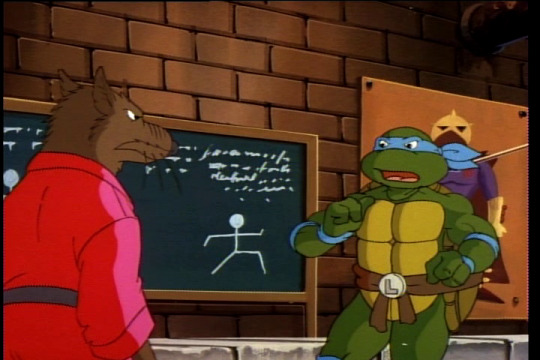
With the success of the show assured around season four, we finally begin to see a willingness to explore who the Turtles are beyond those base traits conveyed in the theme song. I’d argue that in this incarnation of the series, Leonardo is the member of the group whose personality adheres closest to what the team were when originally conceived for the Mirage comic: he’s a ninja first and foremost, even memorably declaring his intent to finish off Shredder in the first season. Season three’s “Take Me to Your Leader” explores how the burden of leadership weighs upon him but it’s the following year where he’s fully rounded out, the pros and cons of his overbearing strictness explored in “Leonardo Lightens Up”, while his competitive nature turns compulsive in “Leonardo Versus Tempestra”. More than anything, his role is to serve as an anchor, ensuring TMNT stays somewhere in the neighbourhood of being an action-adventure cartoon and doesn’t float off into complete tomfoolery.

Raphael is the inverse of Leonardo, encompassing everything that makes the Fred Wolf TMNT what it is – for better or worse. He’s the goofball, the one typically given the task of breaking the fourth wall, and if anything is actively pushing against what Leo is here to achieve. With his incessant zingers, Raph is the embodiment of everything that purists who resent the show for not being a faithful recreation of the Mirage comic dislike about it, a situation exacerbated by the fact that the 1987 cartoon version of the character is such an outlier, eschewing the angry, brooding depiction of him seen almost everywhere else. This idea that there’s something inauthentic about Fred Wolf Raph is so pervasive that modern media and merchandise based around the MWS show often skews towards making him “the angry one” instead of the wise guy. It’s an unfortunate bit of revisionist history that loses sight of the fact that 1987 Raph is wildly popular, perhaps now more than ever. The fans who like him really like his witty retorts, outings such as his memorable romance with Mona Lisa, and the entertaining performances from Rob Paulsen that brought him to life. His value is in keeping things light, and in doing so he differentiates TMNT from the earnest action cartoons that preceded it.
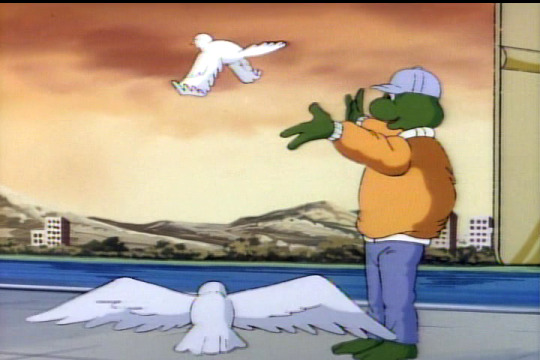
Okay, but if Raph is the fun one, where does that leave Michaelangelo? I’d argue that his depiction as the team’s “party dude” is merely window-dressing, a means to convey what makes him marketable but which doesn’t really get at what makes him tick, in part because as alluded to above, in the early days of the show none of this stuff had been thought out. Anyone watching seasons one, two and much of season three would be forgiven for seeing him as one-dimensional, the cowabunga guy. Pizza, pizza, pizza. Dude, dude, dude. These aspects of him can be... grating, to be certain, when watching the series as an adult. Eventually we start to occasionally see beyond this. There’s a sense that Mikey is the youngest member of the team, even if there’s nothing in the show itself directly confirming this: by extension he’s the most innocent, sensitive, and personable member of the group, the one who’d be most likely to befriend you and invite you into the Lair if you were to encounter him, rather than viewing you as a threat. Michaelangelo is both the most “human” Turtle and the one who displays the greatest longing to live as a human, something seen in episodes such as season three’s “The Gang’s All Here” and the following year’s “Poor Little Rich Turtle”. When it comes down to it, Mikey’s character is easy-going but more importantly, he’s kind. There’s an irony in him being the one whose weapons had to be excised from the show entirely, though if anything I think that only gave him a little renegade appeal over and above even the other Turtles.
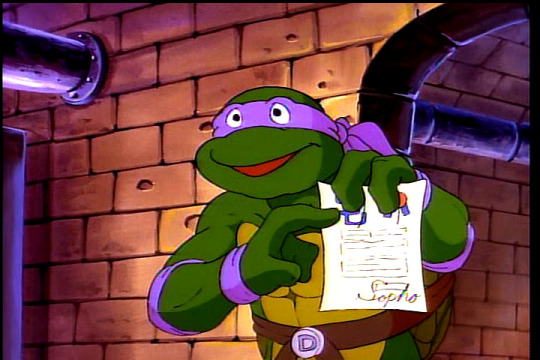
Donatello has always been my favourite Turtle, and not just for aesthetic reasons as “the purple one”: coming in from Ghostbusters as many of us did back in the day, I think it’s natural that if you were on Team Egon, you were likely to be Team Donnie, too. He's the most creative Turtle and arguably the most introspective, two qualities that also make me gravitate towards him. Putting my biases aside, he’s by far the most necessary member of the team for the series to work: his intelligence and ingenuity seem to almost always play into the climax of any episode as the Turtles scramble to stop whatever enormous threat is facing the city, and without him it’s inarguable that Leo, Mikey and Raph would have been majorly screwed countless times over the course of the show’s run. Around the mid-point of the series his accomplishments seem to go to his head, and his abilities make him vastly overpowered relative to the other Turtles. Despite this, Donnie remains the big purple cog that keeps TMNT ticking.
The show upholds its four main characters above everything, even in situations where this becomes detrimental, and this goes hand in hand with a focus on immediacy: what anyone else is doing isn’t a concern unless it will impact the Turtles somehow, and nothing that’s happened to anyone in the past matters unless if affects the team in the present moment. There’s an unspoken anxiety at work in TMNT that runs throughout the series, apparent even at its height: a fear that if the Turtles aren’t front and centre, chasing the macguffin of the day, then young viewers will grow bored and switch off.

These considerations are apparent in the series from the outset, affecting even the origin of the Turtles themselves, who in this continuity go from pet turtles to their established forms in the space of seconds: they’re not allowed to grow into their teenage selves over the course of years for the same reason that only the most barebones information is conveyed to us about the Hamato Yoshi / Oroku Saki feud that led to their creation. This show isn’t about getting caught up in the details, it’s about the Turtles existing in the present moment.
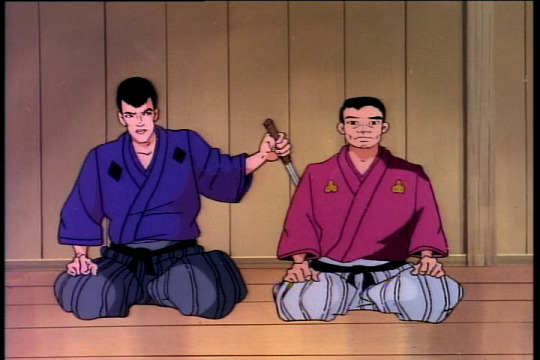
Yoshi and Saki’s ongoing rivalry is one of the most fascinating aspects of the entire series, and yet one barely explored because the show only cares about the elements of it directly relevant to the Turtles. At some unspecified point in the past Saki framed Yoshi and took control of the Foot Clan because... he was just naturally power-hungry and evil, I guess (later we learned that his mother was also villainous, so there might be something to that). There’s a huge chunk of the timeline which takes place after this of which we know little, covering Yoshi presumably stowing away on a boat and beginning a new life as a penniless refugee living in the sewers of New York. By all rights the story should end here, with Saki having vanquished his enemy and now ruling over his own turf as the head of a criminal organisation in Japan, but his inability to let go keeps things rolling: at some point he follows Yoshi to America, sets up an elaborate network to spy on him, and in a botched attempt to kill his enemy inadvertently mutates the four heroes who will ultimately be his undoing: Leonardo, Michaelangelo, Donatello and Raphael.
Oh, and along the way Saki happened to run into a disembodied alien warlord brain from Dimension X who had himself been on Earth for an unspecified amount of time, the two bad guys forming an alliance to achieve world domination. None of these events unfold on-screen as the Turtles weren’t involved: instead, Shredder and Krang arrive fully formed, how they met and the circumstances that led to them working together are deemed unimportant. Similarly, Splinter is a wise old man whose exact age is unclear, capable of applying mystical ninja abilities that vary depending on what the plot of the day requires.
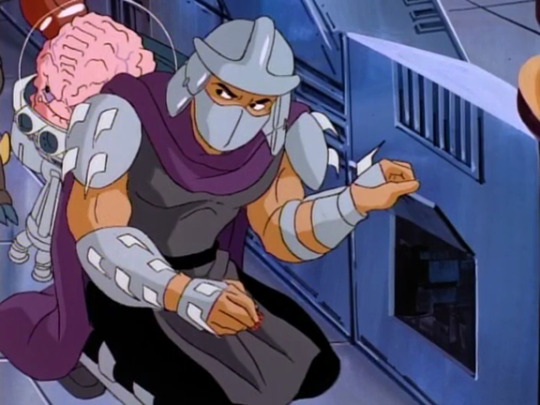
Given how scant the details of Splinter and Shredder’s feud were, it should perhaps come as no surprise that in the end, it was never resolved in any satisfactory fashion. By the end of the series Shredder and Krang were banished to another dimension by the Turtles for the umpteenth time, but the power struggle between Splinter and Shreds over the leadership of the Foot Clan that kicked all of this off doesn’t receive any closure; to make matters worse the final three appearances of Shredder and Krang tease the idea of them becoming... well maybe not good guys, but at the very least neutral figures having been overshadowed in the evil stakes by Dregg. I think by season ten, the viewers would have been ready for that: to have Shredder and Krang perform a heroic act to stop Dregg that definitively concludes their run on the show as villains, then let them ride off into the sunset. If we’re to assume there were plans for a twelfth season, there’s no reason that Karai or another villain new to the series couldn’t take their place.
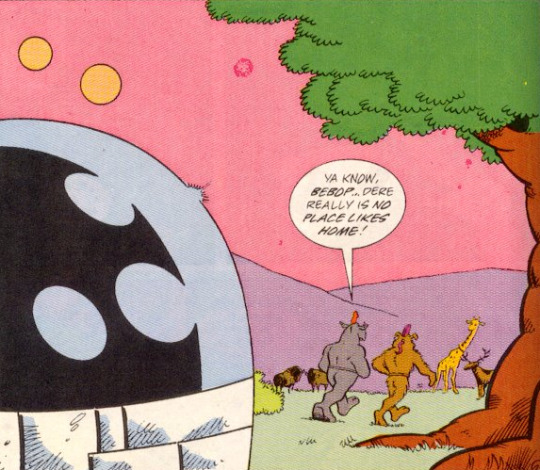
I’m going to skip over writing about Bebop and Rocksteady here as this post is long enough as it is, and I covered their contribution to the series in the entry for “Turtle Trek”. The only thing I would add is that if anyone was truly deserving of that elusive redemption arc and/or a happy ending, it was them: this is one of the areas where the Archie TMNT comic got it right, the idea of them living peacefully on the animal-friendly Eden Worlds providing an opportunity to for the duo to move on.
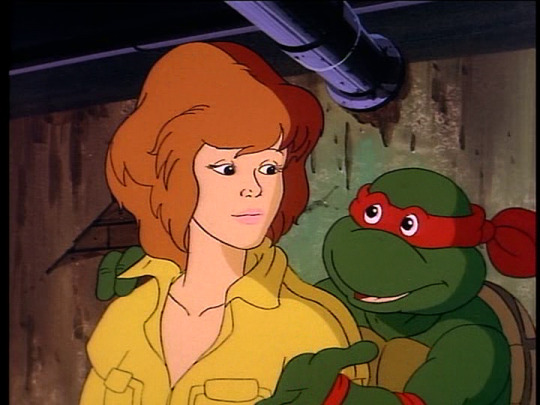
April is perhaps the most important character in the show other than the Turtles: there are plenty of episodes in the first seven years of TMNT that don’t feature Splinter, Shredder or Krang but none prior to “The Legend of Koji” that don’t incorporate her into the adventure in some capacity. She's interesting to view through a feminist lens: for a character who first appeared on TV in 1987 in a cartoon primarily marketed towards boys, not only is she integral to the proceedings but from the outset she’s her own person, a (somewhat) established career woman who just happens to cross paths with the Turtles and strike up a friendship with them. Because of that need to keep the focus on the green teens we never get to see her grow much beyond this – she likes the Turtles, she likes getting to cover anything that will make for a Great Story™, but that’s as far as it goes. There are a few rare occasions where the show will toy with having a male guest character serve as a potential love interest for her, but it’s not central to what she’s about. First and foremost, April cares about journalism and about sticking up for her friends, the Turtles, and for a cartoon from 35 years ago it’s kind of refreshing that’s she’s allowed to maintain that focus.
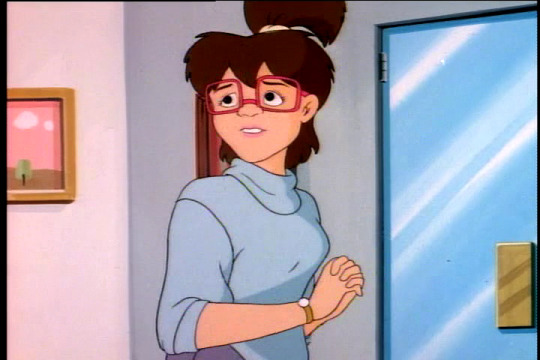
Irma’s introduction to the series feels as if it was intended to play up April’s qualities by bringing in someone who in many ways is her opposite: there’s little indicator that Irma cares about her job or is any good at it in the early goings, and while April only makes occasional references to finding a partner throughout the series, Irma is obsessed. Her desire to find a man to sweep her off her feet in some paperback romance novel scenario is a constant theme throughout the first four years of the show, and I get the sense that part of the intended gag is that all of this would come easily to April if she wanted it, but for Irma – frequently inferred by the show to be frumpy or plain – such things remain perpetually out of reach.
When it comes to Turtles discourse there sometimes seems to be borderline hostility towards Irma, perhaps in part because she’s driven by a desire for those old traditions, but I think largely based on people focusing on her appearances in those first three seasons (the only ones people tend to pay attention to, especially outside of the fandom) and viewing her on a surface level: April, so the thinking goes, is glamorous and exciting, Irma is merely her gawky sidekick. I’ve consistently gone to bat for her throughout Turtlethon’s run precisely because The Struggle is Real: Irma exists, living and growing as a flawed human being alongside the successful, infallible April and her friends, the ever-valiant Turtles. She messes up, she fails, she frequently ends up being on the receiving end of pure bad luck but through it all she keeps going, persevering in the background while the focus remains on April and the Turtles. As the show continues, we start to see her maturation, both in terms of taking on different roles within Channel 6 and the downplaying of her man-hungry antics. By the end of season seven there’s a sense that Irma has grown into a fully capable person and shed her insecurities, culminating in her brief reinvention as an action heroine and her defeat of Krang(!) in “Shredder Triumphant!”
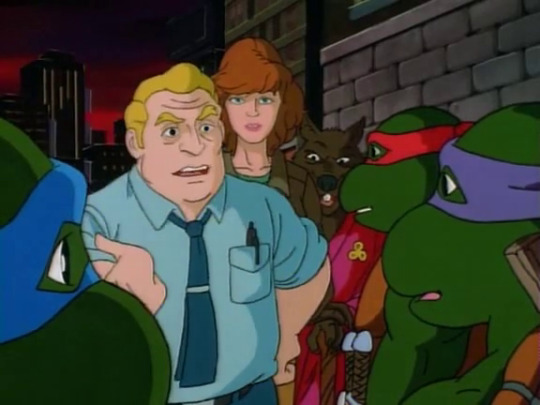
There’s an argument to be made that season seven should have been the end point of the series, or at least that years eight through ten ought to be viewed as merely a possible continuation, a look into how things could have continued rather than something set in stone. The truth is that aside from maybe Shredder, the core cast is served poorly by the Red Sky era: the Turtles come across as miserable throughout, April seems adrift after moving on from Channel 6, ultimately losing prominence following Carter’s introduction to the show, Bebop and Rocksteady are robbed of any semblance of personality and Irma only makes two appearances in season eight before being unceremoniously dropped entirely. I’ll freely admit that by the end of season nine, watching each episode for Turtlethon was becoming a deflating experience: by that point the spark was gone from the show, and seeing what it had become just felt sad. Happily, things improved a bit in S10, but I can’t shake the feeling that Shredder, Krang and The Boys riding off in the pick-up truck at the conclusion of season seven would have been the right time for the Turtles to bow out.
TMNT ‘87 was looked down upon from the outset by readers of the Mirage comic who saw it as sacrilege, a mockery of everything the source material was about, and once newer animated iterations came along that adhered more closely to Eastman & Laird’s vision the perception of the MWS version took an even greater hit. Ironically there are a bunch of disgruntled guys around my age – Xennials and the youngest Gen Xers – who will now swear blind that the ‘87 Turtles are the one true faith, and that any deviation from the way the team were depicted then is a disgrace. Click on any TMNT post on Instagram, especially the ones pertaining to Mutant Mayhem, and you’ll find these dudes in the comments pissing and moaning about how much better things were in their day, when the Turtles were real tough guys and manly men, which is an oddly rose-tinted perspective of a show where a significant portion of fights were won with a cream pie or pizza to the face. That’s the thing: at its heart, Turtles is a fun adventure show, one that over its run draws heavily upon martial arts tropes, sci-fi macguffin chases, aliens, monsters, dimension hopping and occasionally time travel: these concepts are all part of the DNA of the superhero comic book, and in that respect, the show is absolutely in the spirit of the Mirage comics which were themselves conceived as both a parody and a loving tribute to that artform.
That’s it. That’s what the point of the original Teenage Mutant Ninja Turtles show is: it’s a fun adventure cartoon that might not aesthetically resemble the Mirage comics, but it has an innate understanding of how to adapt the underlying concepts of those stories into a series that connects with its target audience.
One of my intended aims for Turtlethon, in pulling apart and analysing every episode of TMNT, has been to dispel two commonly held stances about the show that I see online all the time:
Teenage Mutant Ninja Turtles (1987) was never good.
Teenage Mutant Ninja Turtles (1987) was only good for the first five episodes, everything after that was terrible.
People who take the first stance are harder to reach. Some of them are from that group of Mirage readers who were around back in the day and still hold a grudge, but the majority of those who hold this opinion have a wider disdain for eighties cartoons in general. They dismiss the contributions of everyone who worked on these series entirely because they were all “thinly veiled toy commercials”: to them TMNT and every other show from that era are nothing but sound and fury, signifying nothing. I hope in my analysis I’ve shown how far this is from the truth: even the clunkiest episodes of Turtles occasionally have moments where the animators go above and beyond to create impressive sequences, and when the show was at the height of its popularity during seasons three and four these teams created a lot of television on a modest budget within a short timeframe. On the writing side, over the course of the series Turtles incorporates themes into its stories of environmentalism (including climate change and conservation), how sensationalist media and wealthy individuals in positions of power can cultivate hate movements against marginalised groups, and gentrification, to name just a couple of topics off the top of my head; an entire side season was also dedicated to having the Turtles travel around Europe to be exposed to its arts, history and culture. These efforts are a drop in the ocean compared to what the Archie Comics version of TMNT was doing during this period but are respectable, nonetheless.
The second position – that the show goes off the rails after “Shredder & Splintered” - is something you’ll hear from viewers who have perhaps purchased the first few seasons or the entire series on DVD and have started watching it, but they’re not engaged with the source material. If you’re only half-watching the show, if it’s background noise while you perform other tasks, then the visual drop-off from “Return of the Shredder” onward combined with the drudgery of the Eye of Sarnath arc might make you wonder if there’s any point in venturing further. Undoubtedly there are stretches of the series that tested even my patience: the ungainly syndicated adventures in season four, the bizarre, sometimes directionless Vacation in Europe arc, and pretty much all of season nine. There’s still great stuff in there, however: the second half of season two is far stronger than the first, season three is full of classics such as “Turtles on Trial”, “The Ninja Sword of Nowhere” and the concluding Big Trilogy, and seasons four through six have phemomenal adventures and character spotlight episode scattered throughout. Season seven – the proper season seven, not the vacation episodes – might be the strongest stretch of adventures in the entire series as TMNT regains its focus and attempts to mature in step with its original audience. There’s so much good stuff in Turtles if you stick with it, and I can’t see how anyone could watch the series in its entirety and come away thinking only season one has value unless your criteria for what makes a good cartoon comes down purely to looking cool and some vague aura of edginess.

ABOVE: A June 1990 TV Guide cover in which Ariel from The Little Mermaid mingles with Bart Simpson, Donnie, Leo and Raph. Yes, Bart is missing his ear, but also WHY DO THE TURTLES HAVE THREE TOES WHAT THE HELL
I hope that if you’ve never actually sat down and watched the 1987 version of TMNT from beginning to end that maybe the breakdowns of each adventure I’ve cobbled together for this blog will inspire you to do so, and that if you’ve seen the show before they’ll allow you to rewatch it with additional insight. More than anything, the goal of Turtlethon has been to point out why Turtles works, while also acknowledging the times when it doesn’t. It’s lost to history now, but there was a vanishingly brief window of time – pretty much just the entire calendar year of 1990 – where the ascendancy of Teenage Mutant Ninja Turtles in pop culture occurred in parallel to the rise of The Simpsons. The two series were linked by their indie comics origins and their anti-establishment appeal, however Simpsons was able to reinvent itself after the hype around Bart died down as one of the greatest TV series of all time by continuing to up its game and making Homer the central figure of the show. TMNT was never in a position to make that leap, hampered as it was by budgetary restraints, parental backlash and being more overtly targeted towards children, but as a body of work it still has value, and its longevity speaks to how strongly it resonated with viewers around the world. It is, in a word, tubuloso.
---
When Turtlethon was in its early stages, I gave some consideration to what series I might like to deep-dive afterwards. I reference Transformers all the time on this blog and it’s without a doubt my First Fandom, so there’s a natural inclination for me to want to go back and examine the 98 episodes of that show. Between that and TMNT, Ghostbusters was my second major fixation, and there’s a lot of The Real Ghostbusters to explore too.
The natural extension of our journey is to move on to Ninja Turtles: The Next Mutation, but I honestly doubt it would be fun for me to write or for you to read. I dunno, maybe you want to see me rip it to shreds, but I'm unsure how much financial compensation I’d need to make up for the psychic damage that would inevitably be incurred. (The tip jar is there, if you’re so inclined; let’s just say that Yale could use an international airport.) Moving on to the 2003 version of TMNT would be much more fun, but also a tremendous undertaking that - for now - I don't want to approach. After years of writing about the Turtles, I’m exhausted. I’m also acutely aware that while Turtlethon has been beneficial for me in many ways as a writer – it's allowed me to refine my skills, to learn how to create and maintain a regular schedule, and made me a more effective editor, even if you’d never know it from the length of my posts – the time I’ve devoted to writing about the Turtles would have been better spent working on my own comic series, Corinne Morgan, Corbie, which has been on hiatus throughout the life of this blog.
[SIDE NOTE: If you want to see me put my money where my mouth is, and if I’ve learned anything through analysing Turtles, read Corbie when the new edition of issue #1 comes out in a few weeks. Its influences are more rooted in the Archie version of TMNT than the MWS series, but if you like cute, light-hearted and socially conscious superhero adventures then I think you’ll soon become a dedicated flocker.]
I’ve undoubtedly been teetering on the edge of burnout lately, and my workload has been further encumbered by the technical changes implemented by Tumblr that negatively affected the last two seasons’ worth of Turtlethon entries. Behind the scenes, I’ve gradually been making moves to port the blog in its entirety to a stand-alone website where all 193 entries can be enjoyed in the original format. The thinking is that this will allow me to also write about anything else that takes my interest, post my art and generally keep you up to date on the status of all my assorted ongoing projects. With that in mind, I’d like to introduce you to Portertronic, which is now live. The Turtlethon entries for the first two seasons of TMNT have been posted there already, with the rest of the series to follow in the weeks and months ahead.
This isn’t the end, for Turtlethon or for this account: you’ll still see new TMNT posts from me here, as I have a laundry list of one-off bits and pieces related to the series I still want to explore. The plan is that new content moving forward will be made available first to Patreon and Ko-Fi supporters, then appear on Portertronic, and eventually get posted here too. To kick things off, there’s a pair of upcoming Turtles-related CDs I’ll be looking at as part of a crossover event to introduce Excess Volume, a sub-blog that will cover pop music of the 1980s and early 1990s. I’m not going away, just getting off the treadmill I’ve been on for the last couple of years, and trying to refocus on writing shorter bursts of material while I return to working primarily on Corbie.
Turtlethon has always had a modest following – there are only so many people in the world who are interested in reading long-form analysis of a decades-old cartoon – but going into it I had zero expectations that anyone would connect with it at all. I’ve never lost sight of the fact that in real life, if a classroom’s worth of people were willing to listen to me talk at length about the Teenage Mutant Ninja Turtles twice a week that would be incredibly edifying, and over time the readership grew to roughly double that. It probably should have been a YouTube channel from the beginning, but the thought of continually being struck down by DMCAs from Lionsgate ensured that was a non-starter, and perhaps that would have defeated the purpose. I like to draw, and I like to write – obviously! That you’ve indulged me in doing the latter and gushing about the Turtles for the last few years means a lot, and I hope you’ll join me – either through Corbie, over on Portertronic or here on Turtlethon – for the adventures still to come.
#Turtlethon#teenage mutant ninja turtles#TMNT#TMNT 1987#Ninja Turtles#I have always liked... cowabunga
13 notes
·
View notes
Note
I was thinking instead of all the minor mobster characters, a better TMNT 1987 could make them all these mafioso, Don Turteli, promoted to regular. Don Turteli would eventually get turned into a turtle mutant, thus coinciding with Playmates releasing an action figure of Turteli.
Do you think that'd work better? I'm trying to think of something for the generic mad scientists too?
I think that if you had a smaller pool of writers during seasons three through five working on fewer episodes, with a stronger focus on coherent storytelling, then yeah, you could absolutely consolidate all of TMNT's mobsters into one, and Turtelli feels like the obvious candidate. You could mutate him into a villainous gangster Turtle, either from the outset or later on. Certainly that kind of character would be more marketable, more appealing to kids, more likely to work as a potential toy in the Playmates line, all that fun stuff. But the key thing is that he would need to be presented as a true threat to the Turtles, ideally in a way that would differentiate him from Shredder and which would be compelling.
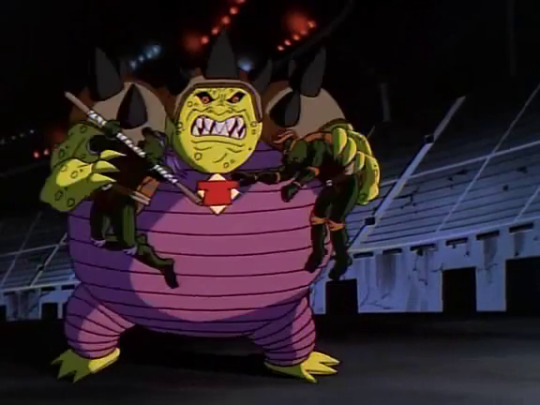
There are a few characters throughout the show's run who are able to apply pressure and challenge the Turtles in ways different to Shredder, but they tend to be guys with some kind of money or institutional power (think AJ Howard or J. Gordon Hungerdunger, who each have money/clout but who aren't much to look at, and who I doubt would shift many units as action figures). IMO, the best example of what could be done in terms of introducing a second big bad is actually from the much maligned Red Sky era, and it's Titanus. Here we have a guy who ticks all the boxes: an actual crime boss, in this case from a far-off future, who commands a group of generally interesting mutants, has a compelling look that works when placed next to other characters in TMNT, who can go toe-to-toe with the Turtles but also has clout via his H.A.V.O.C. group. If we're talking about just having one strong recurring mutant villain in the show from S3 onwards, someone who isn't Shredder but could be almost as compelling, I think Titanus is the blueprint, it'd just be a case of implementing something like that several years earlier.
#teenage mutant ninja turtles#tmnt#tmnt 1987#turtlethon#J. Gordon Hungerdunger is extremely fun to say
4 notes
·
View notes
Text
“Divide and Conquer”
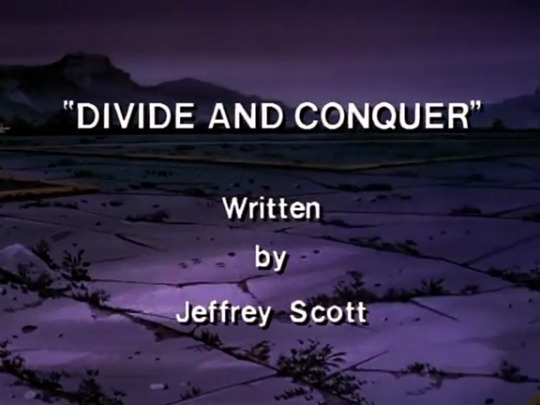
Season 10, Episode 8 First US Airdate: November 2, 1996
Lord Dregg absorbs the powers of a group of alien warriors as he prepares for a final encounter with the Turtles.
After ten seasons, Teenage Mutant Ninja Turtles reaches its final episode, “Divide and Conquer”. Jeffrey Scott is credited as writer for this milestone adventure.

The Turtles battle a plasma blaster-wielding alien near an airport, who has one eye on a stopwatch the entire time. Michaelangelo takes out the bad guy by piloting an old airplane; when Leonardo confronts this mysterious attacker and demands to know his intentions, he snatches the team leader’s belt and teleports away. Talking amongst themselves, the Turtles note that this is the sixth time in the space of a week that a foe has appeared out of nowhere and then vanished again, with Michaelangelo’s grappling hook getting nabbed in one of the previous encounters.

We go from an airport to a spaceport/cantina, where it’s revealed that Lord Dregg survived the destruction of the Dreggnaught in the previous episode and is challenging assorted alien lowlifes to defeat the Turtles within 90 seconds, promising power and wealth to whoever can pull it off. Back on Earth, the Turtles head home in their van, still trying to figure out the story behind the assorted bad guys who’ve been popping up lately. Michaelangelo discovers a tracking device which had been placed within his shell, and hurls it out the window, but it’s too late to stop their next challenger from materialising in the back of the vehicle: a blue-skinned, four-armed woman who shape-shifts into a rhino-like alien as the Turtle Van is sent flying off a cliff. The vehicle lands safely thanks to an in-built parachute, but not before the invader snatches Donatello’s bo staff, disappearing seconds later. Confused as to why their opponent would flee when she had the upper hand, the Turtles note that the tracking device resembled Dregg’s microbots. Back at the spaceport, Dregg selects five aliens, including the two who most recently clashed with the Turtles, to participate in his next scheme.

Still trying to figure out what’s going on, the Turtles reach April to ask if she’s heard of any unusual alien activity recently. We’ve touched upon our ace reporter’s apparent Internet addiction throughout this season already, but I think it’s also worth noting how odd it is that she sits in her home at night, working in her office, and wears her new jacket the entire time when she isn’t going anywhere; I guess it’s too late in the day to justify the creation of an alternate indoor attire for her now. Back in the Lair, Donatello tracks the transporter energy from which the assorted aliens have been appearing back to the black hole Dregg had been sent into. Convinced that they’ve overheard an intruder nearby, the Turtles sneak out of the workshop only for Leonardo to almost end up thumping Splinter – somehow, they managed to forget that he lives in the Lair, too. The team are encouraged by their sensei to join him in meditation to calm their nerves.

Mung oversees the breeding of new swarms of microbots when Lord Dregg arrives, demanding a cannister of the robots to use in his Scheme of the Day. The underling points out that they’ll require all the microbots for the creation of their invasion force, and is sort of half-assedly knocked to the ground for what Dregg views as insubordination. Dregg launches into a tirade about how he doesn’t care about timetables and had nearly defeated the Turtles when he “had the power of Shredder and Krang”. (There’s a little bit of revisionist history going on there on Dregg’s part, as of the two of them he only managed to absorb Krang's abilities.) Now obsessed with gaining revenge against the Turtles above even his desires for galactic domination, Dregg declares he needs “something special” to finish off his enemies once and for all. When Mung points out in the politest and most conciliatory way possible that this is misguided, Dregg unleashes his laser eye beams to punish his flunky, missing him and instead hitting a tank full of microbots. Scooping up a handful of the tiny robots, Dregg places them in a cannister and makes his exit. For the first time, Mung is clearly furious, yelling at his departing master that he’s “gone mad”. Teleporting aboard the Dreggnaught – which was seemingly destroyed for a second time at the end of the last episode, so presumably this is the third version of the ship – Dregg sets the microbots to work, enacting the next stage of his plan.
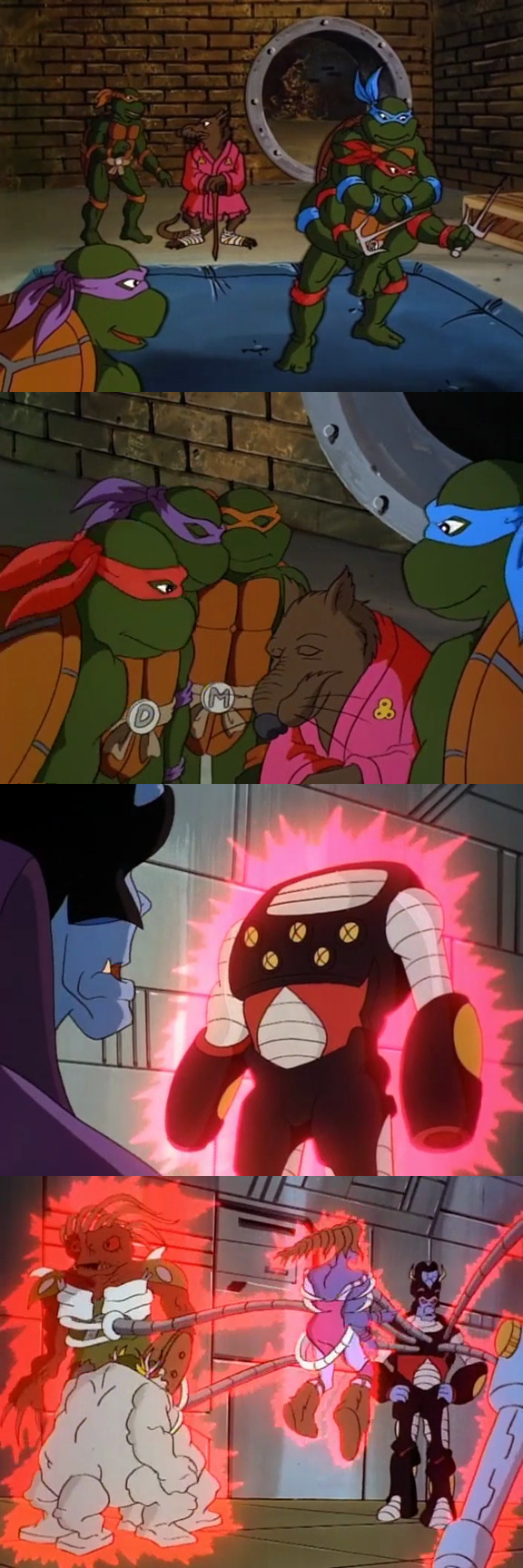
In the Lair, Splinter oversees a training session for the Turtles, during which it’s revealed he’s taught them a new move in which they leap onto the back of their enemy, restraining them from behind. The team are told that if they perform the Flying Claw well, they won’t need to learn any further attacks. Back on his ship, Dregg watches as the microbots complete the creation of the morphogenesis exoskeleton, a suit which he dons before using it to absorb the five alien warriors he recruited. Ready for his final battle with the Turtles, Dregg prepares to teleport to Earth.
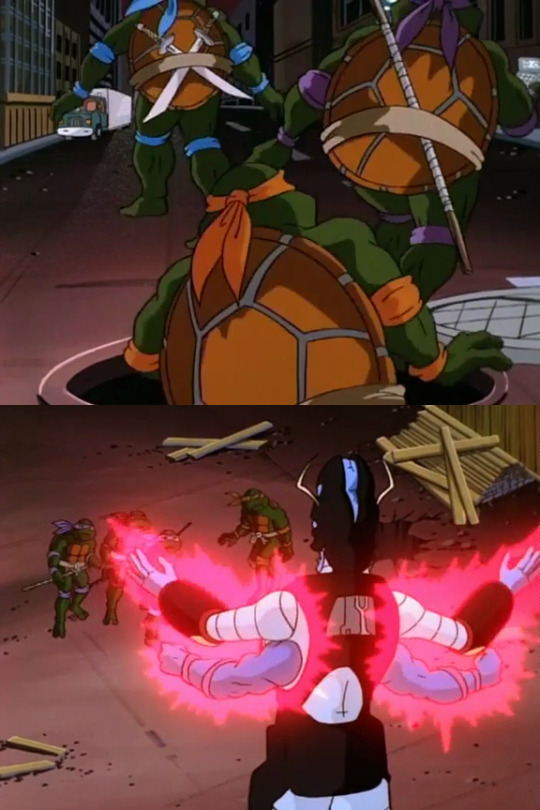
It doesn’t take long for the Turtles to pick up on the transporter activity. Heading up to the surface, they confront Dregg in a construction site in his new get-up. The team assume their old enemy must have arrived with a group of his underlings, but soon discover he doesn’t need troops now as he uses the exoskeleton to become a giant who towers over them. Dregg announces that the warriors that had been sent to dispose of the Turtles were the most powerful in the galaxy; now, having absorbed them, he’s become an enemy that the green teens will never be able to defeat.

The Turtles work together to turn Dregg’s new abilities against him, wrapping one of his arms – which has transformed into a lengthy chain - around one of the construction site’s girders. This doesn’t work for long as Dregg is simply too powerful, and is able to bring down the entire structure. The Turtles run for cover but again, Dregg has an answer for this, turning himself in an enormous ball and hurtling down the street after them. Dregg uses x-ray vision to pursue our heroes as they escape into the sewers, dropping a robotic arm through the ground and briefly pinning Michaelangelo. The Turtles escape into the lower drains of the sewers, flooding in the area above them as they leave to slow their foe down; a resulting surge of water knocks the warlord into the air.
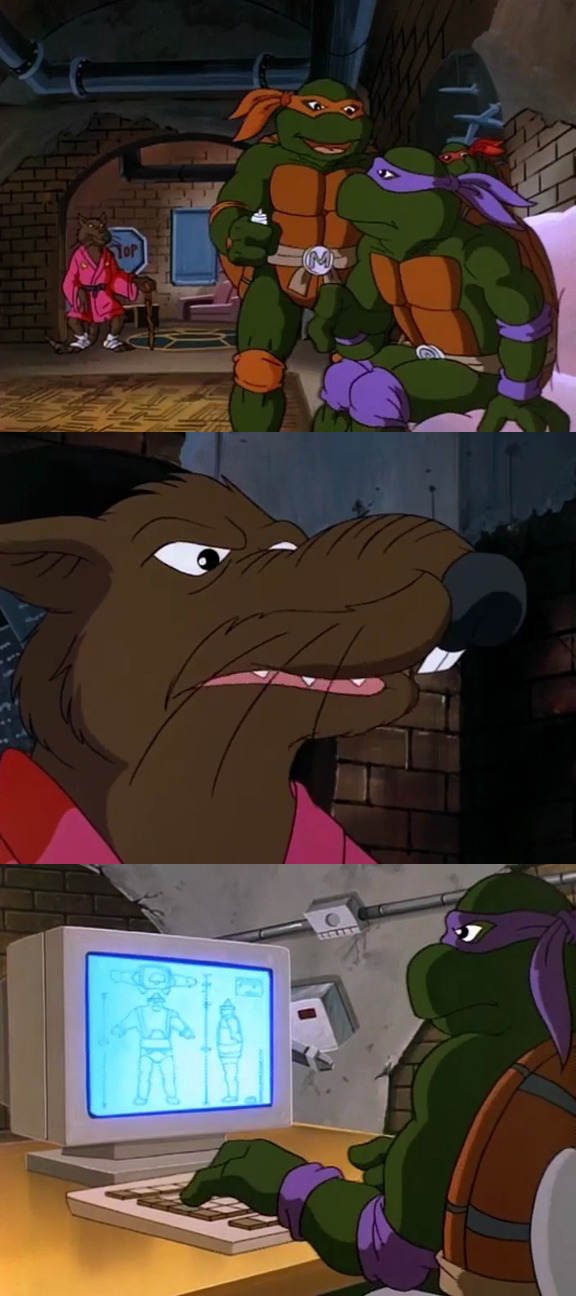
Returning to the Lair, the Turtles tend to their accumulated injuries. Splinter suggests to the team that “when the hermit crab wants to impress its enemies, it gets a bigger shell”. This gives Donatello an idea, as he rushes to his workshop to bring up the schematics for Krang’s android body on his desktop PC. As you may recall, Krang’s duds had the ability to grow to giant-size, something showcased most memorably in “Shredder & Splintered” but also later in season six’s “Krangenstein Lives”. To get what they need, the Turtles will need to travel to Dimension X and retrieve it from the Technodrome, a risky prospect given that the team had written off the idea of ever using Donatello’s dimensional portal again at the conclusion of the previous episode.

April’s Internet addiction leads to her having a hallucinatory episode, as she sees the vision of Lord Dregg’s face appear on her monitor. Okay, that’s not technically true: this is the real Dregg, who emerges from the screen to take shape in her apartment in his new super-sized form. The villain sends a transmission to the Turtles over their communications systems, threatening to send the captive April to “the labour mines of Dimension X” if they don’t show up to rescue her. The Turtles opt to split up, with Leonardo and Raphael setting out to save April while Donatello and Michaelangelo head through the portal.
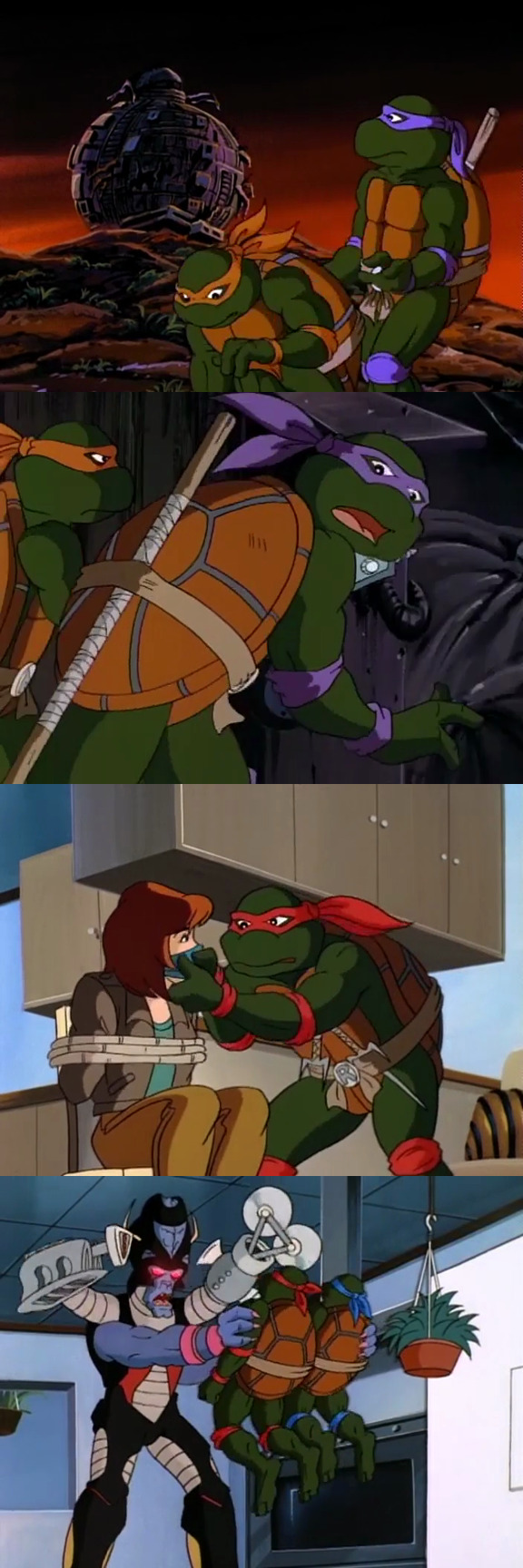
In a nice touch, the old Technodrome theme music returns as Donnie and Mikey approach the now dilapidated fortress. The Turtles make their way inside, unaware that they’re being watched. Back on Earth, Raph and Leo free April but are manhandled by Dregg, who threatens to finish them off with his integrated weaponry as we head into commercials.
Okay, here we go – the concluding act of the last ever episode!

Dregg gives the captive Turtles the choice of being killed by a liquid nitrogen ray or his carbine shredder, and while there’s perhaps something fitting about idea of the Turtles meeting their maker in the last episode at the hands of a shredder, that’s not how things play out. Instead, Leo and Raph use their surroundings to their advantage, dropping furniture onto Dregg and sending him crashing through the floor, marking yet another time that the Turtles have inadvertently destroyed April’s home and demonstrated zero remorse. Our heroes leave with April in the van, but Dregg remains undeterred. He bursts out the side of the building and – I shit you not – becomes MOTORCYCLE DREGG, popping a wheelie before speeding off to pursue the Turtles as I stop what I’m doing to try and contain my laughter one final time.

In the Technodrome, Donatello and Michaelangelo uncover Krang’s android body, but there’s definitely something off about it: for one thing, since when did it have fangs? Before the duo can retrieve it, the alien brain’s old suit reveals itself to be a shapeshifting creature that springs to life, opening its mouth to expose a forked tongue and going on the attack. From the sidelines emerge a group of creepy cyborg-like beings who the two Turtles fight off before finding the real android body under a pile of scrap metal.

Motorcycle Dregg chases the Turtle Van into a scrapyard, where it soon becomes trapped in a crane by the villain and is set to be dropped into a trash compactor. Meanwhile Donnie and Mikey opt to use the Technodrome’s portal to return to New York rather than their own, but struggle to get the failing systems in the fortress operational while also fighting off the assorted enemies now hanging around the place. Mikey’s last “cowabunga” begins as he leaps into the portal with Donnie, and ends as he emerges in the scrapyard on the other side.
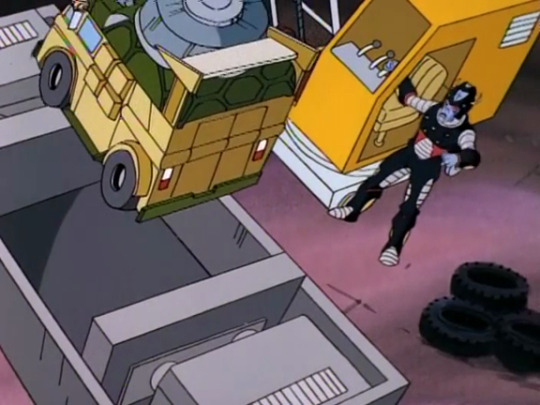
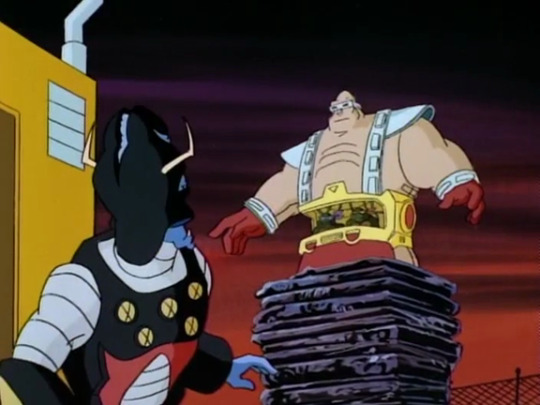

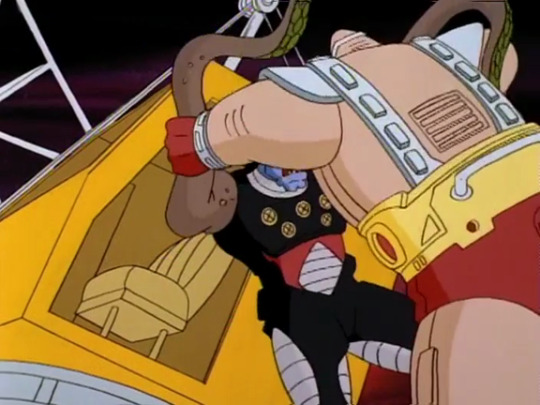
Leonardo, Raphael and April face the prospect of being squished by Dregg in the trash compactor when the now giant-sized android body appears on the horizon, piloted by Donatello and Michaelangelo in Krang’s place. Dregg uses his assorted powers to attack the android, leading Mikey to suggest they increase its size even further, but Donnie explains the bigger it becomes, the more rapidly it’ll collapse: as it is, they only have about one minute before Krang’s old suit shrinks to the size of a ping-pong ball and explodes, with the two Turtles inside it.
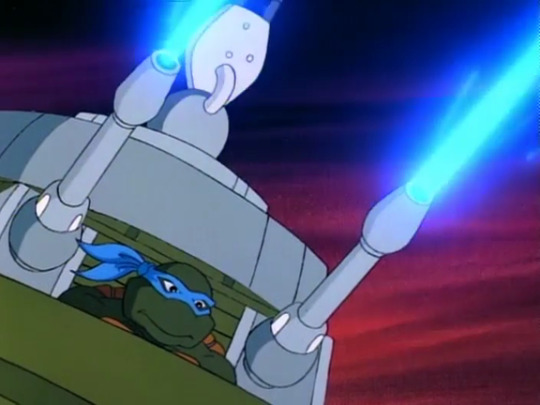

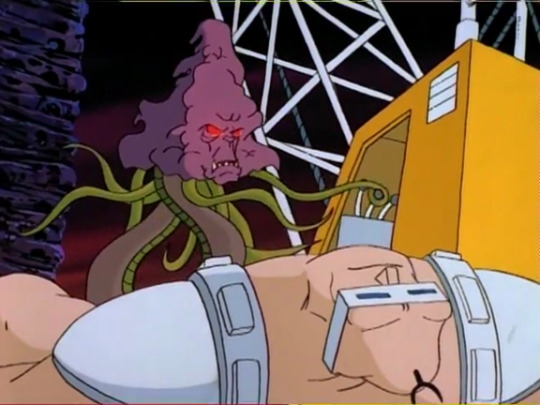

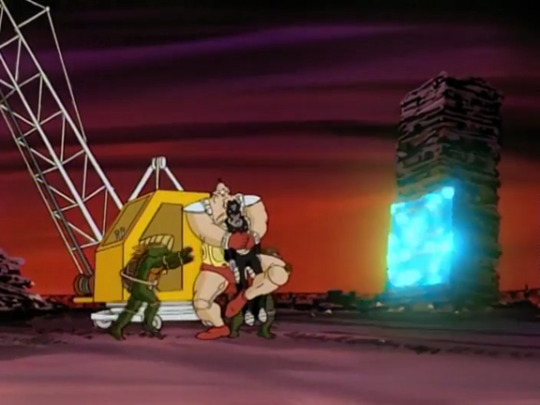
Leonardo and Raphael use the roof-mounted blasters on the Turtle Van to fire upon Dregg, but he rebounds by again assuming his ball form, knocking down Krang’s body like a bowling pin. Changing shape again he takes on the form of a tentacled creature, resembling one of the five warriors he recruited earlier. With only seconds remaining, Michaelangelo suggests they do “THE MOVE, dude”. Taking the controls, Donatello has Krang’s android body perform the Flying Claw, capturing Dregg from behind. Mikey and Donnie escape and push Dregg through the portal along with the android body seconds before it's due to explode.
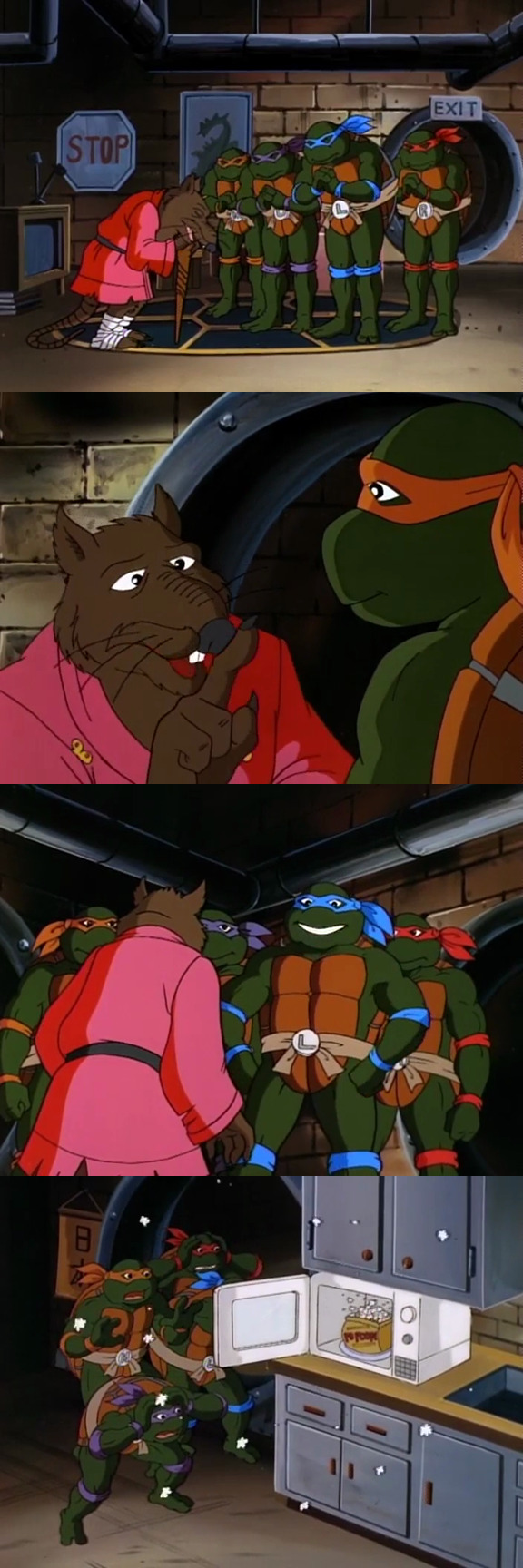
All of this brings us to the very last scene of the series. In the Lair, Splinter tells the Turtles that they are “truly exceptional students... and [he is] proud to be [their] equal”. This confuses Michaelangelo, who’s used to referring to Splinter as their sensei, but he explains that this would make him their leader or guide, something they no longer need: “like the lion,” he tells them, “You have no superior in the jungle of life”. Leonardo agrees that the Turtles can take on any challenge when a noise is heard from nearby. Rushing into the kitchen, the team find a bag of popcorn overflowing in the microwave: Raphael gets the last line of the series, remarking that the one thing they can’t handle is Donatello’s cooking.
And so, this is how is how Teenage Mutant Ninja Turtles ends, not giving us any substantive sense of closure but simply puttering over the finish line. That last scene, all 35 seconds of it, is the closest thing we get to a goodbye after all these years, a hurried acknowledgement that the Turtles are now equal to Splinter that honestly doesn’t feel earned: we just had a bunch of episodes in a row where the team were staring death in the face and the planet was in danger, today’s adventure feeling restrained by comparison. After pulling apart the adventures of the Turtles for a few years now, I went into this one expecting to feel... I don’t know, something, anything, but there’s almost nothing emotionally resonant in “Divide and Conquer”. I’m honestly disappointed.
Why did TMNT end in such an anti-climactic fashion? I’d speculate that, much like the conclusion of season seven, there was a desire to not fully close the door. Turtles as a property at least still had name recognition at this point, and perhaps Fred Wolf’s camp felt there remained a chance that a rival network would pick up the show for a few more seasons on that basis. It’s entirely feasible that an eleventh season would have seen either Dregg or Shredder and Krang return, but given how troubled the last few years of the show have been creatively, I’m not surprised this didn’t come to pass.
The first Turtlethon entry opened with an acknowledgement that Teenage Mutant Ninja Turtles debuted on TV only weeks after the series finale of Transformers, and this could be considered a passing of the torch: TMNT was, in many ways, the last great series of the 1980s “half hour toy commercial” era. As we close things out in the autumn of 1996, the Transformers have finally made a successful return to western animation with Beast Wars, which should give you some sense of how much the world has changed in the time between the premieres of “Turtle Tracks” and “Divide and Conquer”: that kind of half-hour computer generated animated show would have been unthinkable in the mid-eighties when Turtles was green-lit, but will come to dominate kid TV schedules as the millennium approaches. Which brings us nicely to...
AFTERMATH
Let’s do a lightning round covering how the various parties involved in the creation of TMNT fared after the show went off the air:
CBS pivoted to showing nothing but educational programming on Saturday mornings beginning with the 1997/98 television season. This came about as the result of strengthened regulation requiring that broadcasters air a set number of hours of informative fare each week, but also followed on from the budget cuts for programming mentioned in previous entries, and increased competition from cable channels such as Cartoon Network and Nickelodeon. A few years later the network would be absorbed into Viacom, Nick’s parent company; Nickelodeon would go on to purchase Teenage Mutant Ninja Turtles as an IP from Mirage Studios at the end of 2009.
Fred Wolf Films, the successor to Murakami Wolf Swenson, would putter on for a few years after the loss of their meal ticket. In a newspaper article from the boom years of TMNT, Fred Wolf suggested that the studio wasn’t making any money from the success of the series at the time due to the huge financial outlay required to make as many episodes as they did, and that it wouldn’t be until the show had ceased production and began playing in reruns worldwide that they would begin to see a return on their investment. It doesn’t seem like things played out this way, the firm moving on to work on a few Zorro and Sinbad cartoons as the nineties closed out; their website, last updated in 2000, is somehow still online and suggests they were looking to move into web animation around that period, but as far as I can tell nothing ever came of it.
Playmates Toys had financed the initial effort to bring the Turtles to television and would keep the brand afloat at retail throughout 1997, in part by re-releasing older toys in new packaging. They would go on handle the figures for the next incarnation of Turtles a short time later, and in fact continue to hold the master toy license to this day, a line of figures based on the recent Mutant Mayhem movie currently running in parallel with (often shoddy) recreations of toys from the classic era.
Mirage Studios perhaps had the most to lose with the continuing decline of TMNT and the end of the original cartoon. To ensure the survival of the property and that they could continue to employ their roster of artists, Kevin Eastman and Peter Laird made the decision to do business with Saban Entertainment, the production company behind Mighty Morphin’ Power Rangers; this was the same series which, as covered in previous Turtlethon entries, had been a key factor in TMNT’s rapid decline in the kidvid marketplace to begin with. The Mirage/Saban alliance would lead to the creation of the live-action Ninja Turtles: The Next Mutation, a disastrous series which would not only damage public perception of the Turtles further but also create a rift between Eastman and Laird which has only in recent years been patched up.
The four original voice actors for the Turtles are still active in the industry, and occasionally reunite on the convention circuit, often alongside Renae Jacobs (April). Barry Gordon, Rob Paulsen, Cam Clarke and Townsend Coleman reprised their roles as the green teens for the 2022 video game Shredder's Revenge. Between these stints Paulsen returned to Turtles for the 2012 incarnation of the show on Nickelodeon, this time as the voice of Donatello. James Avery (Shredder) passed away in 2013 following complications from open-heart surgery. David Wise is also no longer with us, having lost a brief battle with lung cancer in 2020, but both live on through their respective remarkable bodies of work, including their extensive runs on TMNT.
As I’m sure you know, Turtles continues to endure, not just in its 1987 incarnation but the countless versions which have popped up in the years since. Recently Viacom announced that they’ve finally reached an agreement to secure the broadcast rights to the original series: the first season is already up on YouTube for free (albeit in an altered form, and with a new theme song in place as presumably Chuck Lorre’s asking price for royalties was simply too high); the show is also in rotation now on Pluto TV’s Totally Turtles channel in the US and will be arriving on Paramount+ in short order. Personally I’m still hoping we get a nice Blu-Ray set of the series down the line at some point with the entire series in better quality than the occasionally substandard Lionsgate DVD prints.
So... now what? Next time on Turtlethon we’ll wrap up all the loose ends, reflect on the last few years of exploring TMNT and try to figure out what the point of all this was – as well as where we go from here. See you then!
#teenage mutant ninja turtles#tmnt#tmnt 1987#turtlethon#ninja turtles#dregg#lord dregg#1996#divide and conquer#divide & conquer
3 notes
·
View notes
Text
"The Day the Earth Disappeared"
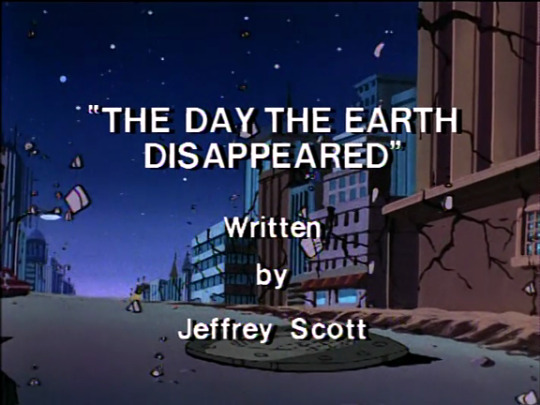
Season 10, Episode 7 First US Airdate: October 26, 1996
Lord Dregg plots to draw Earth into Dimension X.
"The Day the Earth Disappeared" is the penultimate episode of Teenage Mutant Ninja Turtles. As with the rest of season ten’s episodes, Jeffrey Scott is credited as the writer of this adventure.

Wasting no time, today’s show gets right into the action as the Turtles emerge from the sewers to find the city streets crumbling around them due to a disturbance in the Earth’s crust, a volcano popping up and erupting right in front of them. In the sky above the Dreggnaught appears, a group of parachuting bat-men emerging from it to surround our heroes. Lord Dregg arrives and easily defeats the Turtles, having his troopers cover them in an ooze-like substance that freezes them on the spot before he uses a ray gun to shatter them into pieces. This, as it turns out, is a ruse: the real Turtles reveal themselves to be very much alive, the ones that Dregg destroyed mere holographic projections. With the tide of battle turning, Dregg and his men teleport back to their ship.

Later, Dregg re-watches these events on a viewscreen in his ship alongside Mung. With the construction of a new vortex transporter complete, the villains get to work on their new plan: to use the transporter in a modified capacity as a space warp that will transport the Earth to a new solar system, one controlled entirely by Dregg. This activity sets off the early warning systems in the Lair, warning the Turtles that a huge disturbance has been detected in the Earth’s magnetic field. A space warp soon opens above the planet, large enough to be visible to April from the window of her apartment; examining the situation using his computer, Donatello calculates that it’s already a thousand miles wide, and growing at a rate of 3,000 miles an hour; if it keeps growing at this rate, within two hours it’ll be large enough to swallow the planet, transporting it to Dimension X. Faced with the challenge of pinpointing the source of the warp, which is a thousand miles above the planet, the team turn to Donatello’s dimensional portal as a means of tracing the energy flow.

Back aboard the Dreggnaught, Mung detects the attempts by someone to interfere with their scheme. Dregg orders that whoever is responsible be sucked into a black hole adjacent to the warp, and is warned by his underling that moving the hole too early could destabilise the warp, preventing them from successfully pulling the planet into Dimension X. Dregg refuses to listen to Mung’s advice, insistent that his commands be followed.

Having determined that the Dreggnaught is the source of the warp, Donatello suggests that the team use his dimensional portal to board the ship, thwart Dregg’s plan and return to the Lair. The other Turtles are wary, given the portal’s reliability in the past has been patchy at best. Before they can agree on a course of action, Dregg turns the portal against the team, using it to pull Leonardo and Donatello inside. April watches on a viewscreen which is itself destroyed by the force of the warp; moments later, Splinter is also pulled into the portal.

We begin act two with Dregg elated at the news that two of the Turtles have been pulled into the warp, refusing to let Mung rain on his parade by pointing out that even this means the other half of the team has survived. The alien warlord insists that the black hole be moved closer to the warp; again, Mung insists that this is a risky course of action, further raising the ire of his master.

With Michaelangelo and Raphael still clinging on and trying desperately not to get sucked into the portal, April leaves her apartment hoping she can arrive at the Lair in time to save her friends. Meanwhile Leonardo and Donatello land on a dimensional planetoid that has been suspended in a gravitational whirlpool. Now separated from Splinter, the pair set out to try and find him.

Mung’s concerns about placing the warp nearer to the black hole turn out to have been valid, a warp storm forming as a result that threatens to tear the Dreggnaught apart. As Dregg’s lackey rushes to try and resolve the problem, Splinter finds himself teleported onto the ship. Evading a patrol of bat-men, he begins looking for a way to aid the Turtles in defeating the villains.

April arrives in the Lair seconds before Raphael and Michaelangelo are pulled into the portal. The pair find themselves on a seemingly barren alien world, and are soon confronted by a fire-breathing monster, which grabs Raph with its mouth; Mikey taunts the beast until it lets go, both Turtles diving back into the black hole, the creature following them. Elsewhere, Leonardo and Donatello are grabbed by rocky claws that emerge from the ground beneath them.
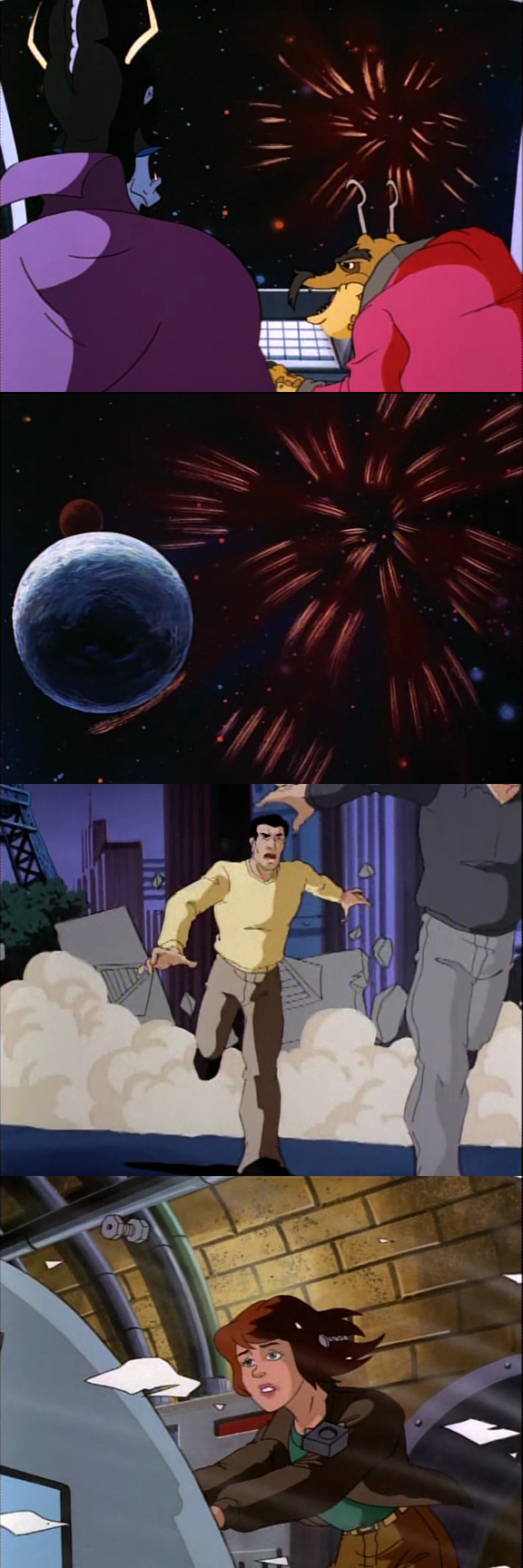
With the storm no longer an issue and the warp fully opened, Dregg orders that the black hole be moved into position. Act two ends with the Earth seen being pulled closer to the warp, now on-course to be transported to Dimension X. We get a taste of the impact this has when the show returns from commercials, with people across the world fleeing in terror as cities begin to crumble. Meanwhile, in the Lair, April attempts to close the portal without success.

Aboard the Dreggnaught, Splinter fights off a group of bat-men before altering the controls for the transporter. (If you’re wondering how he has any idea what he’s doing, it’s inferred that he’s using his heightened ninja senses to figure it all out.) Meanwhile Raphael and Michaelangelo arrive alongside the fire-breathing monster in a world covered in ice, where they attract the attention of a giant yeti-like creature.

Having two pairs of Turtles running around alien worlds getting chased by monsters seems to have confused the heck out of the animators, as the next scene opens with Leonardo trying to free himself from the clutches of one of the hands rising out of the ground using his katana, except... he’s drawn in Raphael’s colours, and also appears to be on the ice world. Donatello appears alongside him, also unable to escape and concerned that if they don’t do something soon, there won’t be an Earth to return to.

With sixty seconds remaining until the planet is pulled into Dimension X, Dregg orders that as soon as the shift has been made the black hole be transported elsewhere, taking the Turtles with it. The villain soon becomes aware of the presence of Splinter aboard the ship, who escapes into an airlock before re-emerging to transport the black hole into the Dreggnaught. A furious Lord Dregg declares that this will result in everyone on-board being “destroyed” - which is to say, killed – to which Splinter counters that it’s Dregg’s own evil that will be the cause of his destruction. Leonardo and Donatello are transported onto the ship, with Leo slicing the transporter control panel into pieces. Dregg points out that this will do nothing to save the Earth, and will merely prevent the black hole from being withdrawn. Donatello counters by picking up a laser blaster and opening fire upon the ship’s computers, closing the warp; somehow this also moves the Earth back into its normal position.

Now left with no means of returning home, the two Turtles are reminded by Dregg that thanks to the destruction of the navigational computers, his ship is now adrift in space, doomed to be pulled into the black hole and ultimately destroyed by its gravitational force. The spacecraft is seen crumbling as Dregg declares that in death, he’ll at least have the satisfaction of taking the two Turtles with him. This turns out to not be the case, as Michaelangelo and Raphael arrive via a dimensional portal, pulling Leo, Raph and Splinter back inside. Our heroes land safely back in the Lair, hurriedly ordering April to close the portal to prevent Dregg from following them through; a huge explosion is then seen as the Dreggnaught hurtles toward the heart of the black hole.
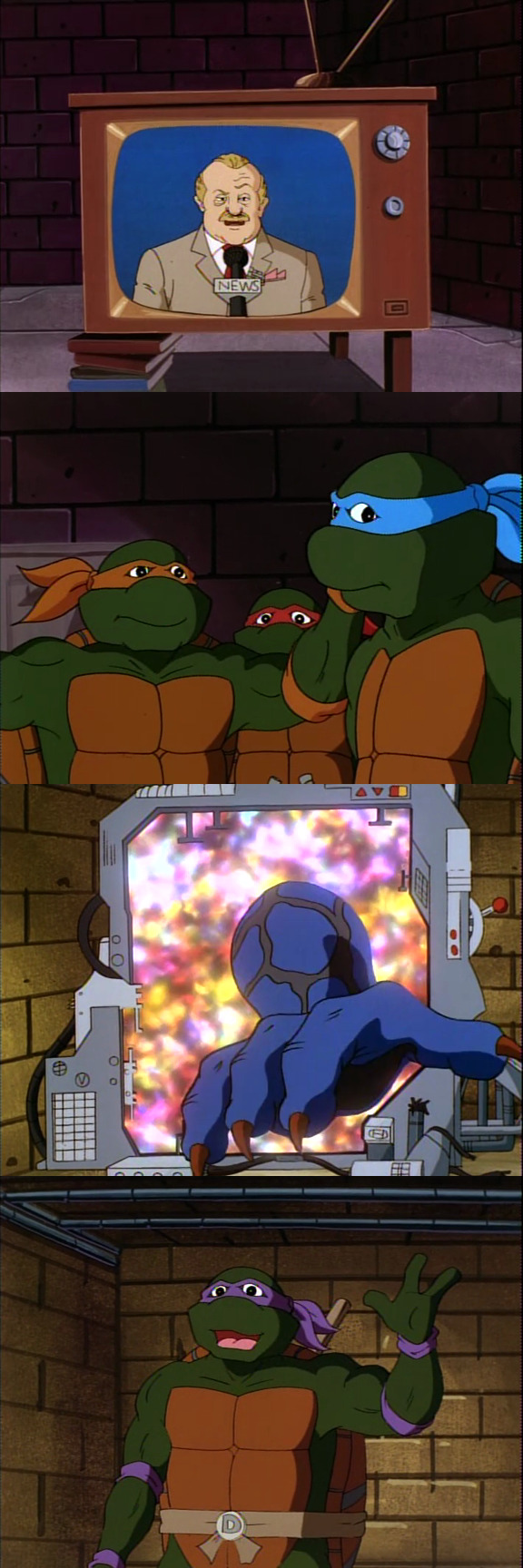
Later, in the Lair, the Walter Cronkite-esque newsreader is seen on TV reporting on how the space warp closed, “allowing the Earth to remain in its orbit”. This is framed by “Walter” as an issue that resolved itself, with the efforts of the Turtles never acknowledged, to their chagrin. The episode concludes with Donatello announcing his latest round of modifications to the portal have finally ironed out the bugs, only for the claws of a gigantic blue creature to briefly emerge from it. The team force the intruder back, destroying the portal's controls and agreeing that it'll be off-limits from now on.
"The Day the Earth Disappeared" is nothing new: we’ve seen variations on this idea of the planet being pulled into Dimension X before, and the Turtles encountering weird aliens while portal-hopping is a particularly well-worn concept. If anything, it would be surprising this far into the tenth season of the show to see any kind of innovation: there’s little sense in reinventing the wheel now, and so this and the previous episode have been about determining what has worked in the past and sticking with it. There is, at least, something intriguing in the growing friction between Lord Dregg and Mung that makes this episode compelling for viewers who have tuned in for the entire season, preventing it from feeling like we’re just going through the motions. So far Mung has dutifully taken the abuse dished out by his master but it’s evident that he’s reaching the point where he’s almost had enough. It’s a scenario reminiscent of Baxter’s lingering resentment towards Shredder throughout season two, and something that – at the risk of spoiling the series finale – will pop up again in the next Turtlethon entry. (Yes, somehow both Dregg and Mung are still alive.)
Next time, we explore “Divide and Conquer”, the final episode of Teenage Mutant Ninja Turtles. I really don’t know if I’m emotionally prepared for this.
#teenage mutant ninja turtles#tmnt#tmnt 1987#turtlethon#ninja turtles#lord dregg#dregg#1996#the day the earth disappeared
2 notes
·
View notes
Text
“Mobster from Dimension X”
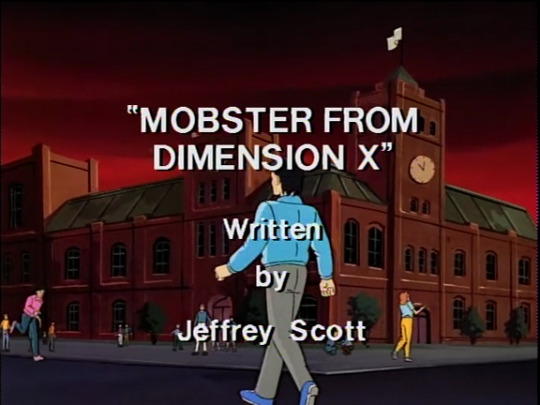
Season 10, Episode 6 First US Airdate: October 19, 1996
The Turtles battle an alien amoeba crime boss who seeks to steal a supercomputer on behalf of Lord Dregg.
The tenth season of Teenage Mutant Ninja Turtles continues with “Mobster from Dimension X”. As with the rest of this year’s episodes, this outing is credited to Jeffrey Scott.
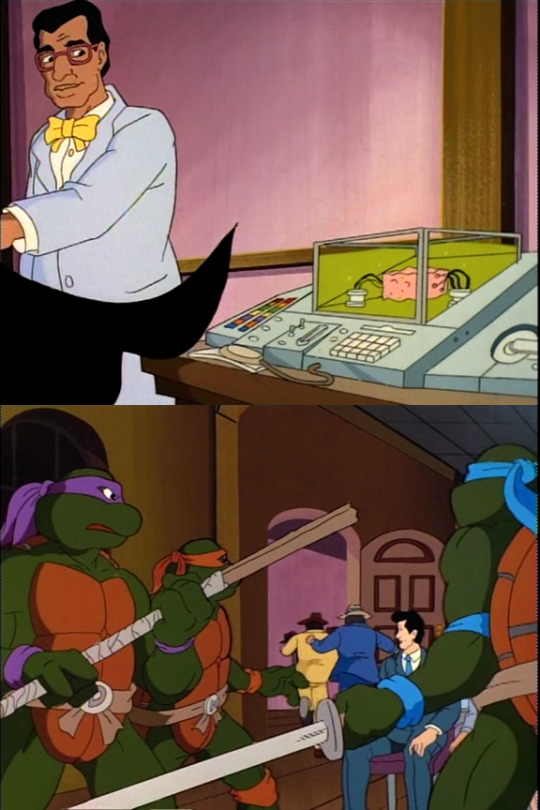
At a college campus, Professor Huxley is seen unveiling a revolutionary “protein computer”, watched from afar by Donatello as the other Turtles reluctantly tag along. Huxley goes on to demonstrate how a headset can allow him to link up the computer and mentally control anything connected to it such as lights and air conditioning. A group of laser-gun wielding gangsters show up to steal the computer, but their efforts are thwarted by the Turtles, with both parties escaping when the police arrive.
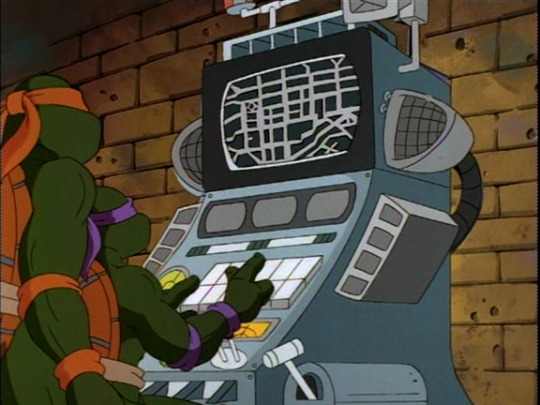
Back in the Lair, the Turtles try and determine why the gangsters had targeted the computer when an early warning system sounds, informing them that traces of transporter energy have been detected. Convinced that this is a sign Dregg may have returned after being banished to Dimension X in the previous episode, the green teens head off to investigate.
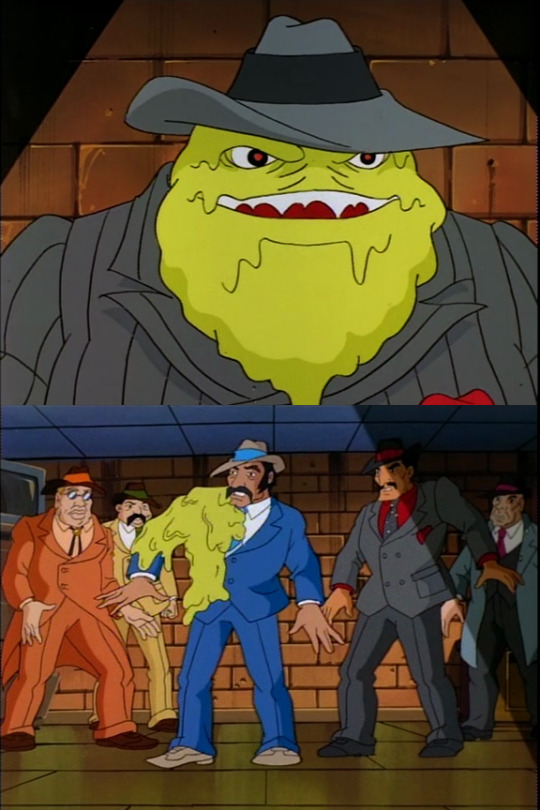
At their hideout, the group of gangsters try to downplay their inability to steal the computer to their boss, a bright green slime monster in a suit and fedora named The Globfather. One of the men is punished by being turned into a pile of goo, and the others are warned the same fate will meet them should they fail in the future. The Globfather reveals that he was sent to Earth to retrieve the protein computer “by someone who is willing to pay dearly for it”; his underlings are promised that if they succeed, he’ll provide them with enough alien weaponry to easily take over the city. The crooks are instructed to try and steal the computer again, this time under the direct supervision of their boss.
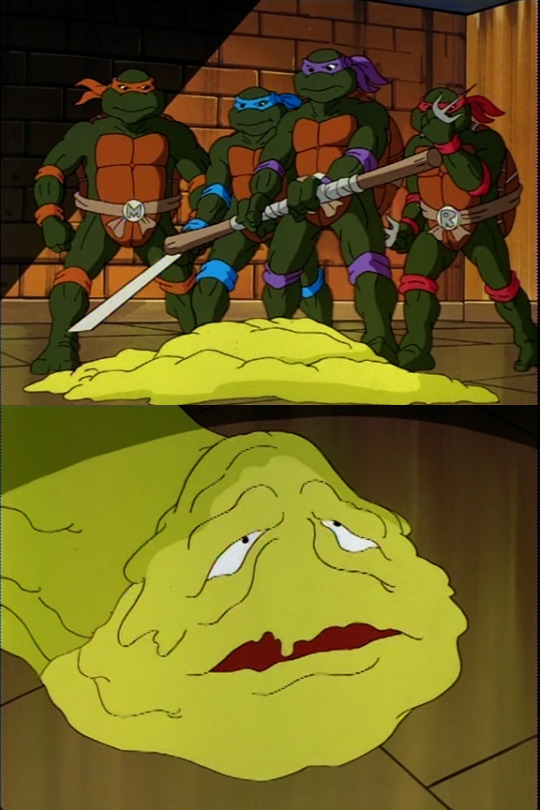
The crooks leave moments before the Turtles arrive in their van, having determined that the teleportation activity they detected took place in the hideout. Once inside, the team find the puddle of goo that was once a member of the mob group on the floor, and are shocked as the puddle of slime manages to utter a few words, revealing the name of the criminal kingpin and his intent to steal the computer from Huxley’s lab before reverting to being lifeless ooze once more.
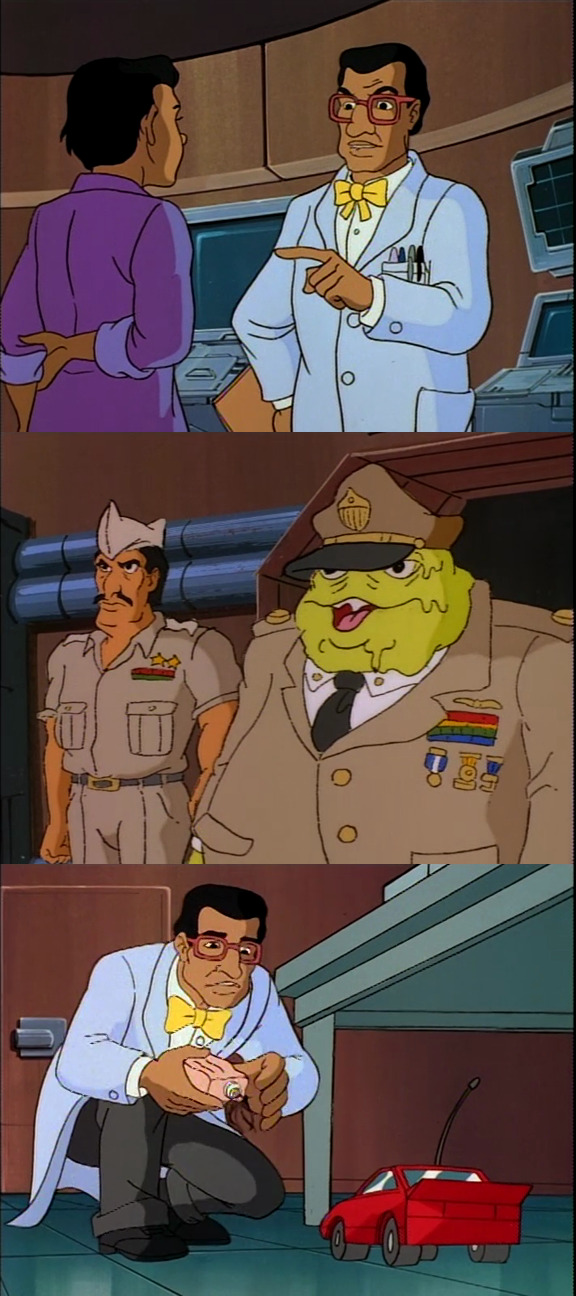
At “Computer Science Lab”, Huxley is seen continuing to conduct his research, his son Ronnie hanging around nearby and playing with a radio-controlled car. Dressed as military officials, the gangsters infiltrate the facility and inform Huxley that it's under attack, offering to escort him safely outside. Dressed in uniform, the Globfather then reveals his true intentions, his men filing in to steal the computer seconds before the Turtles arrive. Seeking to protect his computer’s “brain” from being damaged during the battle, Huxley secretly places it in the shell of Ronnie’s RC car.
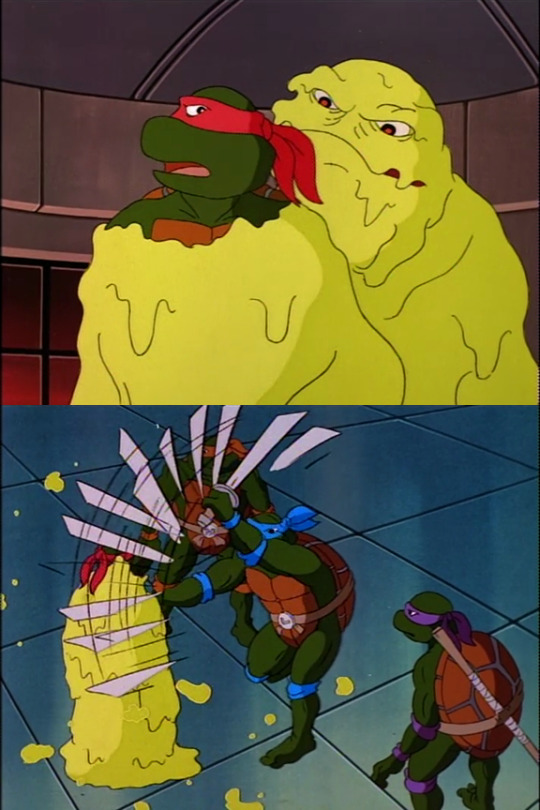
Act one ends with the Globfather attacking Raphael by wrapping him in goo, which he promises will turn him into an amoeba, “just like [him]”; When the show returns from commercials, the other Turtles are warned that should they touch him they’ll become blobs too. The gangsters make their exit with the computer (minus its brain), with Ronnie leaving soon after; meanwhile the Turtles are left to deal with Raphael’s predicament, which Leonardo resolves with some unintentionally hilarious rapid-fire swishing of his katana blades.
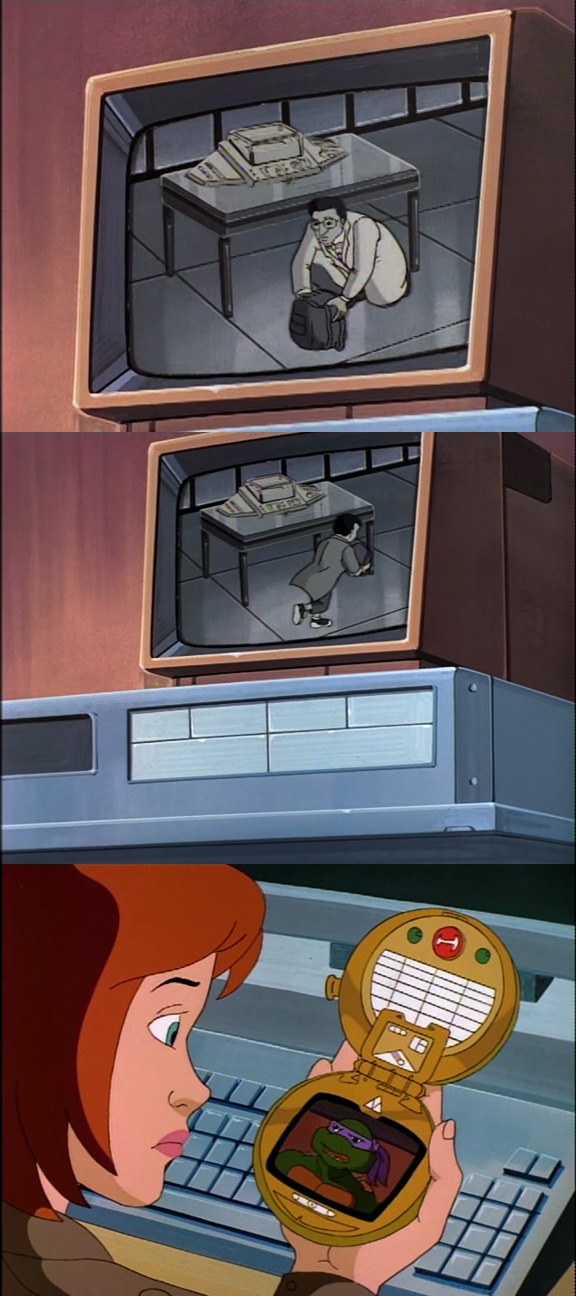
Reviewing the lab’s security camera footage, the Turtles watch Huxley place his computer’s brain inside the shell of his son’s toy car, before in turn dropping this into his backpack; moments later Ronnie is seen picking up the backpack and leaving the building. The team set out to find Huxley’s child before the Globfather realises what’s happened, contacting April and asking her to have the police help in the search for him.
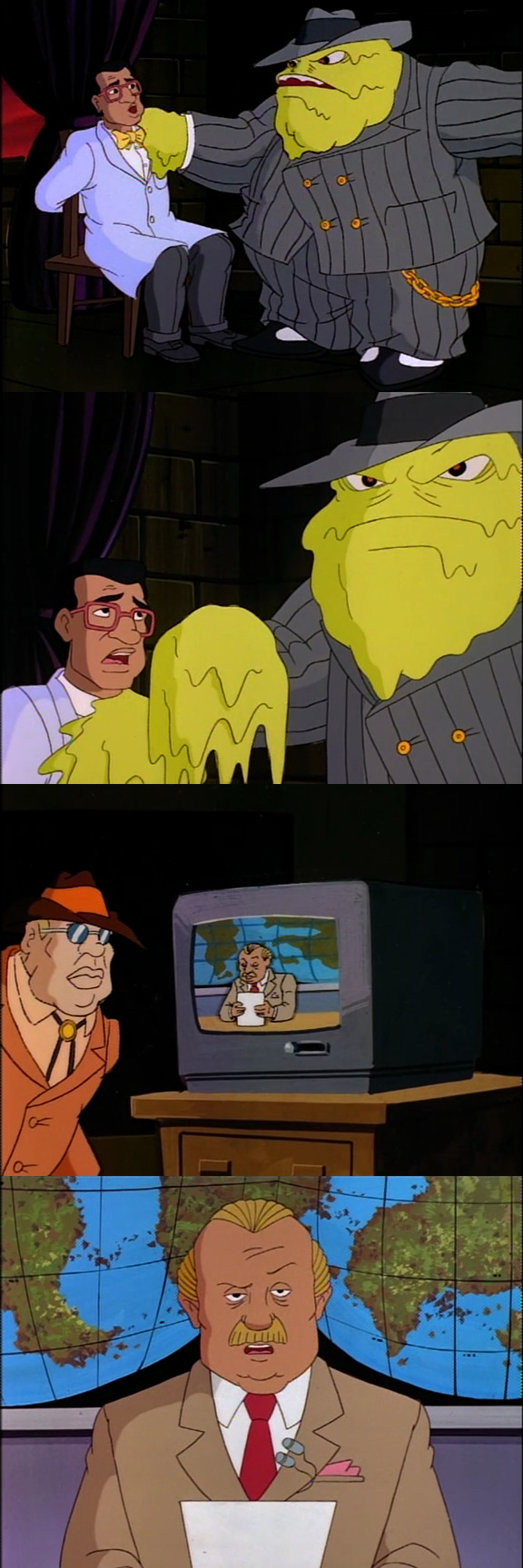
At their hideout, the gangsters realise that the computer is incomplete. Globfather presses a tied-up Huxley for information, threatening to turn him into an amoeba too if he doesn’t comply. The Professor coughs up the information about where the brain was stashed, though this leaves the crooks in a position where they still can’t visually identify the boy. Fate intervenes as a Channel 6 news broadcast displays a photograph of Ronnie, with viewers being asked to contact the authorities should they see him. (This marks the penultimate appearance in the series of the Walter Cronkite lookalike newsreader, who quite incredibly is the last recurring human character to appear in the show bar April, having even outlasted Shredder.) Globfather makes his exit, leaving a large portion of goo on Huxley to ensure he doesn’t attempt a double-cross.
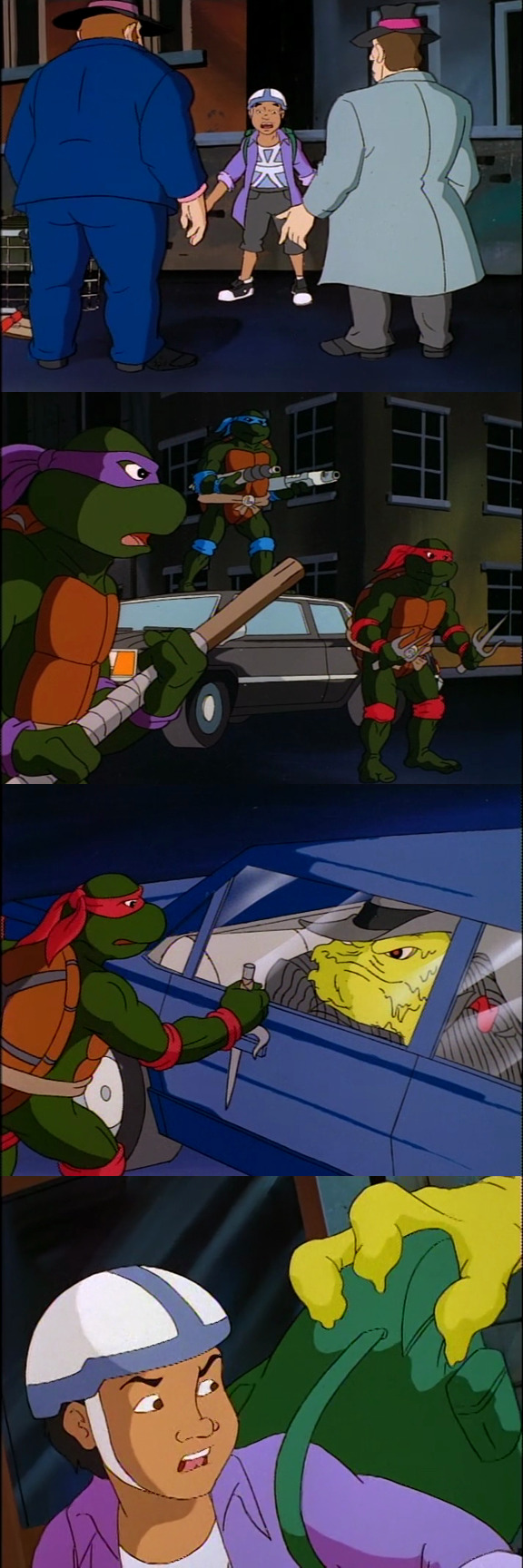
Ronnie is chased by the mobsters but the Turtles intervene, with Leonardo snatching a pair of their laser weapons to use against them. The Globfather arrives in his limousine and is trapped inside by our heroes, but uses his shapeshifting abilities to slide through a vent onto the street before re-forming. He soon changes shape again, rising via a drainpipe before snatching the backpack from an escaping Ronnie as act two ends.
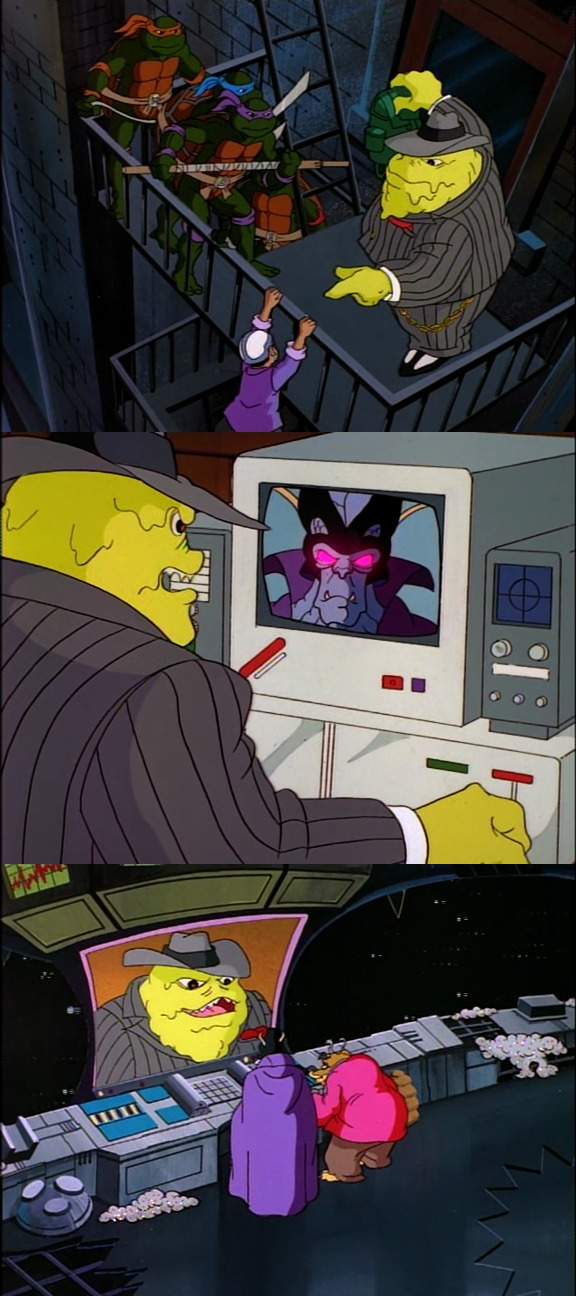
We begin the final act with Ronnie left dangling from a balcony. Globfather taunts the Turtles, challenging them to make the choice of saving the child or retrieving the backpack, and makes his escape as the team choose the former option. Back at his hideout, the slimy mob boss contacts his “benefactor”, Lord Dregg. The alien warlord outlines the next phase of their plan, as he intends to have Globfather connect Huxley’s invention to the national telephone network. This will allow Dregg to “control all Earthly computers” with his brain, including military defence systems. (This seems to presume that all computers on the planet are hooked up to a dial-up modem which is connected all the time, I really don’t think he’s thought this through.) We also learn that a new Dreggnaught is in the process of being constructed by the microbots, the completion of which will take several days: once it’s done, the vortex transporter will allow for the villain’s return to Earth.
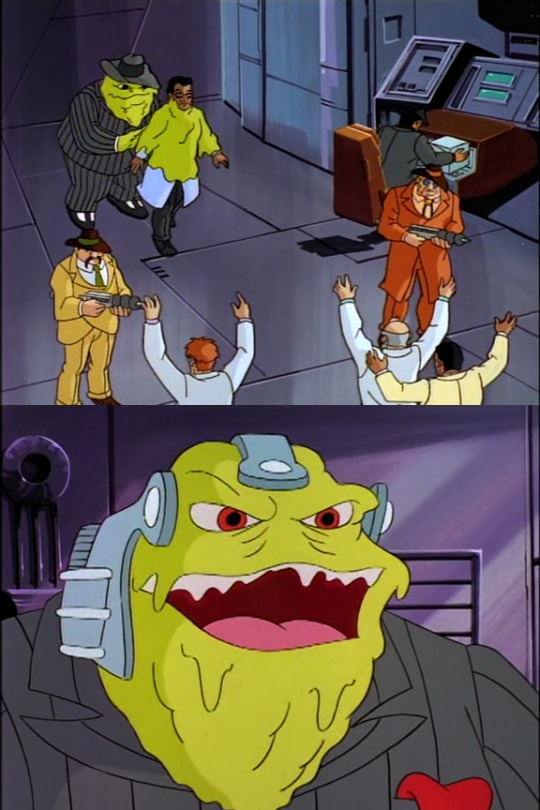
The Globfather and his men barge into the phone network facility, where the protein computer is hooked up to the system; the mob boss then uses the telepathic headset demonstrated by Huxley in the episode’s opening scene, gleefully declaring that he “can feel [his] mind connecting to millions of computers around the world!”
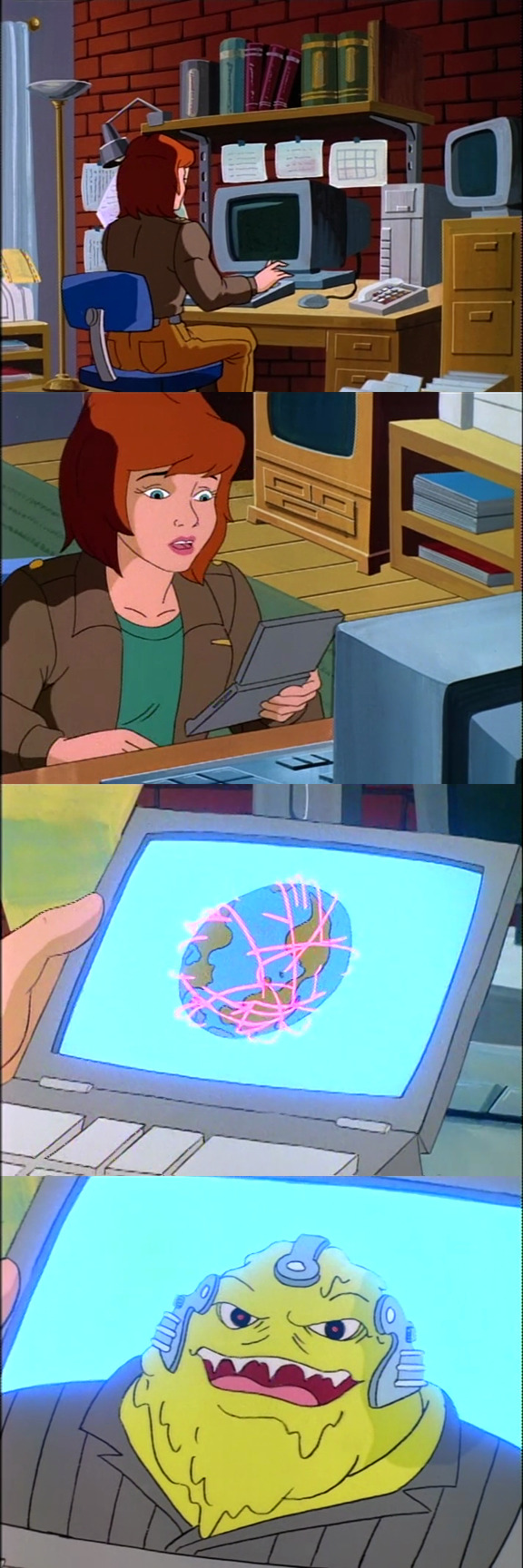
I’m becoming increasingly convinced that since leaving Channel 6, April has chosen to fill her free time by becoming addicted to this newfangled “Internet” thing, and is justifying her dependency by telling herself it’s in the name of journalism: rarely nowadays, outside of her direct interactions with the Turtles, do we see her anywhere other than hunkered down in front of her computer in her apartment. That’s exactly where she is as the next scene opens, and when the Internet goes down her response is to immediately whip out her notebook computer (which she helpfully declares incorporates a cellular modem.) Using the device, she views an image of “all the world’s phone lines”, which are being tapped into: seconds later, the Globfather appears on-screen, announcing that all communications systems are now under alien control and threatening reprisal towards anyone who tries to interfere.

With Globfather preventing anyone from making phone calls, April instead reaches out to the Turtles, as the Turtlecom signal is apparently unaffected. From their van – and despite the warnings of Ronnie – Donatello attempts to establish a connection with the phone network. This somehow grants the crime boss control of the Turtle Van, and he quickly utilises its weapons to blow the rear doors off before setting the vehicle on a collision course with an oncoming truck. After Raphael destroys the on-board computer, the team regains control, steering the van to safety at the last second. Ronnie attempts to advise the Turtles on a plan of action, but the team talk over him, deciding to return to the Lair.
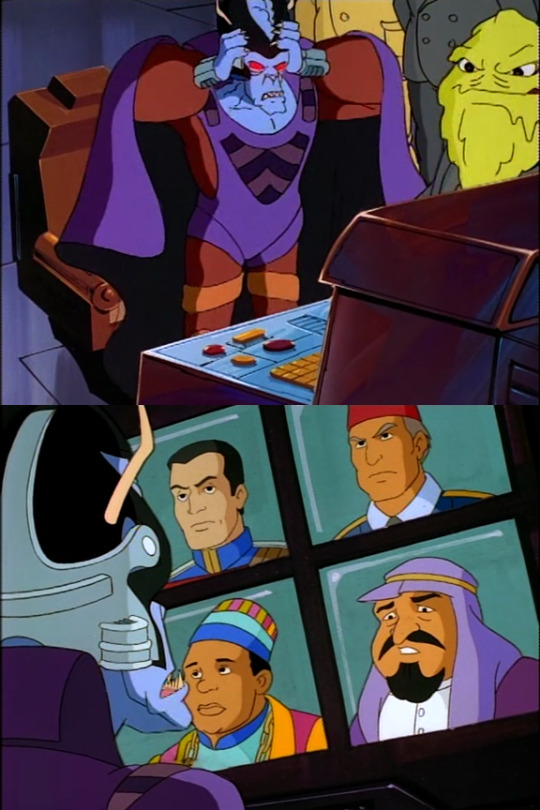
Dregg teleports in to join the Globfather just as the military is about to claim control of the communications network, and instead uses a weapons satellite to stage a counter-attack. He warns a group of world leaders that the planet’s nations have only fifteen minutes to surrender, threatening to use the satellite to begin destroying cities if they don’t comply.
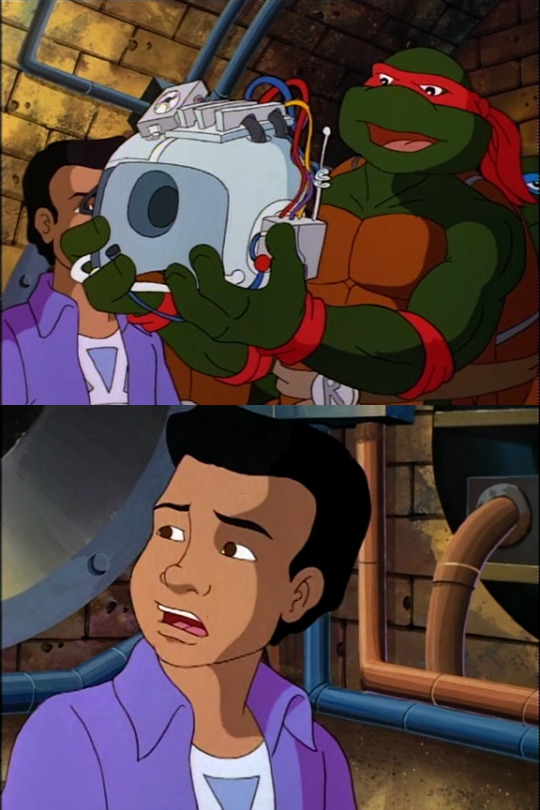
In his workshop, Donatello – drawn in one particularly lengthy shot as Raphael, “R” belt and all – constructs his own telekinetic headset which he intends to hook up to the computer system and counteract the efforts of the Globfather. When the headset malfunctions, Ronnie again tries to provide advice, only to be ignored by the Turtles who fumble through and resolve the problem themselves. Tired of being brushed off by our heroes, Huxley’s son quietly makes his exit.

The leaders of “all nations” managed to agree within that fifteen-minute timeframe to surrender to Dregg, which somehow might be the most implausible thing to occur in this episode about a mob boss made of slime who takes over the world with a computer hooked up to a chunk of meat. Never fear, as the Turtles infiltrate the network facility to begin taking out Globfather’s blaster-wielding goons. Aware that he’s under attack, Dregg prepares to use the satellite space lasers to begin destroying cities as planned. Donatello uses his own mind control helmet to try and counteract this, leading to a brain-off between the two that ends when Ronnie re-emerges, using his RC car to damage Dregg’s control panel. Donatello is then able to assume command, connecting with a mobile vacuum robot that sucks up the Globfather. His plan foiled, Dregg teleports back to Dimension X alongside the robot now containing the defeated mobster.
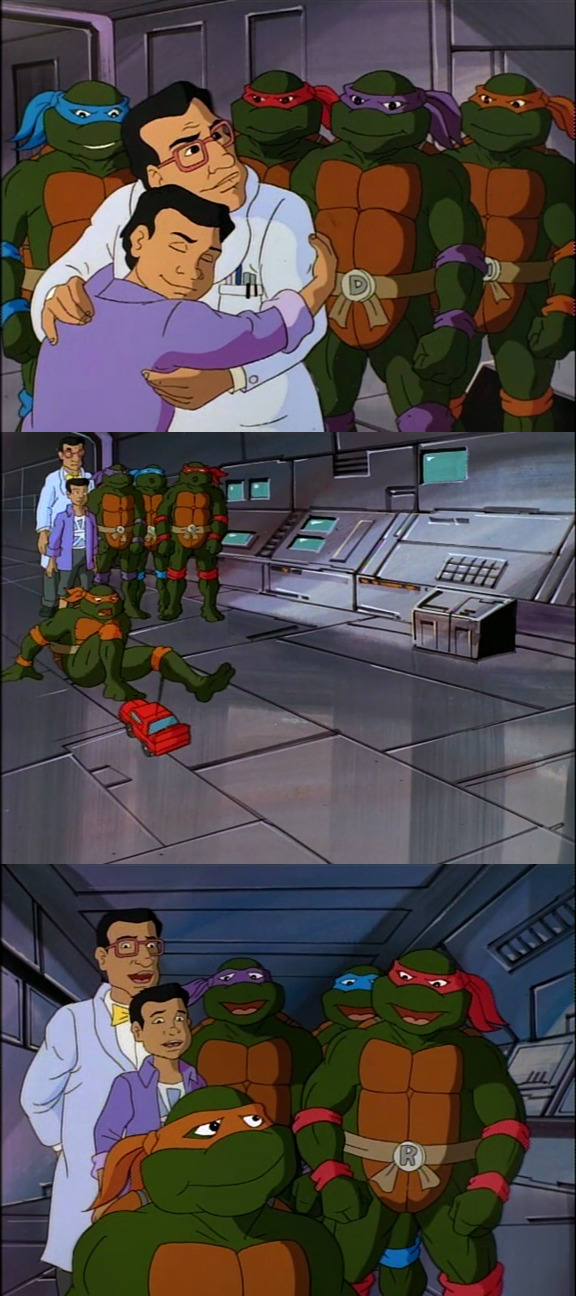
Ronnie is reunited with his father, and the Turtles congratulate the Professor’s son for helping them save the day. Michaelangelo is enamoured with the RC car, convinced he could have pulled off the same trick in using it to defeat Dregg, but instead is knocked to the floor by it as everyone laughs and the episode wraps up.
“Mobster from Dimension X” isn’t earth-shattering, but following on from a trilogy where the Turtles were presented with one of their greatest challenges ever, I appreciate that the show is taking an opportunity to slow things down for a bit ahead of the upcoming series finale. Structurally this is the 1987 Turtles as it used to be: some scientist invents a game-changing doohickey, a bad guy makes a play to steal it, and our heroes work to get it back before it can be used for world domination. The key difference of course is that typically in the old days it was Shredder doing the deed, having received his marching orders from Krang, and as this is a Red Sky-era episode there’s a greater emphasis on action than on one-liners.
The Globfather is particularly interesting as he represents an area where late-stage TMNT has an edge over the classic era incarnation of the show. Off-the-shelf mob boss characters alternated with evil scientists throughout seasons three and four and hampered the show by being boring as hell: Don Turtelli, Pinky McFingers and Mad Dog McMutt were just three of this seemingly endless parade of crime kingpins who were barely distinguishable from each other. They presented the Turtles with little challenge and felt out of step with the imaginative and outlandish characters that drew kids to TMNT in the first place. The Globfather takes that same archetype and makes it work within the context of the series: while there’s nothing revolutionary about him, his design is visually solid and the ways in which his slime powers are utilised suggest to me he could have had a long run in the show had he been introduced in the early days. This is a long way of saying that I wish all the Pinky episodes could have been Globfather ones.
Hopefully you enjoyed this breather. Next time, things will begin ramping up again: Dregg returns with yet another scheme as the Turtles fight to prevent the planet from being pulled into a black hole in the penultimate episode of Teenage Mutant Ninja Turtles, “The Day the Earth Disappeared”.
3 notes
·
View notes
Text
"Turtles to the Second Power"
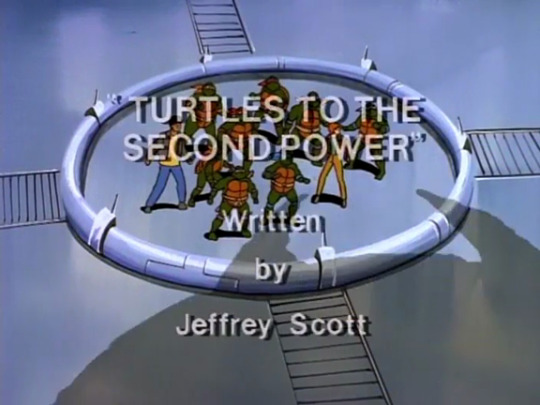
Season 10, Episode 5 First US Airdate: October 12, 1996
The Turtles of the past and present work together to prevent Lord Dregg from using the sun to destroy the world’s cities.
The final season of Teenage Mutant Ninja Turtles continues with "Turtles to the Second Power". This is the third part of an ongoing storyline which began with “The Power of Three” and continued with “A Turtle in Time”.
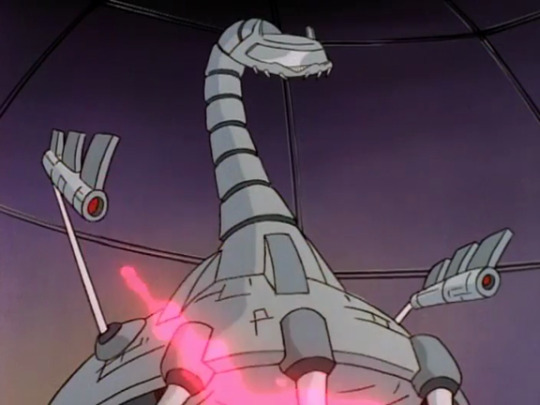
As with the previous episode, we begin with a retelling of events so far, summarising Dregg draining the Turtles of their powers, his plan to transport pieces of the sun into the heart of Earth’s cities which was thwarted due to Shredder’s sabotage of his equipment, and Carter requesting the help of time-hopping resistance warriors Landor and Merrick in summoning the Turtles of two years earlier from the past to provide a life force transfusion for their present-day counterparts. The Turtles of season eight would go on to rescue their season ten selves from the Dreggnaught and return to New York alongside April and Carter, but now find themselves face to face with Dregg’s “invasion force”: a beastly robot monster piloted by a group of bat-men.
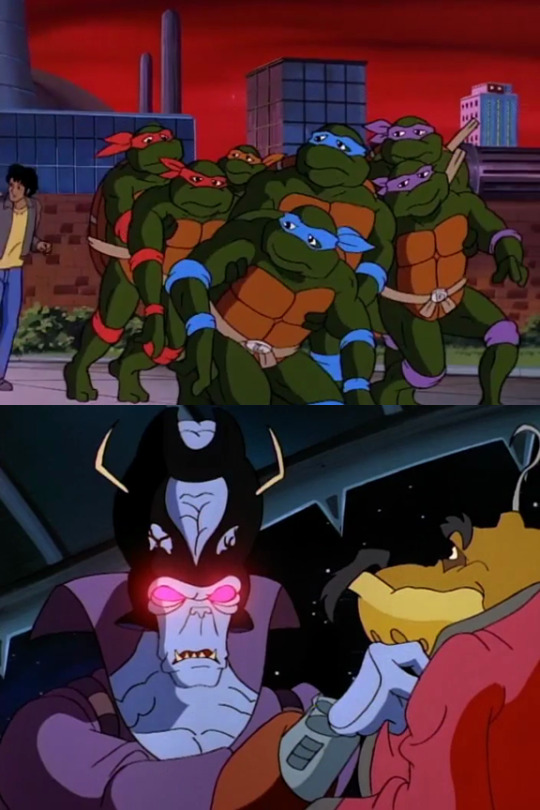
It’s faintly surreal to watch the two sets of Turtles emerge from Dregg’s nuclear power plant base, the healthy ones from the past each propping up their ailing current-day counterpart. April leaves to inform the wider world of Dregg’s schemes while Carter returns with the Turtles to the Lair. Aboard his ship, we see Lord Dregg take out his frustrations on Mung, something he’s been doing with increasing frequency as the season has progressed. He demands to be given a status update on when the rest of his attack force will be ready, and is informed it’ll take another fifteen hours before they’re ready to begin taking over the planet.
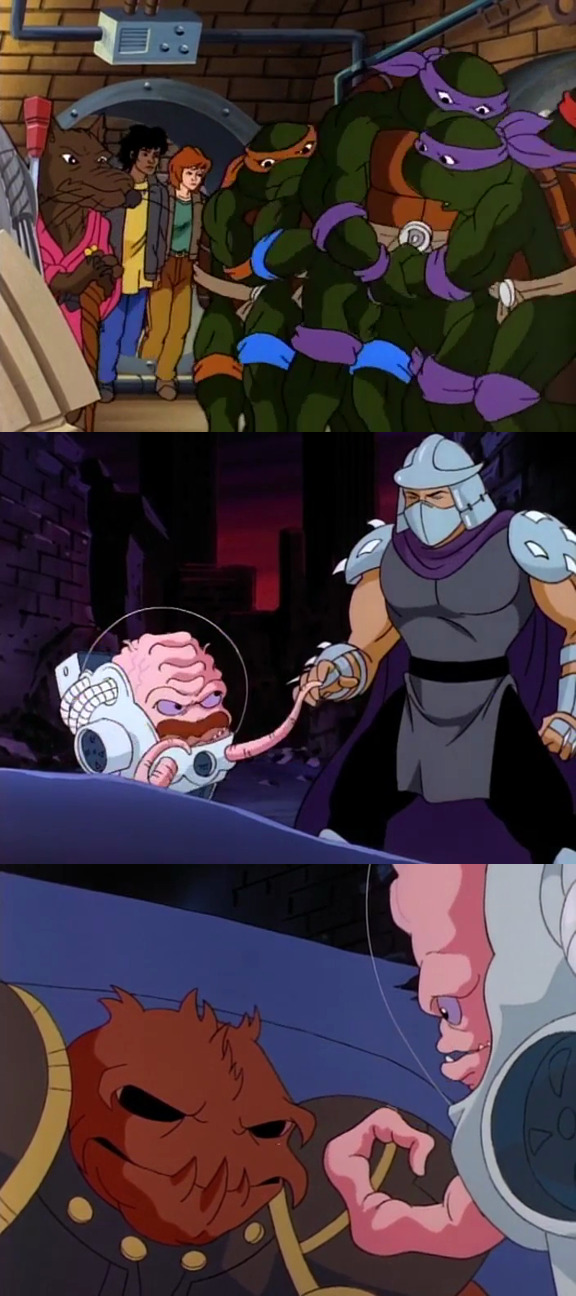
In the Lair, Carter assists the Turtles in using the de-mutation ray to begin the life force transfer needed to ensure the survival of the current-day green teens; when quizzed as to how long it’ll take, he responds that the procedure will be done in – yes – “about fifteen hours”. Elsewhere in the city, Shredder and Krang begin plotting to strike back at Dregg, with Shreds still in possession of the chip from the villain’s vortex transporter and now intent on using it against him. The duo captures one of Dregg’s bat-men, with Krang using his powers of hypnosis(!?) to gain control of the trooper.
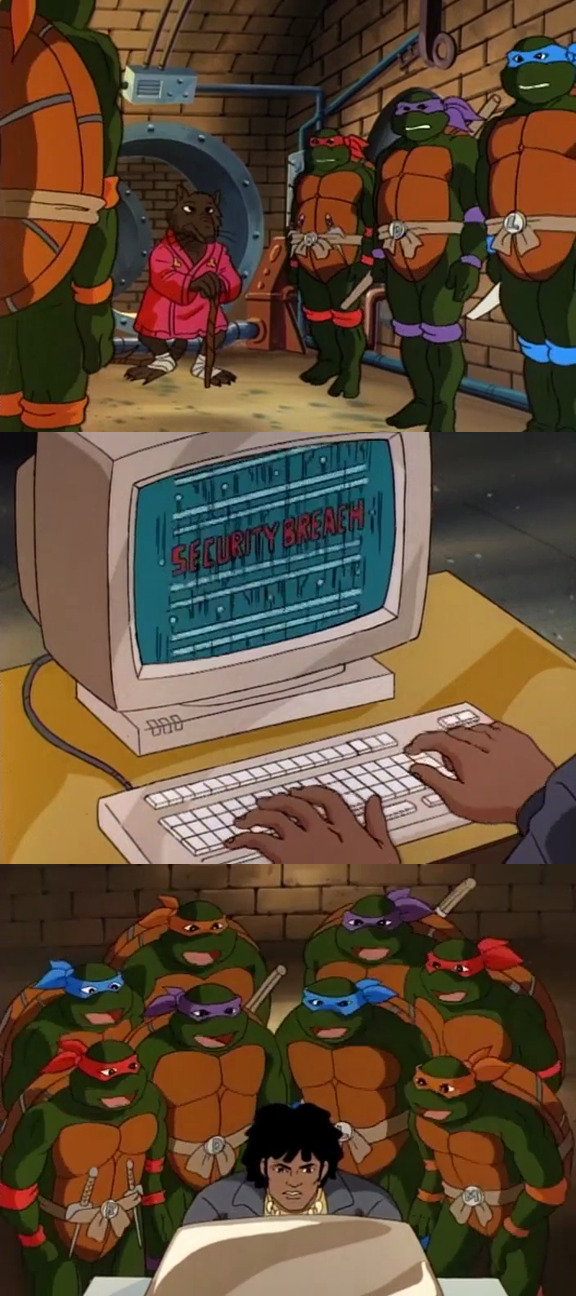
We jump forward to the completion of the life force transfer, the health of the present-day Turtles now restored. Their season eight counterparts are ready to return to their own time and resume the battle they were participating in during “Turtle Trek”, and so Carter again uses Donatello’s computer to try and summon Landor and Merrick. This time the efforts to establish a connection are unsuccessful, the message “SECURITY BREACH” appearing on the monitor. Raph points out that they only have three hours left before the time warp paradox will cause them to cease to exist.

With his invasion force now ready, Dregg beams down with Mung to Earth. Act one concludes with the heavily armed machines being teleported into the heart of the city, where they begin opening fire and causing citizens to flee in terror. When we return from commercials April is seen pleading with an unconvinced sergeant at the police station, who changes his tune after seeing Dregg’s mecha fleet decimating portions of the city nearby. The two sets of Turtles, accompanied by Carter, also become aware that the invasion is underway, emerging from the Lair and immediately needing to take refuge in a nearby alley after being fired upon. Some fun action sequences follow in which each of the season eight Turtles works alongside their season ten counterpart to try and take down the machines, with Carter also briefly adopting his mutant form.
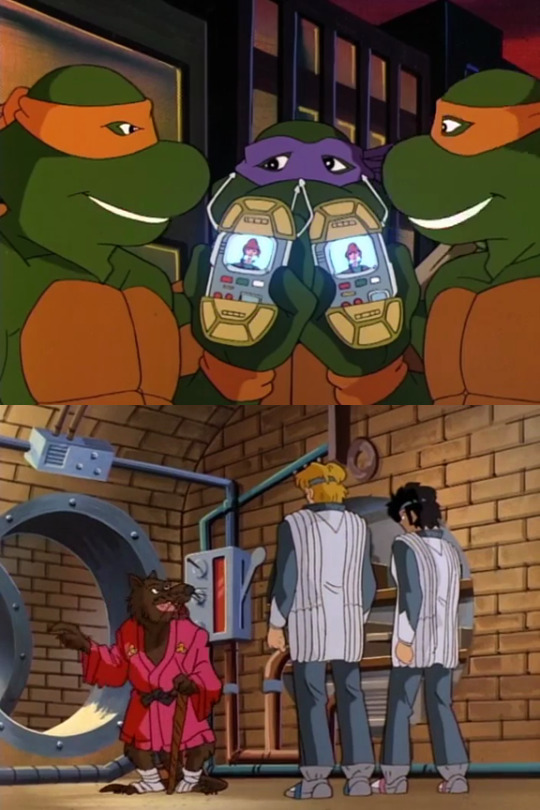
Via Turtlecom, April informs Michaelangelo – both of him – that Dregg’s forces have materialised not just in New York, but in cities all over the world. Carter leaves with one set of Turtles to confront the villain at the power plant, the others remaining behind to battle the rampaging mechs. Back in the Lair, Landor and Merrick arrive fashionably late, being brought up to speed about the unfolding situation by Splinter, who suggests April may be able to assist them in tracking the team down.
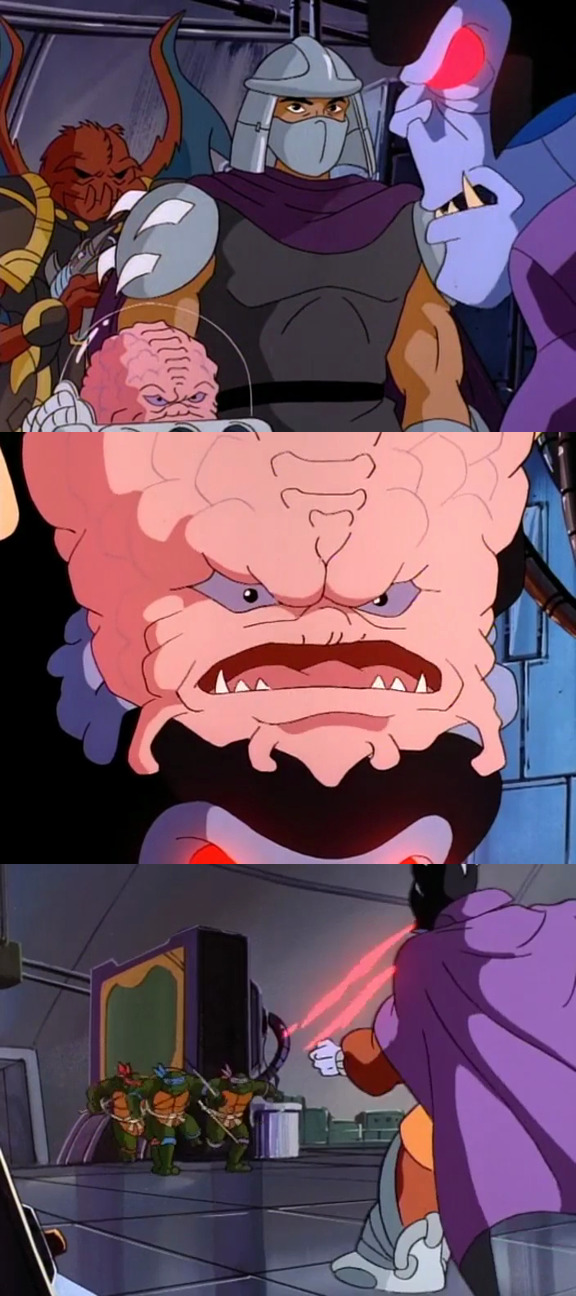
Shredder and Krang have the hypnotised bat trooper pretend to hold them at gunpoint, providing them with cover as they appear to be marched into the nuclear power plant. Feigning reluctance, Shreds hands the stolen chip back to Dregg. The villainous duo is marched toward the transporter, about to be sent to the Dreggnaut; in reality, the chip provided by Shreds is a fake, which Dregg picks up on due to knowing how Krang’s mind works after absorbing his intellect in the previous episode. (And yes, on paper it doesn’t make much sense that he can tell what Shredder would do because his mind contains a duplicate version of Krang’s thoughts, but as in the previous episode the idea seems to be that the two villains have worked together for so long that Krang knows exactly how Shreds thinks.) Dregg attacks the duo with his laser eye beams, takes “the real chip” back, and announces his intention to finish off both villains when the Turtles and Carter crash the party, gradually taking down the bat-men.
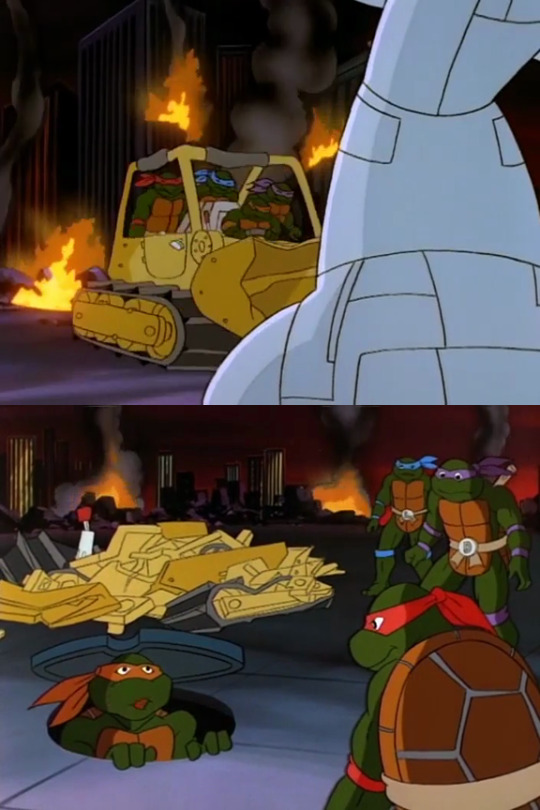
Out on the streets, the other set of Turtles – who as they don’t have Carter tagging along are presumably intended to be the ones from season eight, though it’s never outright stated – use a bulldozer in an unsuccessful effort to take down Dregg’s giant robots. Briefly, it appears that Michaelangelo has been flattened alongside the vehicle, but he emerges from a nearby manhole unharmed, the last time you’ll see this well-worn misdirect used in the series.
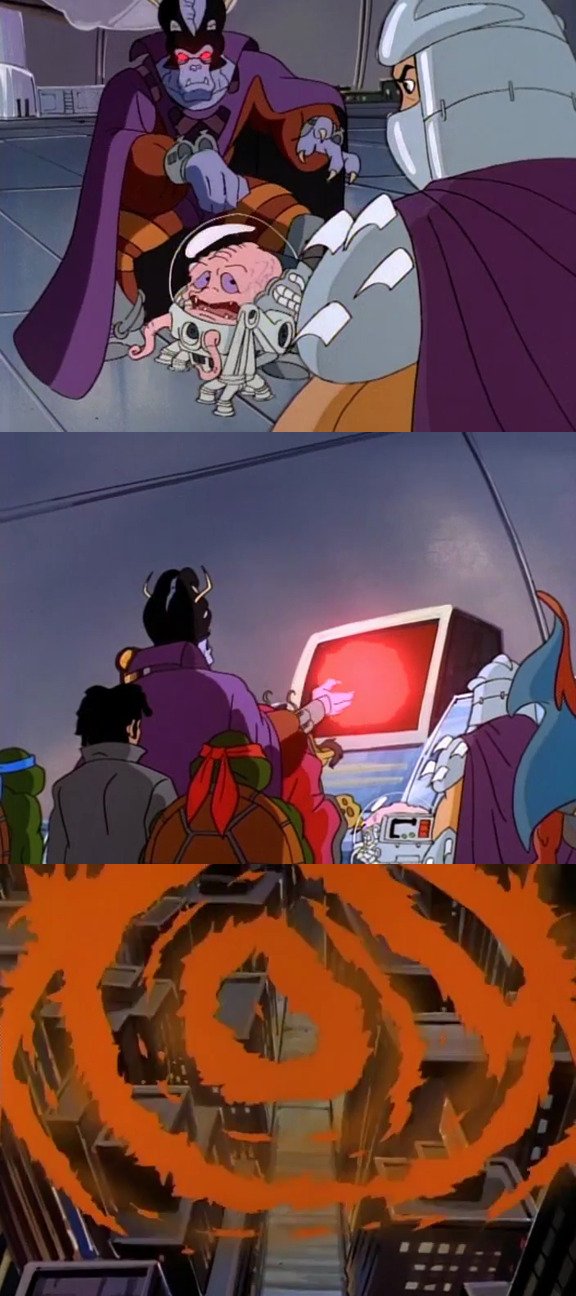
Back in the power plant, Dregg attempts to gain control in the jostling over the microchip by threatening to finish off Krang if Shredder doesn’t surrender. Donatello’s own sabotage efforts are also thwarted, the Turtles being held at gunpoint by the bat-men. Now fully in control, Dregg is ready to initiate his original plan and transport pieces of the sun into the world’s biggest cities. He begins doing so, to Carter’s audible horror, as the second act ends.
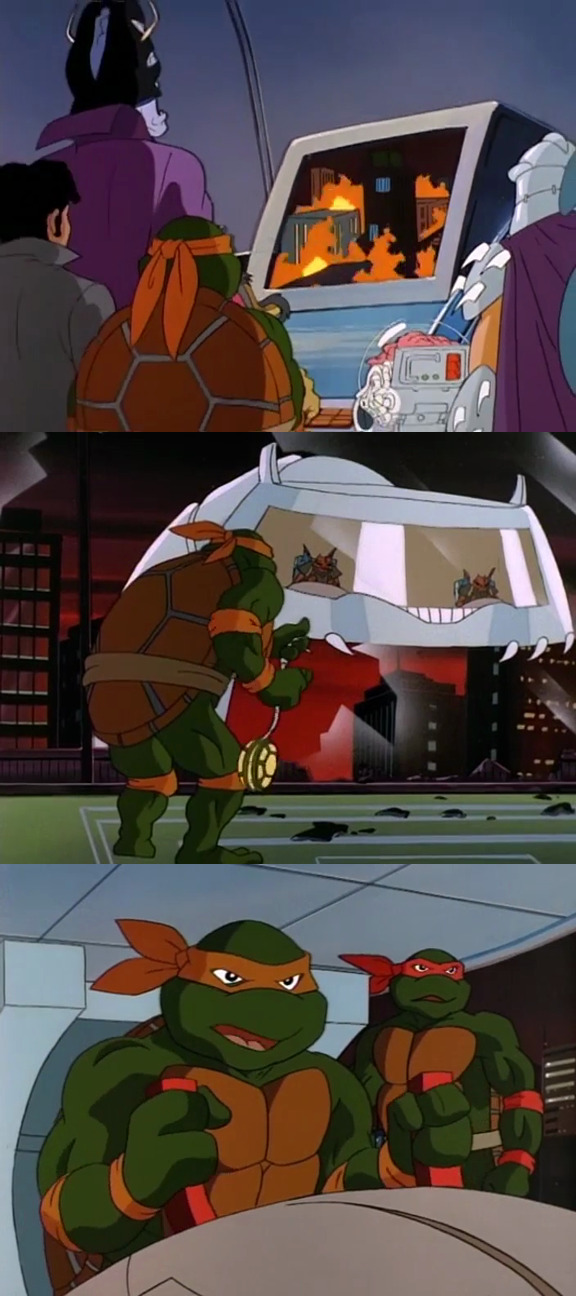
Act three opens with the Turtles, Carter, Shredder and Krang being made to watch as the results of Dregg’s plan are seen on a monitor, one city after another being incinerated as portions of the sun are transported. Even Krang, who in the past has been known to place little value on human life views this as a step too far, but Dregg remains unrepentant. Elsewhere, the other Turtles race to the top floor of an office building. From there, they leap into the cockpit of one of the mechs, tying up the bat minions piloting it and assuming control themselves.
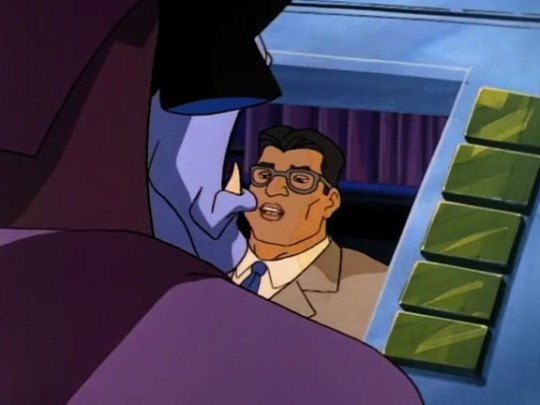
Moving on to the next step of his plan, Dregg demands to have a Zoom call with a member of the League of Nations, intent on threatening to destroy even more cities if control of the planet isn’t handed over to him. The dignitary who appears calls him out on his bullshit, pointing out that the planet’s major settlements are doing just fine thank you very much; as it turns out, Donatello re-routed the computer systems to instead create a virtual reality simulation of what it would look like if Dregg had went through with his scheme.

Seconds later, the other group of Turtles arrive in the robot they’ve commandeered, blasting through the wall of the power plant. Dregg has his microbots dismantle the machine, and is momentarily stunned when a second set of Turtles emerge from the wreckage. More sequences follow of our heroes working in stereo with their counterparts from the past, with the two Donatellos transporting Dregg’s robotic fleet to an asteroid elsewhere in the galaxy. Dregg again makes a play to teleport portions of the sun to Earth, for real this time. The two Donnies and a mutated Carter try in vain to stop this, but Mung presses the button to begin the process. One of the Donatellos reveals that this attempt, too, has been sabotaged: instead of sending part of the sun to a city on Earth, it’s re-located to the Dreggnaught, which is immediately destroyed. This has the unintended side-effect of overloading the transporter platform within the power plant, which now threatens to explode. The past and present Turtles work quickly, de-powering Dregg back to his normal state and dumping him – along with Shredder and Krang – in their respective dimensions before fleeing from the disintegrating facility.
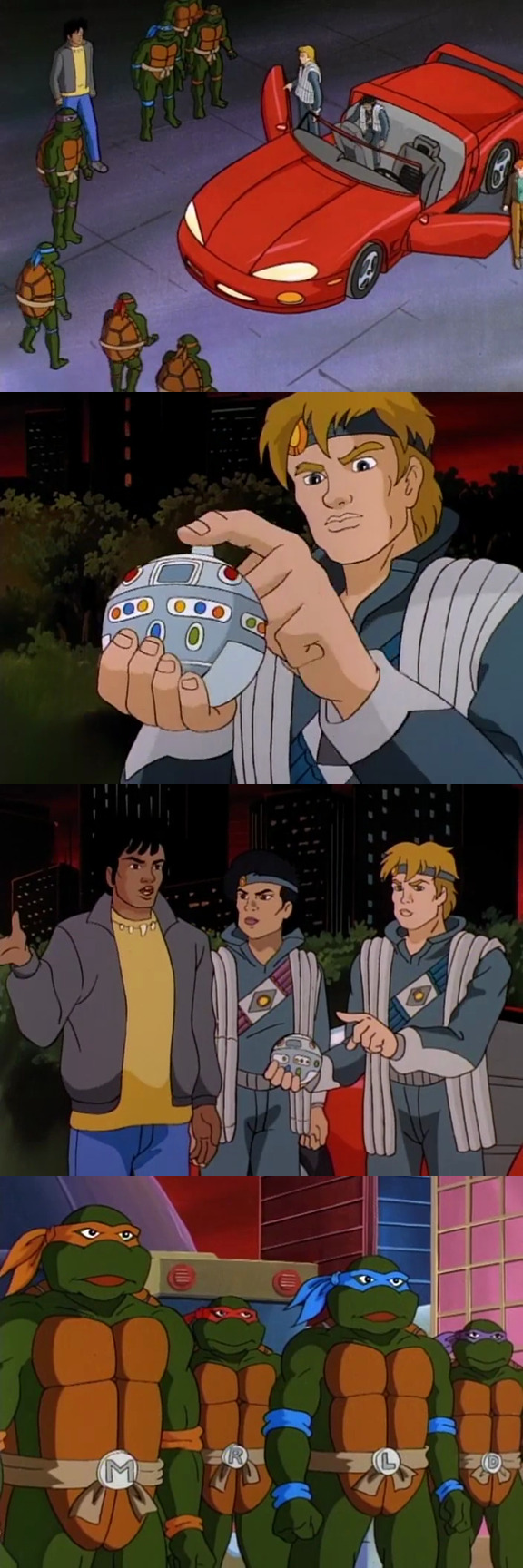
Outside, the Turtles face a further problem: only ten seconds remain before the consequences of the time warp paradox kick in. With oblivion beckoning for all of them, April pulls up in her sports car, accompanied by Landor and Merrick. The season eight Turtles are sent back to their own era to resume their battle with Shredder and Krang.
Carter uses this as an opportunity to announce – again - that he intends to go back to college to work on finding a cure for his mutation. Landor and Merrick suggest he instead travel with them to the future, where a solution may be found. After all three disappear, the Turtles just stand there, gawping, with nothing to say, and the episode abruptly ends. This is the last time we’ll see Carter in the show, and it’s incredible that this character, who I compared to Poochie in the Turtlethon entry covering his debut, ultimately makes his exit from the series with a full-on “I have to go now, my planet needs me” moment.
It’s highly tempting at this juncture to put the boot in, to say good riddance Carter, you won’t be missed. Really though, does it matter? The show would have likely continued on the same trajectory with or without him, still burdened by the interminable “new mutation” arc, the loss of TMNT’s key writer and several of its voice actors, and all the other largely ill-advised changes which have taken place since the end of season seven. I imagine the end point for TMNT would have still been season ten minus Carter, but the last two years of the run would have been a far more enjoyable watch if the focus had remained on the Turtles and the rest of the established supporting cast instead of devoting so much time to this new character. His exit coincides with the resolution of the unstable mutations plot for the Turtles, which won’t be brought up again in the short amount of time the show has left.
Perhaps it would have been fitting for TMNT to conclude with Shredder returning for one last encounter with our heroes, given that alongside Krang he was so integral to the series for much of its run. Both instead bow out here, mere supporting players in a storyline where Lord Dregg remains the main antagonist. There was an opportunity here for the pair to take a more proactive role in stopping Dregg at the climax of this episode, perhaps granting them a moment of redemption when pitted against a villain willing to do things that even they consider unspeakable, but the show just isn’t willing to follow through with such a grand gesture. It’s a problem that will pop up again before the series is done.
Dregg’s scheme in this episode – depicted as occurring during the story in what turns out to be merely an illusion, though it’s made explicit at the climax that he can and will try to go through with it for real – is easily the most horrifying act perpetrated by any villain in the show’s run, which if it had happened would have been a mass genocidal incident in which millions of people would have been instantly killed. Naturally the Turtles thwarted this, but it’s still jarring to see the 1987 TMNT cartoon, so often derided for its juvenile nature, even propose such a nightmarish scenario. If nothing else, it creates a challenge big enough that it justifies having two sets of Turtles running around.
Something not addressed in relation to the time travel aspects of this episode is that the knowledge the season eight Turtles have obtained about the events that will occur in the two years to come will surely affect the actions they'll take, and lead to things playing out differently: they now know in advance about the arrival of Lord Dregg, April losing her job, inventions yet to be created by Donatello and doubtless countless other things of which they had no awareness at the conclusion of “Turtle Trek”. Do the past Turtles, for example, prevent Carter from accidentally mutating himself when doing so would relieve him of his burden, but also erase the instances in which he was able to use his powers to save them? All of this could be explained away by assuming that the S8 Turtles had their knowledge of future events wiped, but there’s nothing in the episode suggesting this is the case and no precedent in previous TMNT time travel adventures for it either. Based on what we see unfold here, we can only assume the past Turtles now have some difficult ethical, borderline existential issues to grapple with.
“Turtles to the Second Power”, along with the two episodes which precede it, make for a creatively ambitious adventure that ties up a lot of loose ends as TMNT approaches the conclusion of its staggeringly long run. There are now just three adventures left, the next of which will provide a change of pace as we harken back to the early days of the show with an old-fashioned macguffin chase and the debut of one last gangster villain in “Mobster from Dimension X”.
#teenage mutant ninja turtles#tmnt#tmnt 1987#turtlethon#ninja turtles#1996#dregg#lord dregg#turtles to the second power
4 notes
·
View notes
Text
“A Turtle in Time”
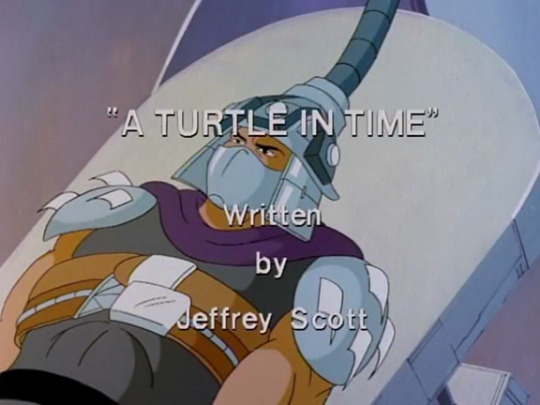
Season 10, Episode 4 First US Airdate: October 5, 1996
The Ninja Turtles of the past travel to the present to save the lives of their current-day counterparts.
The tenth season of Teenage Mutant Ninja Turtles continues with “A Turtle in Time”. This episode, written by Jeffrey Scott, is the second chapter of a three-part adventure which began with “The Power of Three”.
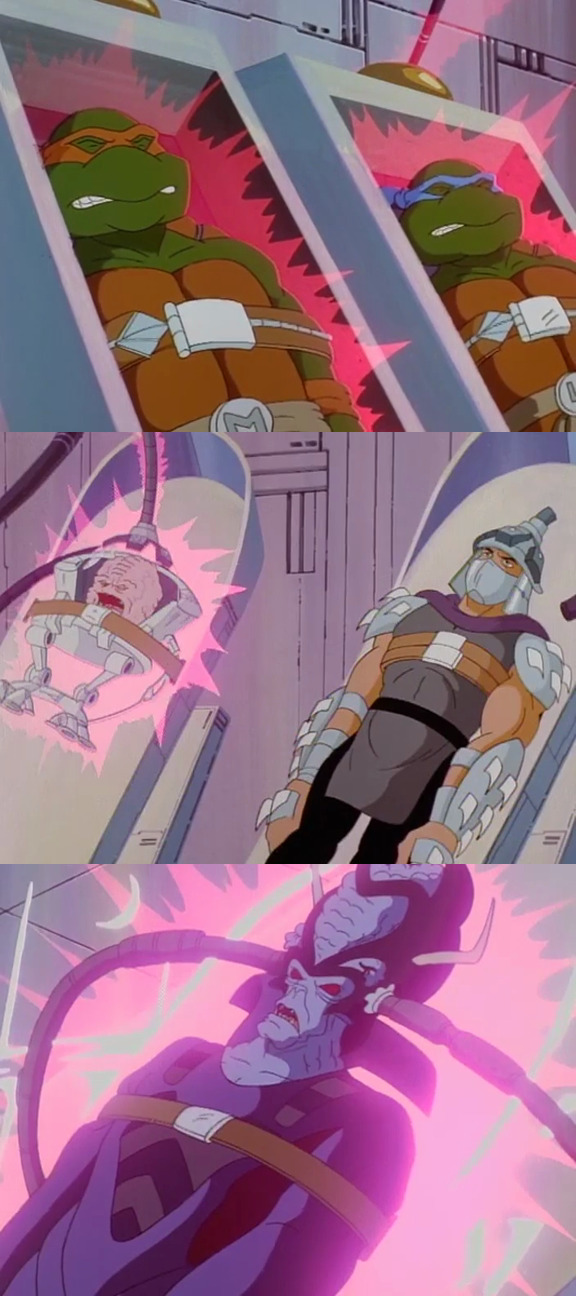
We begin with a “Previously on Teenage Mutant Ninja Turtles” recap that rushes through the events of the prior episode. Curiously, this is comprised of entirely new dialogue and animation rather than utilising clips from the show itself. After that we pick up where we left off, with Lord Dregg in the process of using the mutagen siphoned from the Turtles to absorb their power, while also robbing Shredder and Krang’s intelligence. Now bigger than before, and with a throbbing brain to signify his enhanced intellect, Dregg taunts the Turtles, informing them he can see their memories as well as Krang’s. The same can’t be said of Shredder, who used his gauntlets to sever his connection to the conversion machine before the procedure could take place.

With the transfer completed, the severely weakened Turtles attempt to take on Dregg, who in addition to absorbing their strength now possesses their ninja skills. After being defeated, the team are placed in a set of energy cages alongside Krang and April. Shredder, however, has gone missing, and re-emerges at an opportune moment to free the now-dying Krang. The pair go on to launch an attempt to escape from the ship. Meanwhile April uses her Turtlecom to reach Carter, informing him of their predicament.

Shredder is in the process of setting co-ordinates to return to Earth when Dregg arrives to stop him, his enlarged brain taking on the appearance of Krang to signify to us that a duplicate of the Dimension X warlord’s mind resides within his own. Given how much time Krang has spent with Shredder over the years, Dregg can anticipate exactly what Shredder will do. Shreds points out that despite this Dregg can’t read the minds of his own minions, and uses the carelessness of the bat-men to take advantage of one of them blowing a hole in the side of the ship: In the commotion that follows, he utilises the transporter to return with Krang to Earth. The two villains arrive in the nuclear power plant where Dregg had set up shop, fighting off more of his minions and covertly placing a control chip on a system motherboard as an act of sabotage before escaping.
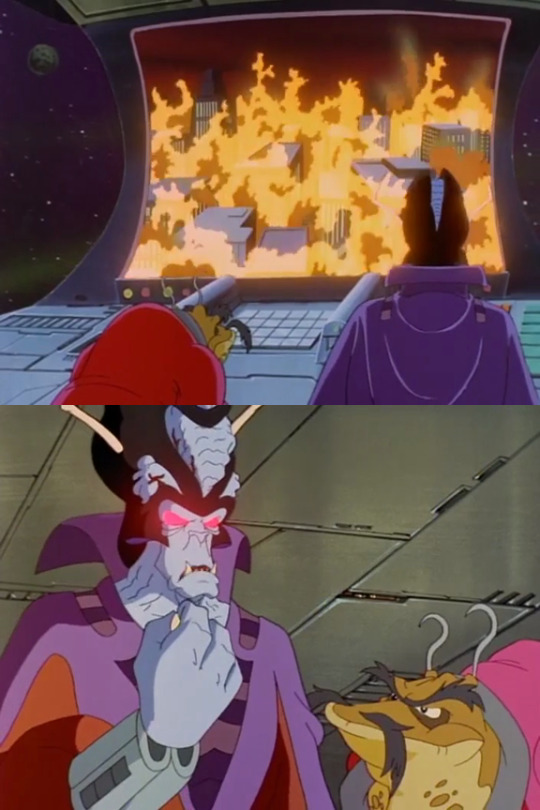
Back aboard his ship, Dregg draws upon the intellect of Krang to consider evil schemes he can use to take over the world. (This is an odd choice of action given that Dregg’s obviously been far more successful in both world domination and defeating the Turtles than either of his predecessors – we discussed this in a previous Turtlethon entry and I believe Shredder and Krang’s win/loss record over the course of the series was something like 2-120.) The show is fixated on virtual reality and simulations this season, and so Dregg has his computer display the results of a scenario in which the vortex transporter is used to transport a piece of the sun into the heart of Earth’s cities. Intent on holding the people of Earth to ransom by burning their cities, he reveals to Mung that if humanity refuses to comply, he’ll turn the entire planet into a second sun, before using the same approach on every other populated planet in the galaxy. The villain orders Mung to target “the largest city in the United States” - the show has never fully gotten over the aversion it picked up a few seasons in about outright saying that the Turtles live in New York – and the plan begins to be implemented as act one ends.

When we return, we’re... still workin’ on the plan, I guess, but Mung reveals that the vortex transporter isn’t working. Krang’s intellect informs Dregg that he’s underestimated the intelligence of Shredder, which is a very un-Krang-y thing to say given that he spent the first seven seasons of the show calling the guy a bonehead (or variations thereof) in almost every episode. Footage is relayed of Shredder taking the subspace amplification chip from the transporter’s motherboard, preventing anything being moved a distance greater than 1,000 miles. Dregg is furious, but Mung suggests an alternate strategy in which they instead dematerialise one hundred tons of steel from Earth’s structures, shipping it to the power plant where the microbots will use it to create an invasion force that can take over the planet.

Carter tracks the vortex transporter to the nuclear power plant. Sneaking inside, he teleports himself onto the Dreggnaught. The ally of the Turtles attempts to free them, but Dregg’s forces are too great, and so he returns to Earth to draw up a new plan. Elsewhere, Shredder fights off a pair of bat-men before breaking into a research lab, intent on saving the rapidly ailing Krang.
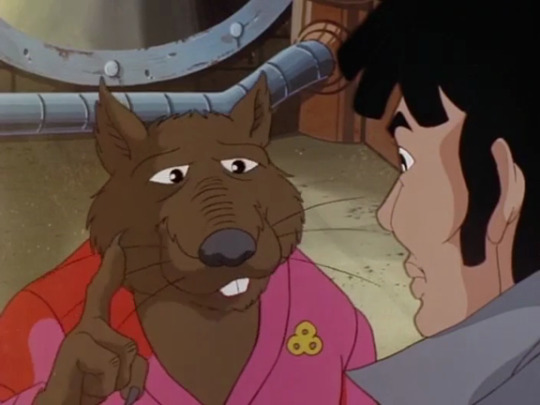
In the Lair, Carter laments the loss of his mutant powers, which would have been useful in fighting off Dregg’s forces to free the Turtles. Splinter points out to him that Donatello’s ray “only neutralised the mutagen”, his genes still permanently altered. The team’s sensei tells Carter that “when the power is needed, the power will be there”.

Seeing that the Turtles are gravely ill, April feigns being unable to breathe, tricking one of the bat-men who are acting as guards. After electrocuting him she frees the Turtles, cajoling them into a nearby ventilation shaft. Back in the Lair, Carter is still moping about his current situation until a conversation with Splinter encourages him to embrace the concept of time itself. Bouncing a radio message off a star 10,000 light years away – a trick he performs by looking up an internet search engine on Donatello’s PC – Carter summons Landor and Merrick, the resistance warriors who battled Dregg’s regime twenty years in the future in the season nine episode “Carter, the Enforcer”. He explains to the rebel duo that he needs to provide the Turtles with a transfusion from “four live mutant Turtles”. (The word “blood” isn’t used, presumably for the same reason that Morbius craved “plasma” in the Spider-Man cartoon around this time.) Since to my recollection there’s only one other living mutant Turtle in this continuity and it’s Slash, who hasn’t been seen since season seven, this presents a problem. The way Carter has elected to resolve this is hella convoluted and will require us to retread events covered in a previous Turtlethon entry, so bear with me as I break this down.
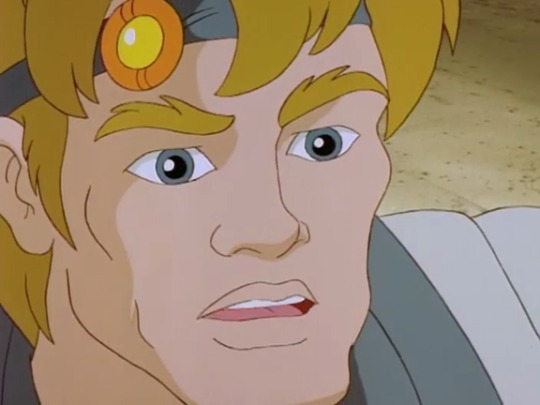
Carter asks Landor and Merrick to retrieve “the Turtles of the past” so that they can provide the necessary transfusion for their present-day counterparts. Because nothing’s ever easy and just to RAISE THE STAKES a little more, Landor explains that the presence of two sets of Turtles at one point in time will set up a time warp paradox – the past Turtles must be returned to their own time within 24 hours, or both groups of Turtles will cease to exist. Believe it or not, there’s something of an in-universe precedent for this as the green teens faced a similar predicament in season 5’s “Once Upon a Time Machine” when they travelled to the year 2036 to meet their future selves, risking the destruction of both the future and the past if they stayed too long.

Landor and Merrick head back to the climax of season eight’s finale, “Turtle Trek”. As you may recall, the Turtles were sent on a wild goose chase by an alien named Gargon who had secretly been manipulated by Shredder into placing the green teens in danger. After the Turtles were lured into the clutches of a tentacled monster in Dimension X, Shredder emerged from the Technodrome wielding an enormous cannon. He would go on to be defeated by the Turtles in the original chain of events but it’s here that we jump back into things, with the cannon being blown up as Mikey and Leo toss Shredder into the vat of glop. In a nice touch as these events unfold the instrumental version of the original TMNT theme song plays to emphasise that this is taking place in the past, although technically by this point in the series it had been abandoned.

Michaelangelo and Leonardo are understandably confused by the arrival of two strangers who at this point in the timeline they’re entirely unfamiliar with. Immediately events begin to diverge as Shredder pops up from the bottom of the vat with a huge bazooka – was he keeping it there just in case, in the goo? - and obliterates the platform the Turtles are standing on, forcing them to cling to the edge. Raphael and Donatello arrive to provide backup but are similarly perplexed by the two newcomers standing in their way. Before the time-travellers can explain the current situation Krang shows up, accompanied by a rifle-wielding Foot Soldier who knocks the other two Turtles off the platform. All four members of the team lose their grip, plummeting towards the ground as Landor and Merrick transport them out of danger and into the future.
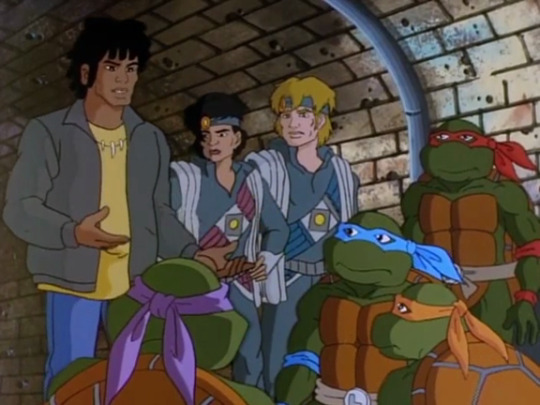
The Turtles of season eight arrive in the lair of season ten, where they’re introduced to Carter, who they’re yet to meet in the linear passage of time. Landor assures them that they will know Carter “in exactly two years and fifteen days”. It’s not clear if he’s implying that this is how long has passed between the end of season eight and now, or if it’s how long passes between their encounter with Gargon and first interaction with Carter. I’m inclined to believe it’s the former, as a two-year time skip between seasons eight and nine would be just... bonkers.
[NOTE: For the record, two years and fifteen days doesn’t add up to the amount of time between the original airdates of “Turtle Trek” and “A Turtle in Time”, the real gap being one year and eleven months. If we’re really going all-in on this and assuming the adventures of the Turtles have taken place in real-time, two years and fifteen days having passed is closer to the commencement of the Red Sky era in “Get Shredder!”, but hey, points for effort I guess – attempting to orchestrate this kind of thing accurately given the lead-times for television animation would be incredibly difficult.]

Landor and Merrick explain the current situation to the past Turtles, before leaving to return to their own time. Elsewhere, Mung and Dregg carry out their steel-theft scheme, destroying bridges and other structures. Back in the research lab, Shredder has provided a transfusion of his own life energy that has revived Krang, and the two begin plotting to strike back against Dregg. Unfortunately for them Krang’s bubble walker is one of the steel sources teleported away, as is the structure of the building they’re standing in, which begins to crumble around them. Act two ends with the past Turtles and Carter crossing a bridge as it teleports out of existence, causing the vehicle to tumble towards the water below.

We open the final act with the van landing in a trash barge, which luckily for the Turtles is heading in the direction of the power plant. Inside the facility Mung is seen ordering the microbots to convert the stolen steel into invasion craft for Lord Dregg, while aboard the Dreggnaught the present-day Turtles join April in seeking out the ship’s transporter room. By accident they instead end up in the fusion engine area, the vent shutting behind them and closing off their only means of escape: Donatello points out that should Dregg activate the ship’s engines, it’ll mean their certain demise.

Carter and the past Turtles infiltrate the power plant and use the transporter to board the Dreggnaught. The green teens find themselves face-to-face with Lord Dregg for what for them is the first time, an enemy that from their perspective in season eight they have no prior knowledge of. Carter intervenes to save Leonardo and Donatello from being blasted by Dregg, and after winding up in the line of fire himself manages to wilfully trigger his mutation. In the battle between the two that follows the engines are momentarily activated, only to be unwittingly shut down again thanks to the actions of the past Turtles.

Donatello instructs April to redirect the fusion stream into the engine wall, generating an explosion that blows a hole in the room, providing both her and the present-day Turtles with a means of escape. The resulting impact also temporarily incapacitates Dregg, allowing Carter to toss him inside moments before a second blast occurs.
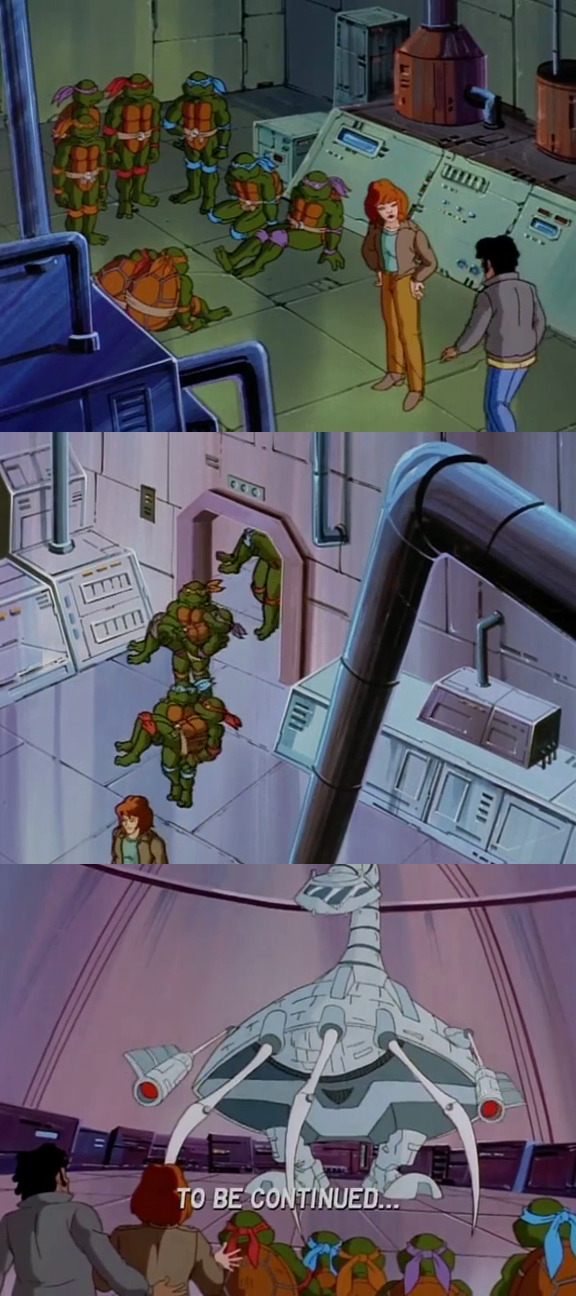
For the first time, the past Turtles come face-to-face with their present-day selves, carrying them onto the teleportation platform and back into the nuclear power plant. Far from being in the clear, both sets of Turtles, April and Carter find themselves face-to-face with the “invasion force” generated from the stolen steel: a gigantic, multi-pronged robot. As with the previous episode, we end today on a cliffhanger with the “TO BE CONTINUED...” caption appearing.
It feels premature to judge this story with one chunk of it still to come, and we’ve covered much of the ins and outs of the time travel aspect already. Instead, I think it’s worth focusing on the role of Shredder and Krang, who have been on the back foot ever since returning in the previous episode. While still antagonists, for us as viewers the good will they built over the first eight seasons of the show makes it difficult not to root for them, particularly when Dregg’s actions lead to Krang being on the verge of dying for much of this outing. While the show doesn’t dwell on it, we see a different side of Shredder here as he goes out of his way to save Krang from Dregg, something even more apparent later when he gives his old collaborator some of his own life force to save him: at this point, having lost the Technodrome, their Foot Soldiers and even Rocksteady and Bebop, all they have left is each other.
Next time on Turtlethon we’ll conclude this trilogy with “Turtles to the Second Power”, as we head into the final four episodes of the series!
#teenage mutant ninja turtles#tmnt#tmnt 1987#turtlethon#ninja turtles#lord dregg#1996#dregg#A Turtle In Time#landor#merrick#landor and merrick
2 notes
·
View notes
Text
Unhappy Hour News: A Turtlethon Update

Well it finally happened. After months of threatening that its removal was imminent, Tumblr axed the classic editor option for creating posts, forcing everyone to use its replacement. This presents an existential threat to Turtlethon in its current form, as the new editor only allows a maximum of 30 images per post.
My hope was that we could power through the series prior to the removal, or that the changeover would happen without the limit being implemented. Obviously things haven't turned out that way, and so we're now in an awkward situation where there's still about a season-and-a-half of the 1987 TMNT show to cover, but a roundabout way of doing things is required.
As it turns out, the night before this change went through I exported the entire blog, intent on mirroring it on a separate site as I knew this was coming sooner or later. I'll need to set aside some time to cobble something together, but I'm also fully aware that Turtlethon's readership is here, on Tumblr, and I want to ensure our journey through the series continues uninterrupted. To that end, beginning with tomorrow's entry ("The New Mutation") I've gone through the tedious task of stitching together all the screencaps to ensure we fly under the new image limit.
It's been clear to me for some time now that the social media version of the web that we've become dependent on over the last decade is beginning to crumble, and that we need to get back to running our own damn websites, where we don't have to worry that on any given day a faceless corporation can, on a whim, take everything from us. My intention is that eventually all of my writing - not just about TMNT, but also other cartoons, comics, art, music or anything else - will end up in one centralised place. Until then, we will perservere. Thank you for joining me in this continued exploration of the adventures of the Turtles - despite everything we will press on, with only thirteen episodes left to go!
3 notes
·
View notes
Text
“Dregg of the Earth”

Season 9, Episode 2 First US Airdate: September 23, 1995
Dregg uses a new base of operations to further his plans of taking over the world.
Teenage Mutant Ninja Turtles continues its ninth season with “Dregg of the Earth”. This episode was written by David Wise from a story by Mark Edens.
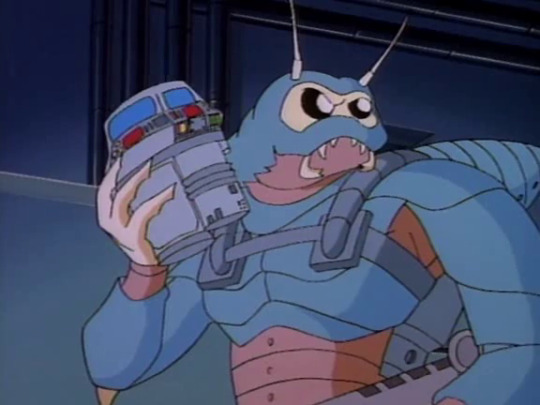
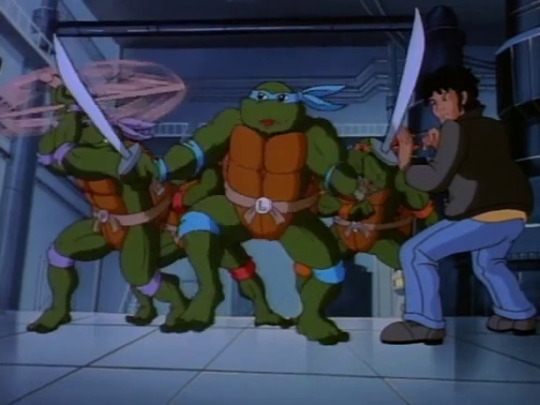
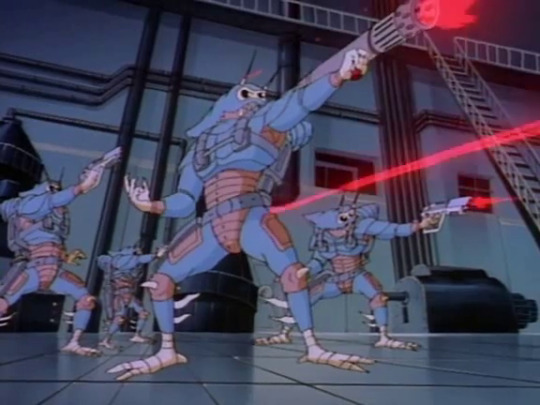

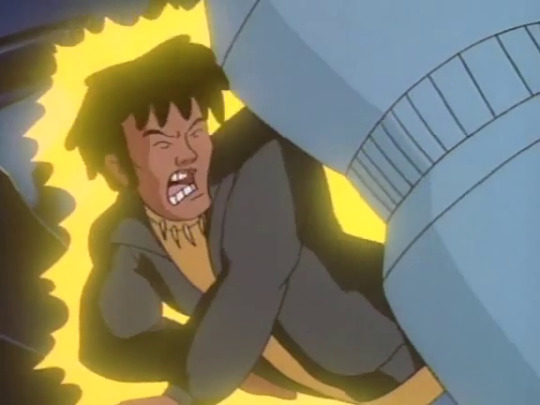
We kick off today’s proceedings with Lord Dregg’s TechnoGang attempting to steal a proton accelerator device from a scientific facility. The Turtles are on the scene and ready to stop them but have Carter tagging along, who insists on deviating from Leonardo’s agreed plan of action and comes out swinging against the aliens. As Dregg’s men make their escape, pursued by the Turtles, Carter finds himself pinned down under wreckage created during the battle, leading him to change into his mutant form.

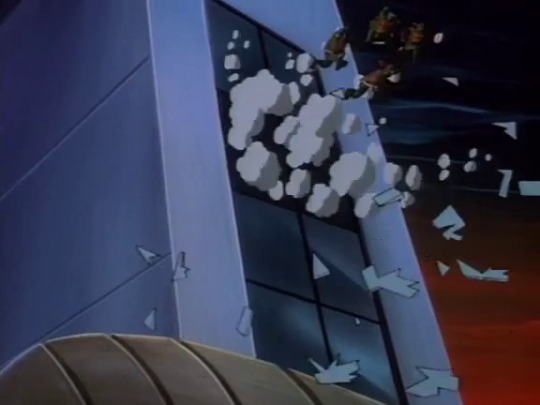



Mikey notes the arrival of “that weirdo again” as Carter bursts through the wall a la the Kool-Aid Man, demonstrating himself to be impervious to a blast from one of the enemy’s weapons before snapping it in two. The TechnoGang escape to their ship which is used to target the facility, the Turtles escaping seconds before it blows up. For the second episode in a row the team assume that Carter must have perished only for him to show up unscathed. As they did after the encounter aboard Dregg’s ship, the Turtles find Carter’s explanation for how he survived unconvincing, and scold him for botching the mission by not being a team player. The newbie doesn’t take this well, and rides off on his bike in a huff.

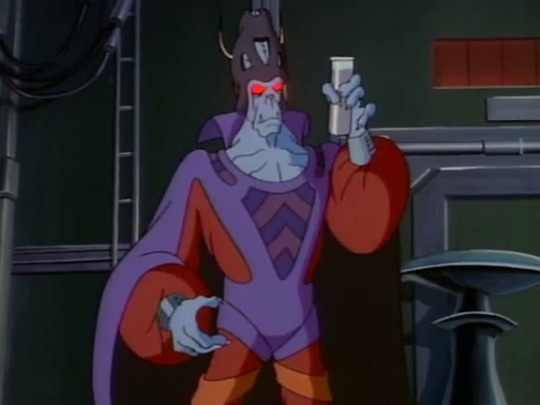
I guess Dregg has taken over the role of explaining the Scheme of the Day now that Krang isn’t around. He explains that his molecular converter device was damaged while escaping from the Galactic Patrol, but the stolen proton accelerator will allow him to repair it. A test of the machine demonstrates its ability to successfully purify polluted water. Satisfied, the warlord plans a trip to Earth.
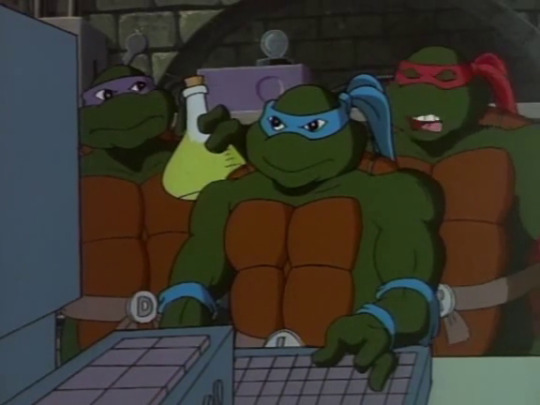

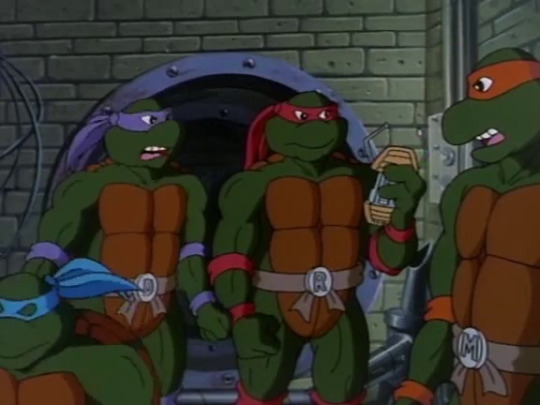
In the Lair’s workshop, the Turtles note the arrival of a huge spaceship in town – the Dreggnaught – while at the same time April relays the news that the mayor and members of the city council have agreed to meet with Lord Dregg. Donatello has an additional concern, as the beaker of left-over mutagen from their transformation continues to become more unstable, but that will have to wait, the group leaving to learn what their new foe is up to.


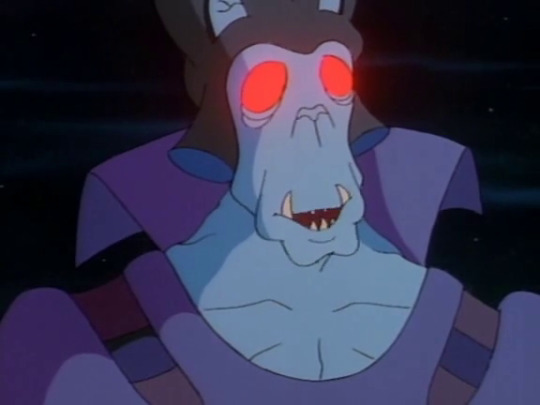
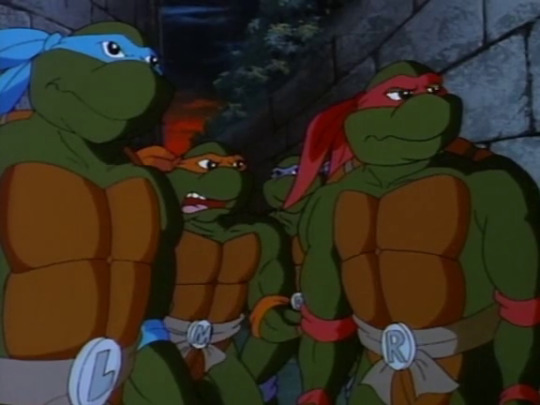
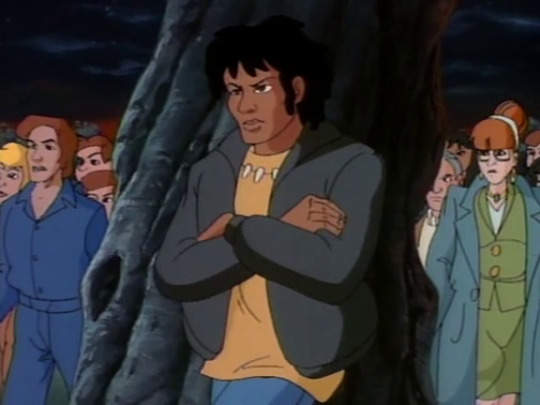
A crowd of onlookers assemble in a park to watch as the Dreggnaught descends. An unusually chipper-looking Dregg emerges on a platform, telling a story of how his own world was destroyed “by greed and war”, and that his mission involves saving Earth from facing a similar fate. He offers up the molecular converter as a means of eradicating water pollution, a goodwill gesture that wins over the crowd. Unimpressed are the Turtles, watching from a nearby alley, and Carter, viewing the event on his own.
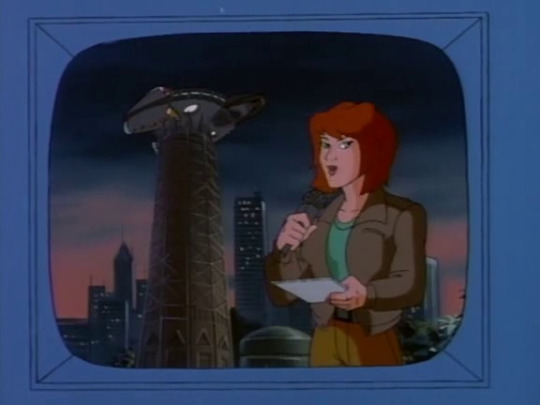

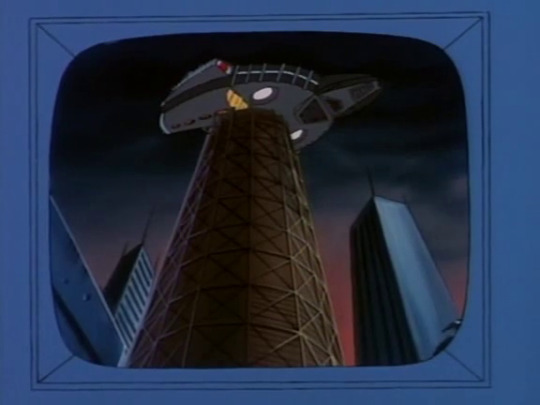


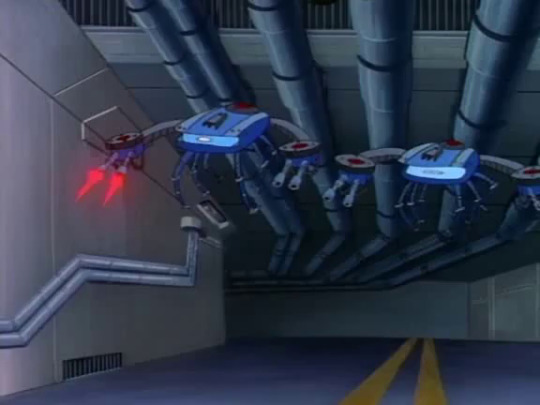
At this point we learn April is now an “independent field correspondent”, her ties to Channel 6 severed. This feels like it should be a bigger deal given the station’s prominence in the show over the years but winds up being a glossed-over detail as she brings us up to speed following a time-skip. Evidently Dregg’s PR initiative worked, the city taking a shine to him and renaming its newest skyscraper “Dregg Tower” in his honour, a site that he intends to turn “into a citadel of science for the good of mankind”. The Turtles watch this report and remain suspicious, deciding to investigate what the alien is up to. Gaining entry via a hatch connected to the sewer system, the team soon find themselves confronted by a group of armed drones.

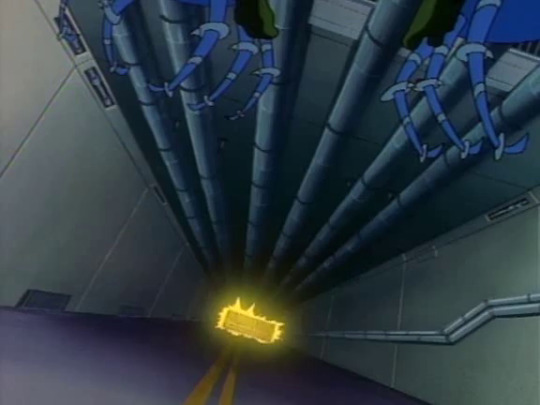
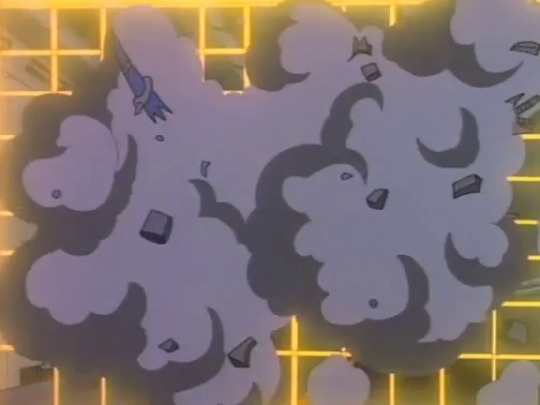

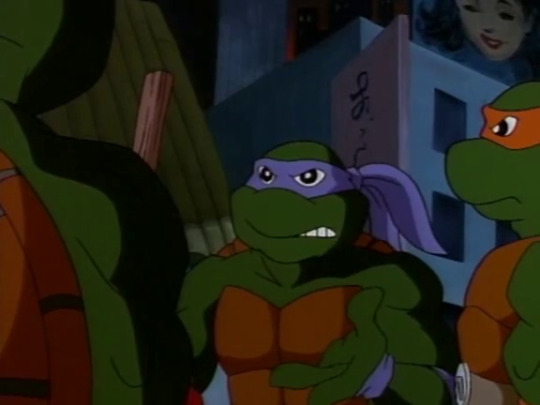

After disarming the drones, the Turtles ride them through the building, eventually coming face-to-face with a “neural net” energy grid. A hatch in the roof provides a means of escape, but leads them back onto the city streets. The Turtles discuss trying to find another means of gaining entry as Carter – who remains on the outs with the team – listens in from nearby.

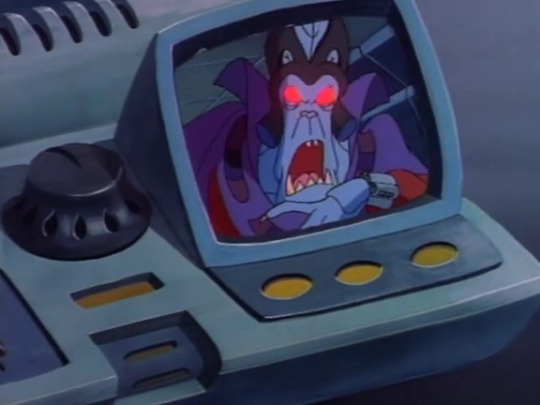
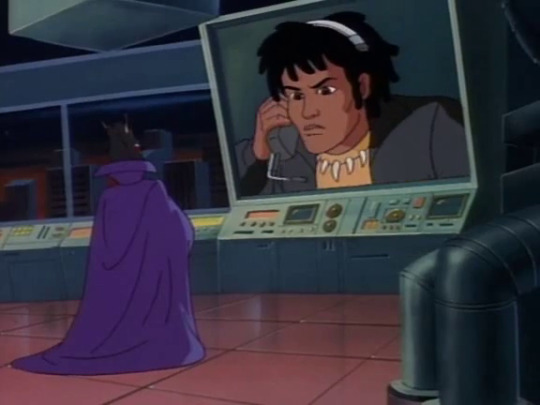

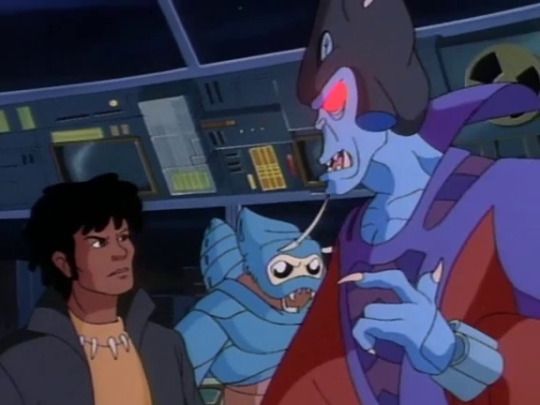
Improbably, Carter uses his super computer skills to initiate a Skype call with Lord Dregg. He tells the warlord he can identify a winning side when he sees one, and that he has information that may be of use. A meeting is arranged behind Dregg Tower in which the youth is surrounded by a group of TechnoGang troopers. After defeating them in battle, Carter is told by Dregg that he successfully made it through his initiation, and is taken to the executive suite. In the meeting that follows, the estranged ally of the Turtles agrees to lure them into a trap.
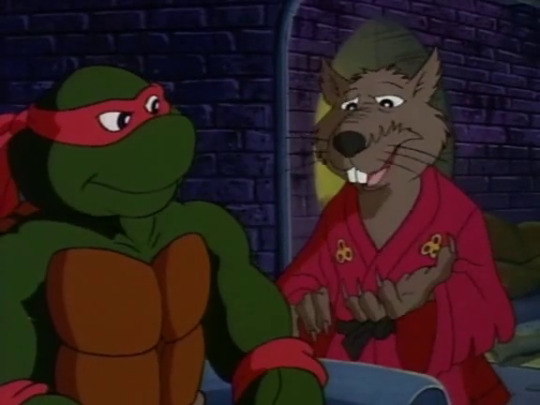


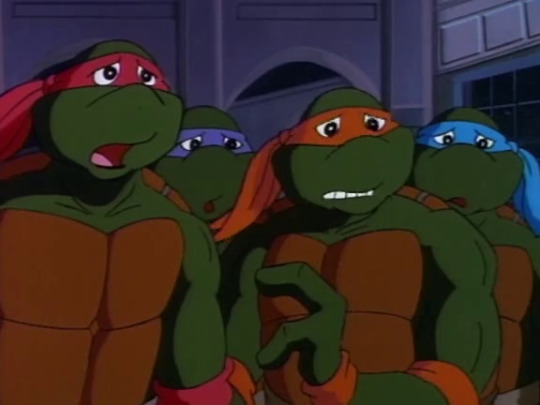
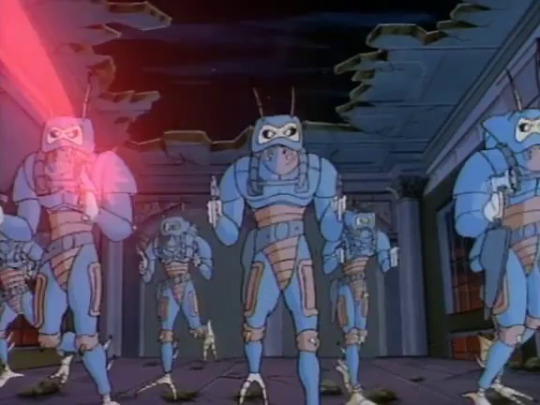
Splinter encourages the Turtles to patch things up with Carter moments before the teen contacts our heroes via Turtlecom. He arranges a meeting with them at an armoury, insistent he can get them into Dregg’s building. April is informed of this, and drives to the location to watch events unfold. It doesn’t take long before HiTech and the Technogang emerge, and the Turtles determine that Carter has double-crossed them.

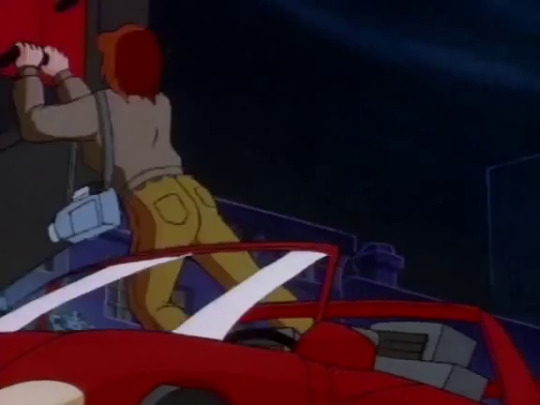

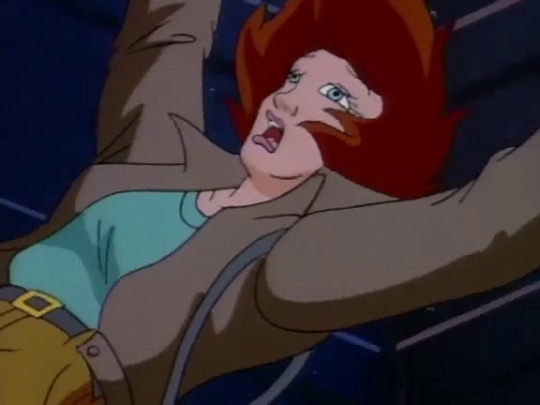
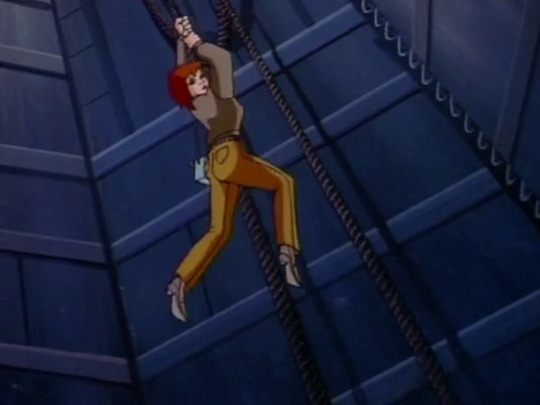
The Turtles find themselves outnumbered and are marched out of the armoury by the Technogang, an event watched from nearby by April. She follows the departing ship, leaping out of her car and dangling behind the spacecraft as it returns to Dregg Tower. After the ship reaches its location, the reporter loses her grip, and instead winds up clutching a cable in an elevator shaft.
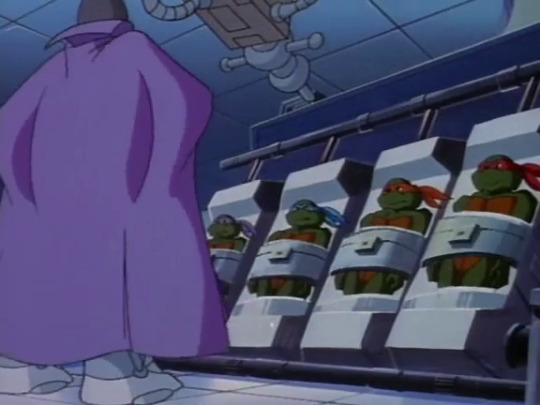
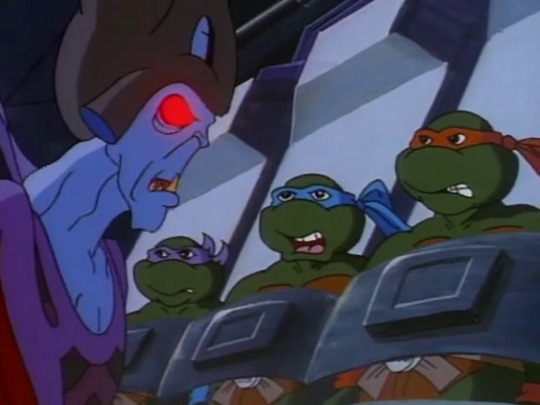
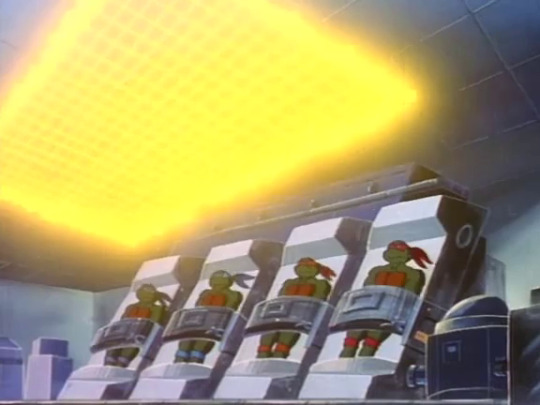
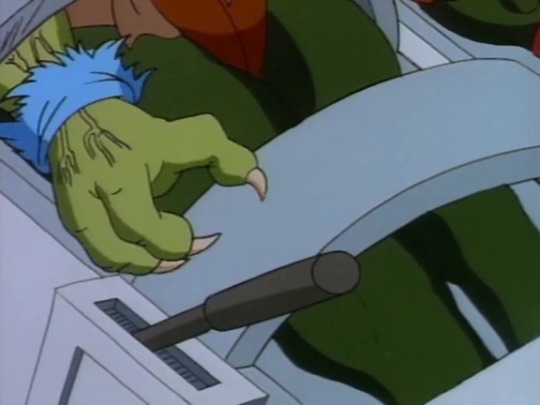


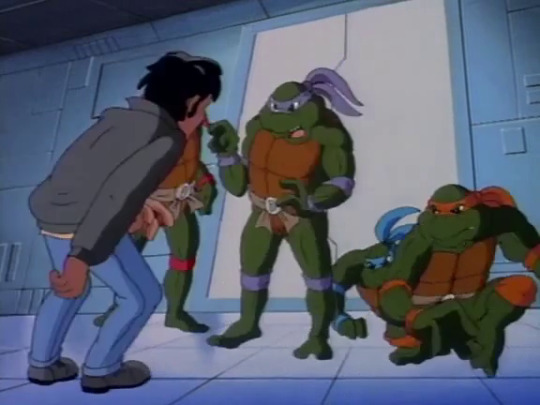
Dregg tells the captured Turtles that Carter was eager to sell them out, and encourages them to do the same. “You’re mutants, freaks, outcasts of society. You have no loyalty to those... humans.” After refusing this offer, the team are told they’ll be eliminated, the neural net they encountered earlier now lowering from the roof. Following Dregg’s departure Leonardo struggles to reach a lever that looks like a means of escape. As he continues to writhe, his hand becomes veiny and clawed, as does Raphael’s. This passes, and moments later Carter emerges to free the team. After the group escape Carter reveals his betrayal was a ruse, and that he’s learned of Dregg’s true intentions, the entire tower set to be refitted into an armed fortress.
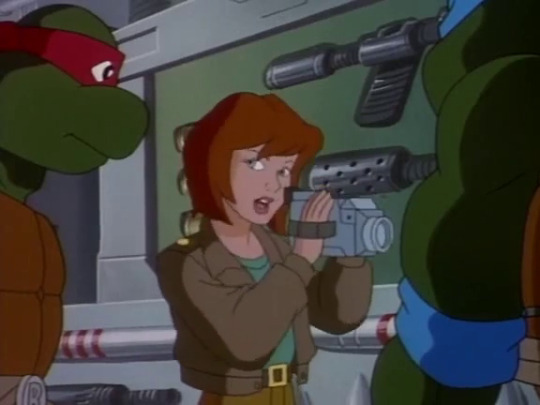

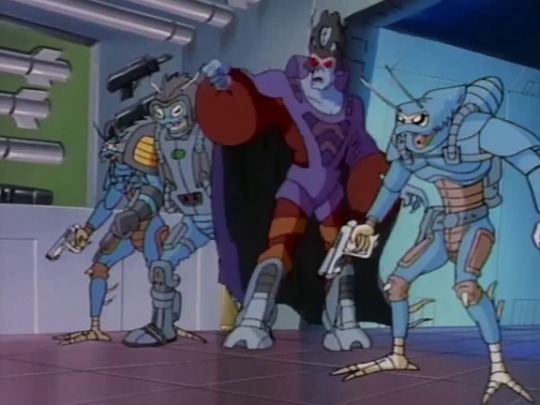
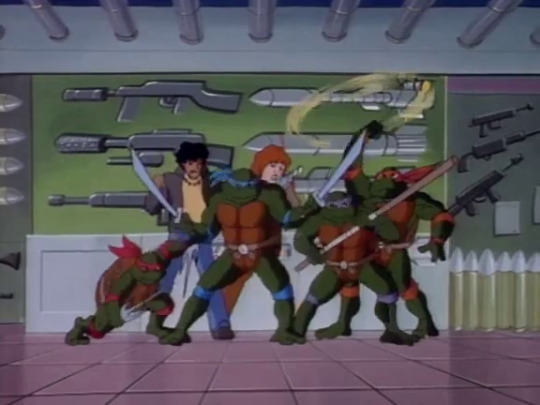

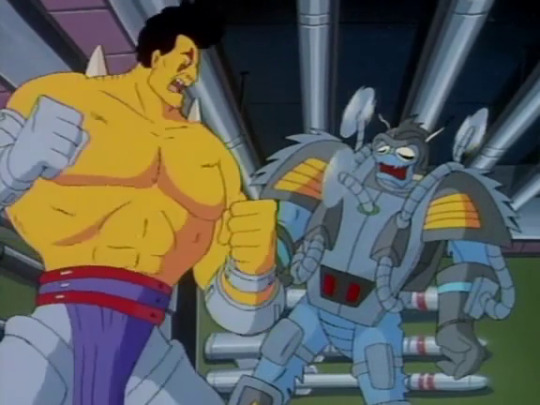

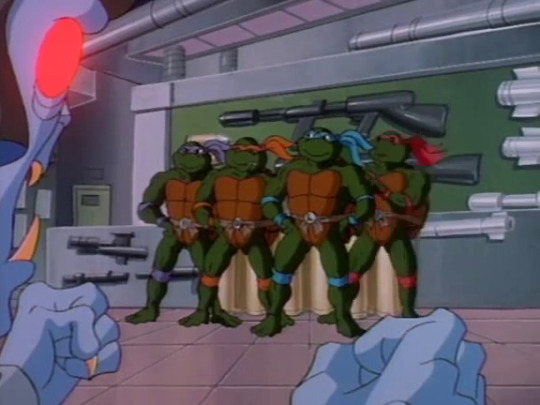
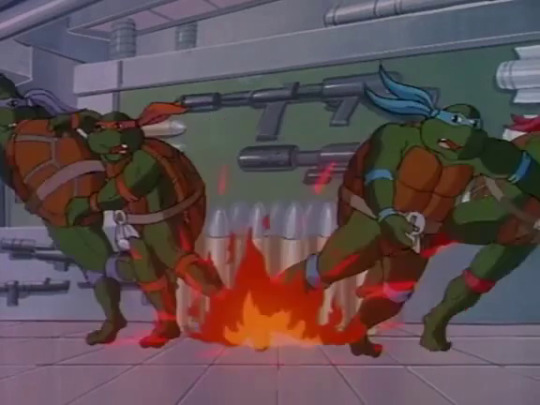
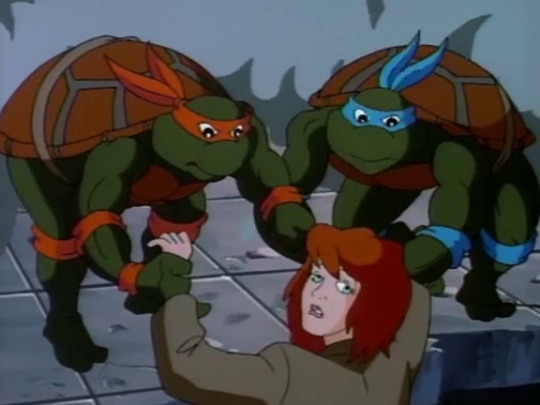
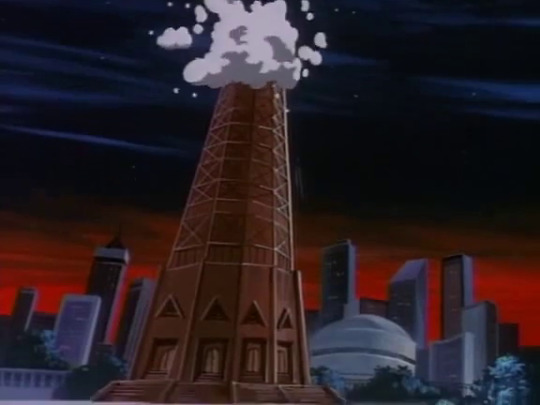
April apparently lowered herself into the basement, and takes this opportunity to radio the team, informing them that the location contains an enormous arsenal of weapons. It doesn’t take long for the Turtles to head there and begin plotting to set off a chain reaction that will destroy the supplies. Before they can do so Dregg emerges, accompanied by his TechnoGang. In the ensuing battle Carter transforms into his mutant form, to the astonishment of the Turtles. This helps turn the tide of battle, the Turtles soon goading Dregg into fighting them near the weapons supplies. The warlord shoots energy beams from his eyes that accidentally hit a stack of missiles, the resulting damage threatening the structure of the tower. As Dregg and his men escape April is separated from her camera, the only evidence of the villain’s true intentions, but there’s no time to worry about that: the Turtles, April and the mutated Carter are forced to evacuate. Seconds later, the entire tower explodes.

In the Lair, Carter explains the circumstances leading to his transformation, which the Turtles speculate may provide a link to the signs that their own mutations are becoming unstable. It’s pointed out to Splinter that this may affect him too, and the group agree to face whatever will come as a team.
“Dregg of the Earth” is easily the most insubstantial episode of TMNT I’ve watched in quite a while. I get the feeling that season nine has been structured in such a way that each show is intended to serve as a chapter in one larger, ongoing story, rather than as self-contained adventures. It’s a world away from the heyday of the series, where continuity was almost a dirty word, the demands of producing a near-endless supply of new Turtles episodes for syndication meaning that each tale had to be confined to one twenty-two-minute outing in case things aired out of sequence. With season nine comprising only eight episodes to air across as many weeks, here we get drip-fed an ongoing tale that incentivises viewers to keep coming back. In theory that’s a good thing, but today’s story feels like we’re spinning our wheels a little, with the promise that maybe next time there’ll be a pay-off to this unstable mutation bit as Carter and Dregg both go through largely the same motions as in “The Unknown Ninja”.
There are, at least, some signs of potential here. The idea of Dregg positioning himself as an altruistic figure versus the renegade Turtles could salvage the idea of Channel 6 turning public sentiment against the team from season eight, something that was cut short before it could be fully explored. Somewhat related is the revelation that April no longer works for the station, and we can only speculate as to whether she left (having perhaps had enough of Burne’s vitriol), was fired, or if the accumulated misfortunes that the broadcaster faced proved to be too much – perhaps Milton Frobish II finally stepped in and pulled the plug. This is one of those situations where events happening off-screen are more intriguing – at least, to me – than what’s made it into the show thus far this season.
So far season nine’s been underwhelming. We’ll see if the writers can turn things around next time as we encounter “The Wrath of Medusa”.
#Teenage Mutant Ninja Turtles#TMNT#TMNT 1987#1995#Ninja Turtles#Turtlethon#Carter TMNT#TMNT Carter#Lord Dregg#Dregg
2 notes
·
View notes
Text
“The Unknown Ninja”
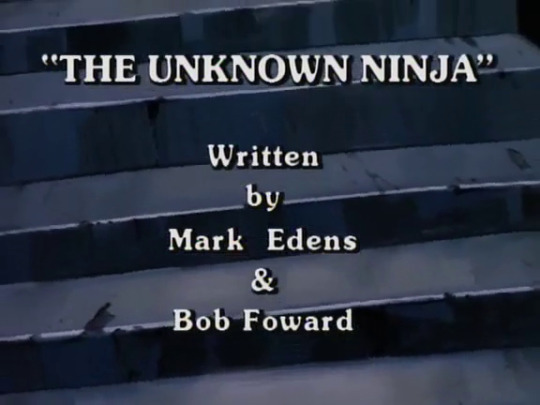
Season 9, Episode 1 First US Airdate: September 16, 1995
The Turtles encounter an alien warlord and are monitored by a mysterious stranger.
“The Unknown Ninja” is the first episode of Teenage Mutant Ninja Turtles season nine. Mark Edens – a contributor to the series going all the way back to “Camera Bugged” - returns after a six-year absence for this collaboration with the debuting Bob Forward. This is the first episode of the show not written by David Wise since season seven’s “White Belt, Black Heart”.
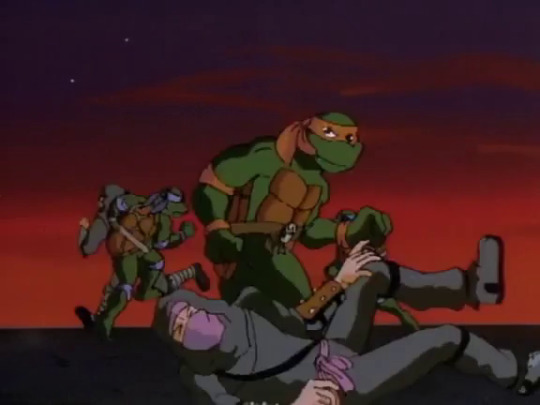
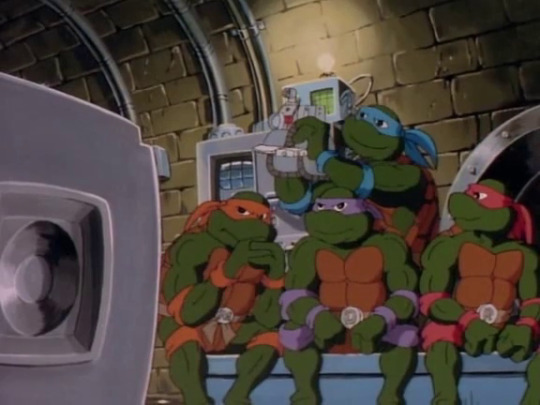
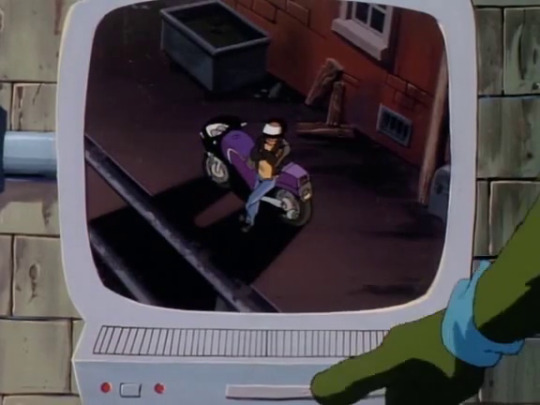
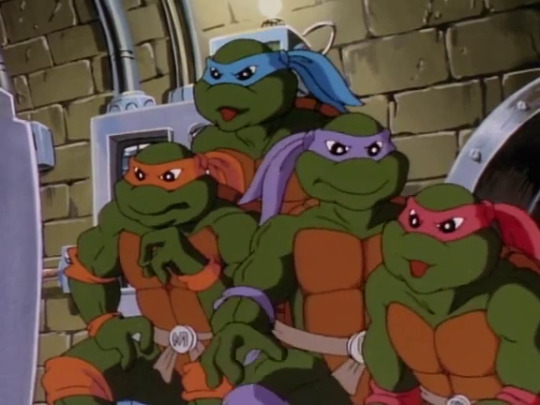
Season eight marked a dramatic reinvention of TMNT and much of that is carried over to this year, including its clumsy, half-hearted title sequence. However, the art style used for the 1994 episodes may have met with a negative reception as the look of the Turtles has now changed again, the team now drawn in a simpler, wide-eyed style that seems to be trying to strike a balance between their look in the classic era of the show with their initial edgy Red Sky makeovers. We open with the green teens reviewing footage of a prior battle against a group of the same ninjas who worked for Megavolt in “State of Shock”. Donatello documented this encounter using a head-mounted camera, unimaginatively dubbed the “Turtle-Cam”. Raphael notes that in the background of the footage an onlooker riding a motorbike can be seen nearby, a stranger that he had spotted during their last few missions, and the group begin to wonder if there’s something to this.
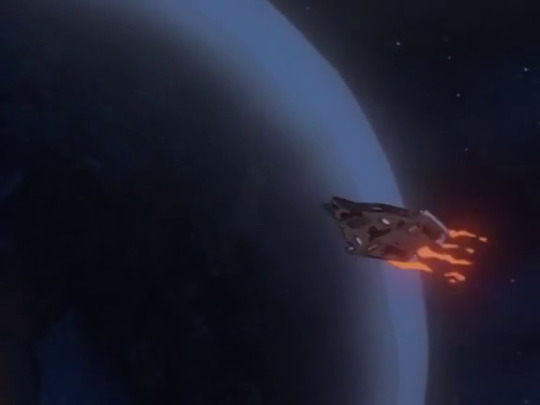
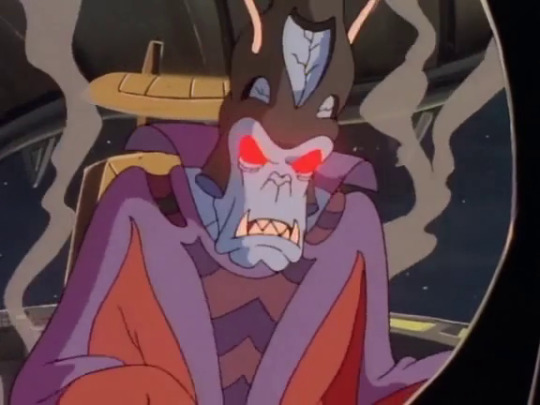
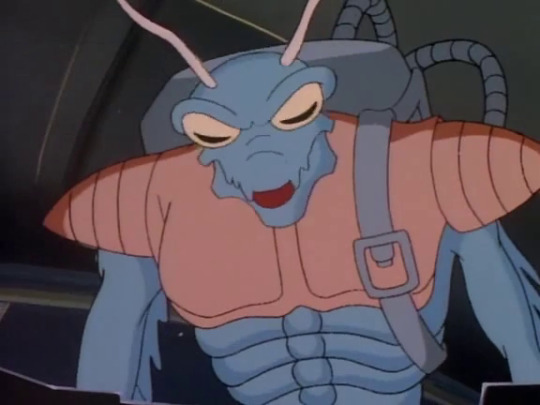
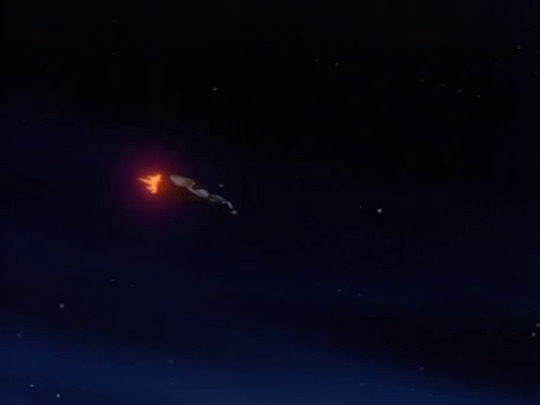
Above the planet, a portal opens. From it emerges a large spaceship containing Lord Dregg (Tony Jay), who has arrived in our corner of the universe while attempting to evade being captured by the Galactic Patrol. His insect-like underling HiTech informs him that Earth contains supplies of the gold that they require, and so the villain orders that his TechnoGang are tasked with retrieving it. A smaller ship emerges from Dregg’s, ready to commence the mission.
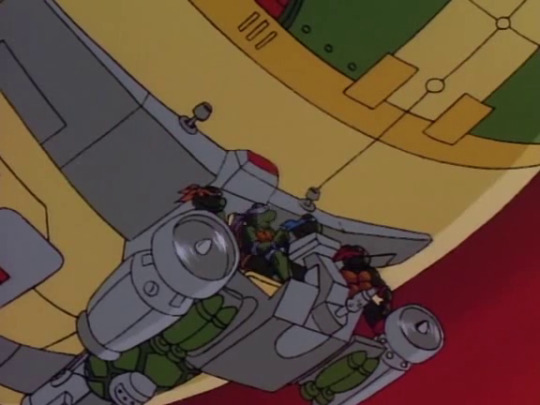
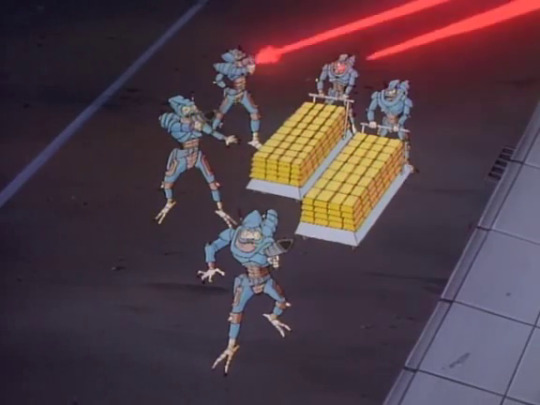

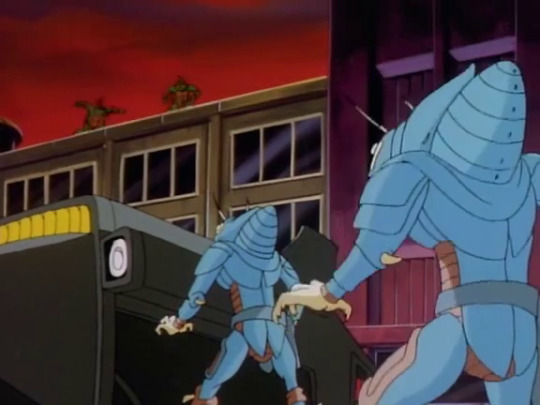
The Turtle Blimp makes an unexpected return to the series after an extended absence as the team survey the area, attempting to track down whoever was watching them (a hell of a task given that there were 7.3 million people in New York in 1995, and as that the stranger was wearing a bike helmet they don’t even know what he looks like). Along the way, the Turtles spot someone blowing up the entrance to the Federal Reserve vault, and swoop in to intervene. A group of Dregg’s bug troopers, the TechnoGang, emerge and shoot down the glider, forcing the Turtles to leap onto a nearby rooftop.
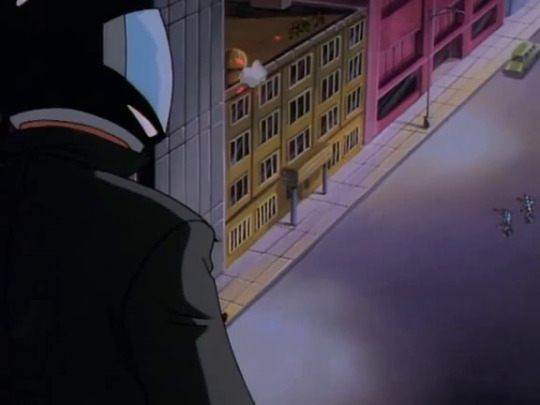
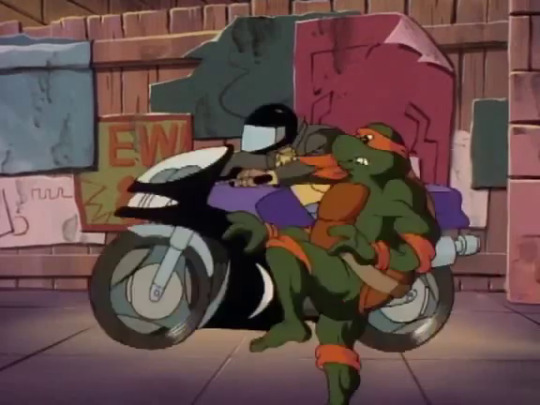

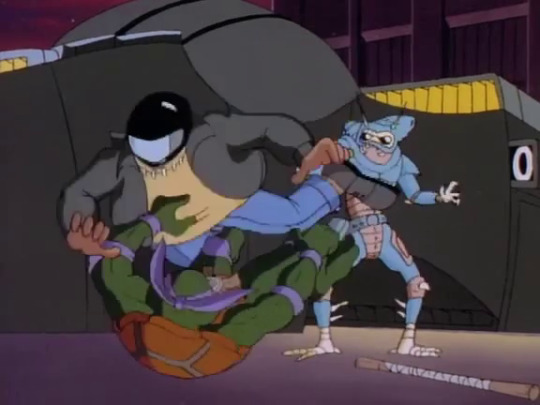


Watching again is the mystery biker, who rides in and prevents the Turtles from being hit by a laser weapon mounted atop the TechnoGang's ship. The stranger continues to meddle in the affairs of our heroes, kicking Donatello to the ground as he does battle with one of the invaders. Ultimately the TechnoGang retreat in their ship without the gold, the biker also escaping.


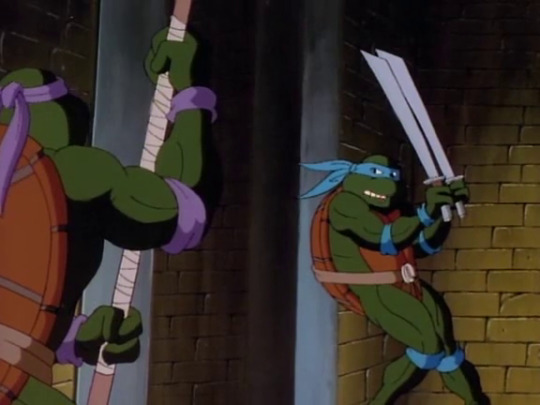

Back in the Lair’s workshop we kick off a new sub-plot, as Donatello examines a beaker containing some of the mutagen which caused both the Turtles and Splinter to take on their current forms. Years on, the ooze is now beginning to become unstable, something that Donnie warns suggests the team could continue to transform. The Lair’s warning systems alert our heroes to the impending arrival of an intruder: It’s the biker again, riding around in the sewers.
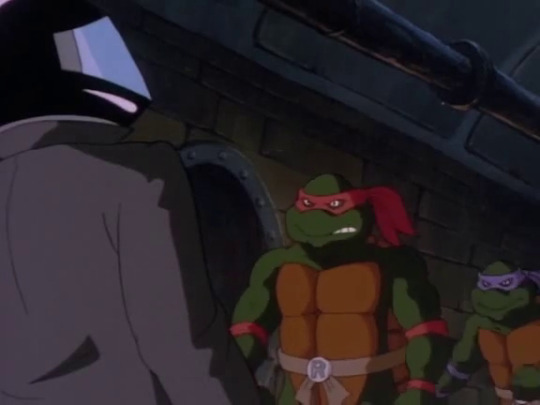

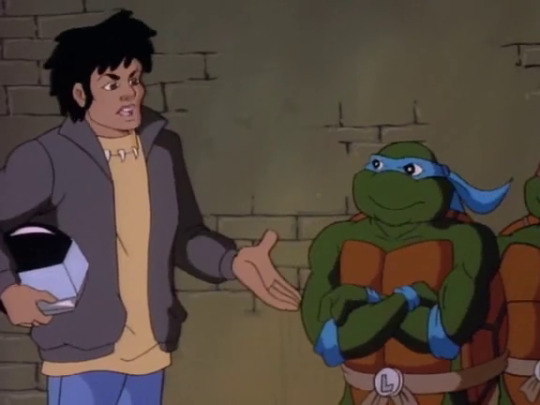

After being cornered by the Turtles, the mystery man is forced to remove his helmet and reveal himself. The team are introduced to Carter, the new character being introduced in a desperate attempt to boost low ratings. Half Joe Camel and a third Fonzarelli, he’s one outrageous dude who’s totally in your face. From the outset he’s presented as having outsmarted the Turtles, tracing them back to their Lair despite their best efforts to remain unseen (something Shredder and Krang were unable to do despite eight whole seasons of trying). Carter asks to meet Hamato Yoshi, having determined that the fighting technique used by the Turtles could only have been taught to them by him. The Turtles remain hostile until Splinter intervenes, revealing to the youth his former identity. Splinter agrees to teach Carter the ways of the Foot, and just like that the series has found its Scrappy Doo.
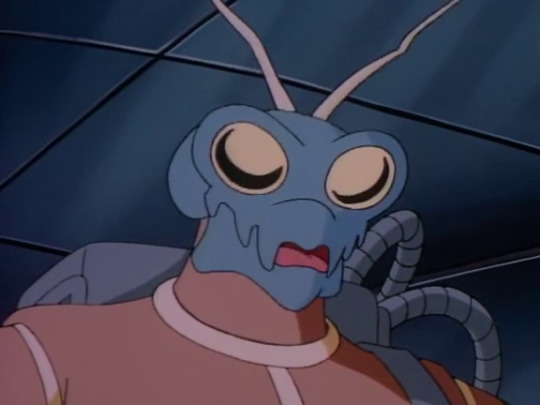

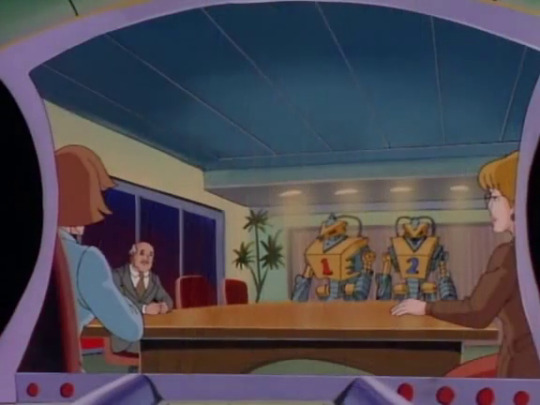
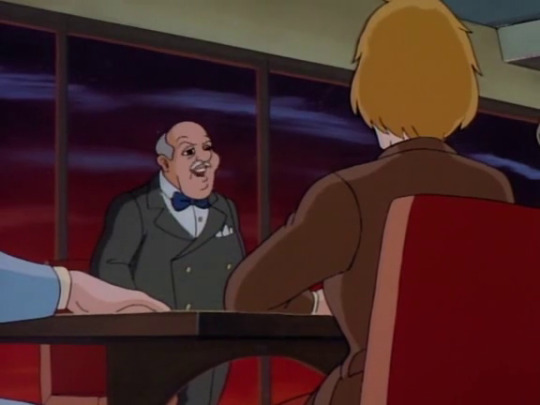

Aboard his ship Dregg is informed by HiTech of the failure of the TechnoGang's mission due to the intervention of the Turtles. Seeking a way to rebound, he looks in on a boardroom at a firm called CopCore, where two robots are being unveiled. What follows is a beat-for-beat recreation of the scene from Robocop where ED-209 was introduced (albeit with a far less gruesome conclusion) as a man announces the rollout of The Intimidators, “the future of law enforcement”. There’s a hint of Minority Report thrown in here too – perhaps a nod to the original novella, but certainly not to the movie, which was still several years away – as we’re told the robots use neurological sensors to “detect criminal intentions and actually prevent the criminal from committing the crime.” Everyone in attendance has a good laugh when the robots begin issuing warnings, thinking it’s all a big show, but the bots soon begin to warn that the group have five seconds to comply, opening fire with their in-built weapons and blowing a hole in the wall.
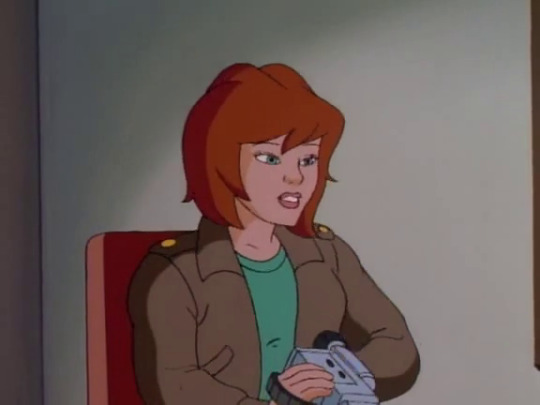
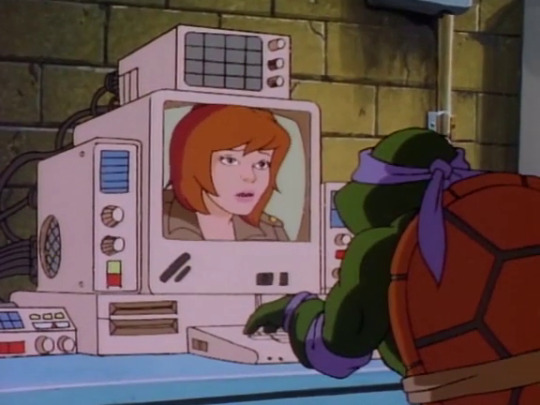

Sitting in on this meeting is April, who like the Turtles has received a makeover for the second year in a row. There really wasn’t anything wrong with her season eight design but this revision is disastrous, her facial features now simplified and oddly doughy, coupled with a new limp hairdo that I assume was intended to keep her looking contemporary heading into the second half of the nineties but it absolutely does not work. Sneaking out of the room, she uses her Turtlecom to reach Donatello, and the team rush to her aid in the van. Carter is keen to join the Turtles but is told to stay behind and watch how things play out via the Turtle-Cam. Already he’s pissing and moaning, frustrated at being denied a piece of the action.

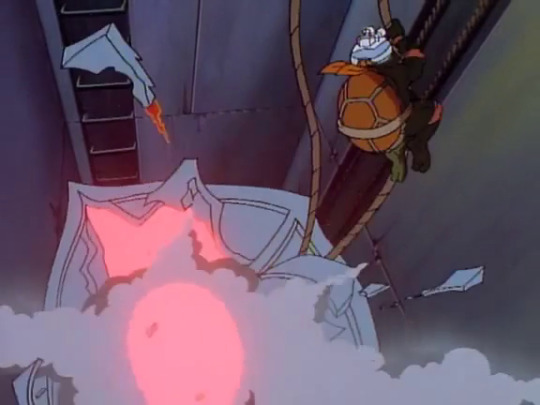
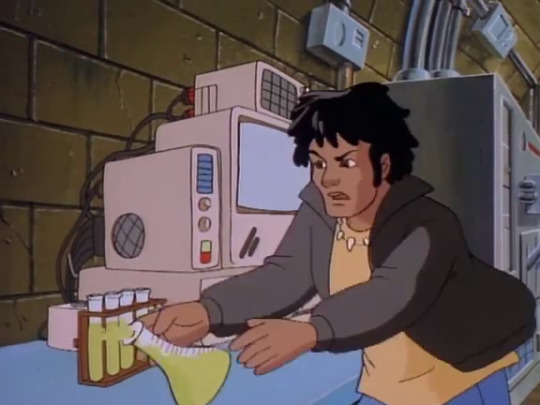
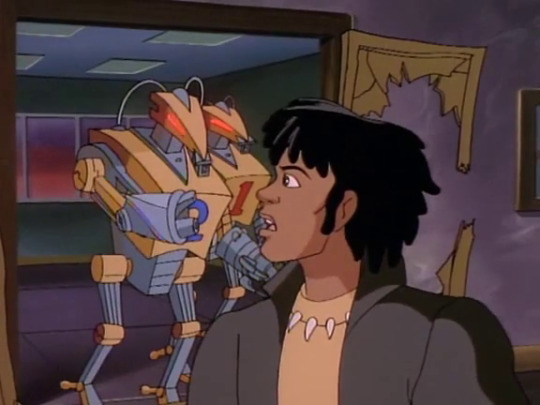
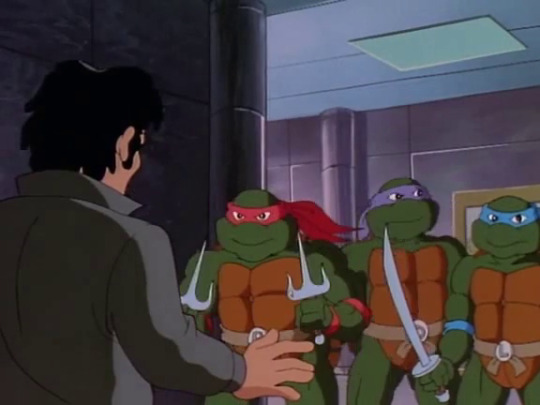
The Turtles do battle with the robots and are forced to take refuge in an elevator shaft, where the Turtle-Cam – worn during this mission by Michaelangelo – is soon destroyed. Fearing that the team are in trouble, Carter ignores their earlier instructions and rushes to their aid, accidentally splashing some of the contents of the mutagen beaker on his hand on the way out. Upon arriving at the building, he manages to unwittingly lead the Intimidators to the Turtles.


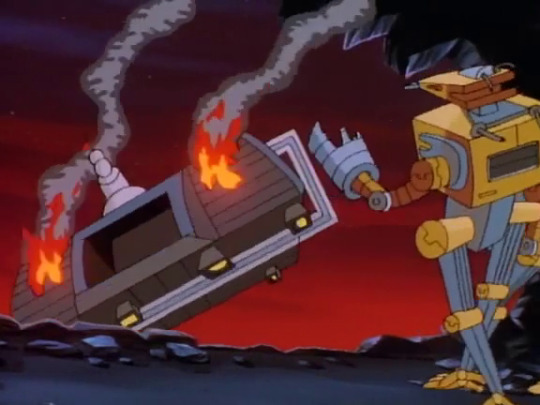


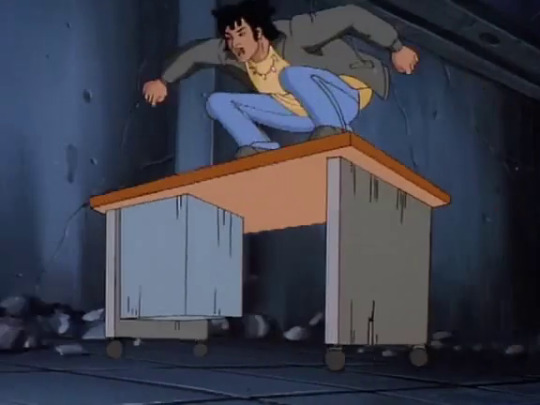
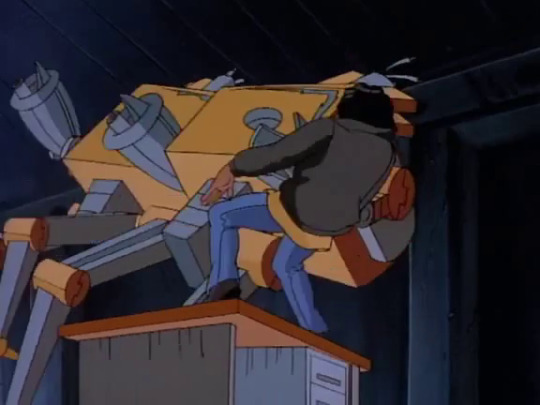
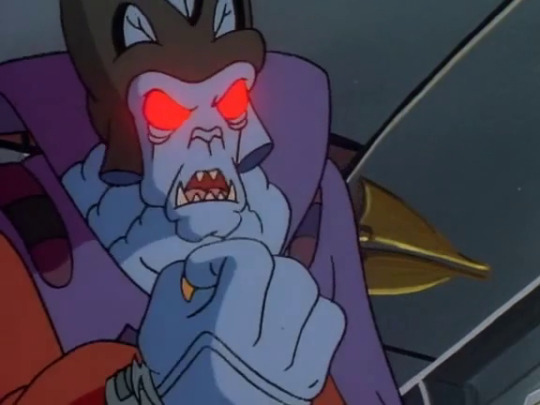
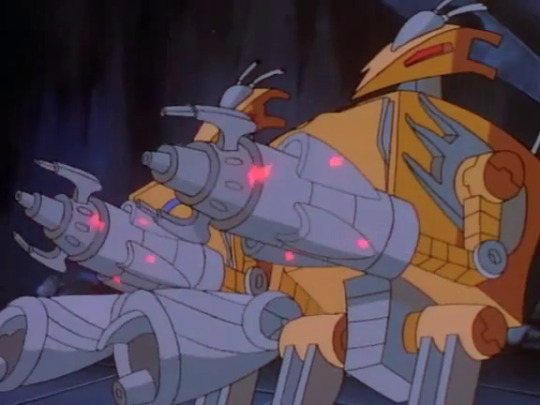
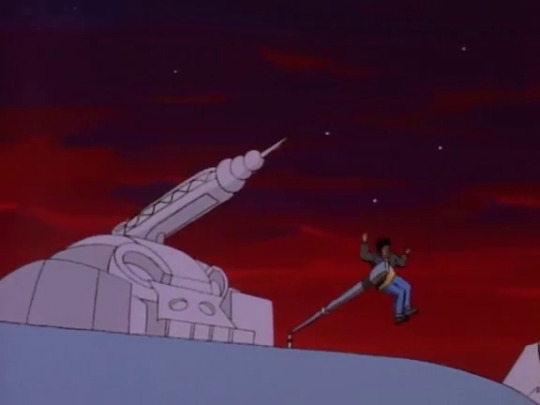
A bigger problem arrives as Lord Dregg emerges from his ship, announcing himself as the “Supreme Warlord of the Seven Galaxies”, intent on conquering the Earth. The Turtles turn their enemies against each other, diving out of the way to have Dregg’s ship open fire upon the Intimidators. The team then work to wear down both the law enforcement robots and the ship, but find themselves overwhelmed. Carter steps in, riding a rolling office desk to topple the Intimidators. Meanwhile Dregg, seeing the threat posed by the green teens, uses his ship’s equipment to revitalise the two robots, before taking Carter hostage and escaping.

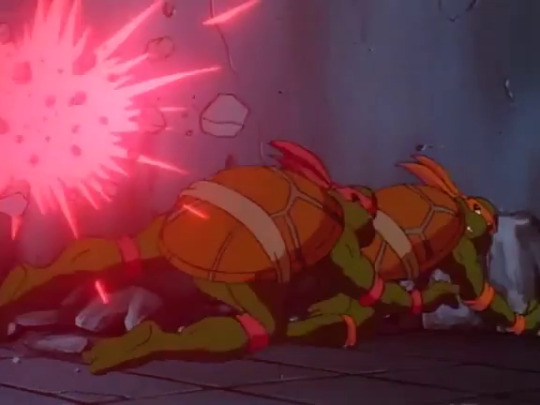

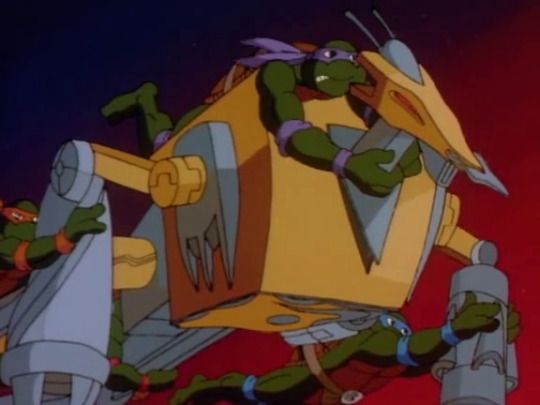
Left to fight the robot duo on their own, the Turtles watch as one of the Intimidators self-destructs – a nasty going-away present for anyone capable of defeating them. Seeing an opportunity, Donatello connects a Turtlecom to the remaining robot, connecting it to his workshop’s computer. This grants the team with control of the bot and they use it as a makeshift vehicle, flying out of the building in pursuit of Dregg’s ship.
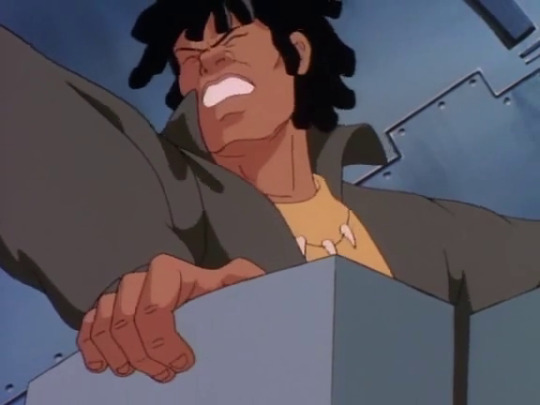
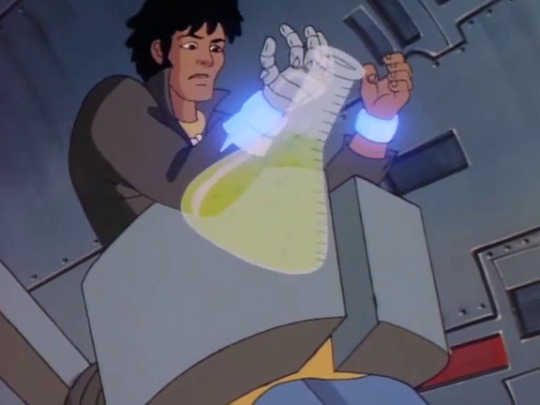
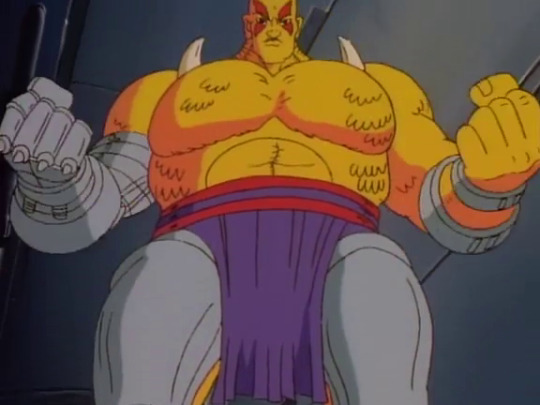
Aboard Dregg’s spacecraft, Carter remains caught in a giant claw. He writhes and struggles as he attempts to free himself, grunting about how he’s “gotta be strong” until he begins to mutate, a visual of the beaker from earlier superimposed over this sequence as apparently the show doesn’t trust us to understand what’s going on even after eight full years of watching assorted people and animals undergo this process. His new form is what I can only assume is the result of what market research and focus groups told the producers that mid-nineties kids would want from a new Turtles character: a mish-mash of Liu Kang, Vega and... I don’t know, a big yellow chicken.
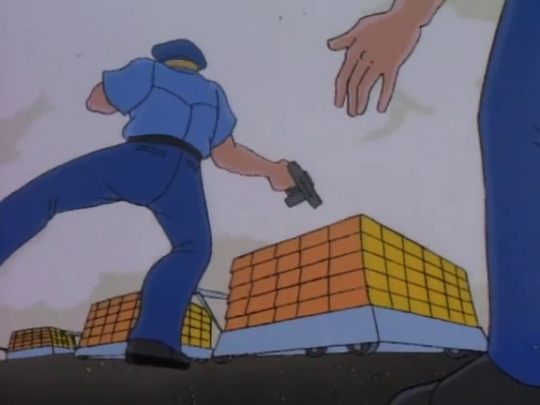
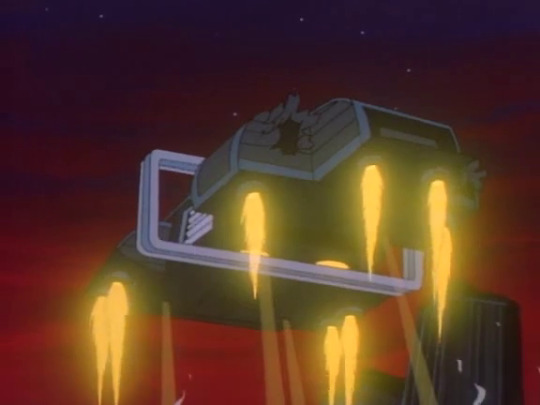
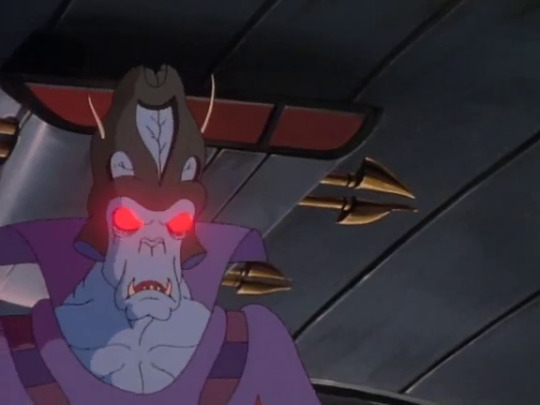


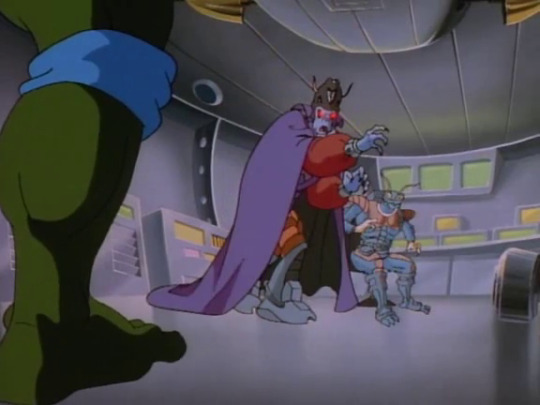

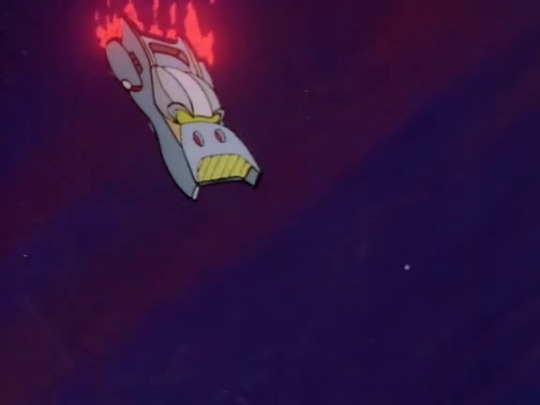

Dregg again attempts to steal the gold, explaining to nobody in particular that he needs it to repair the weapons systems of his mothership, the Dreggnaught, ahead of his eventual conquest of Earth. An unexpected complication arrives in the shape of the Turtles, utilising the Intimidator to attack the smaller ship. As Carter uses his new martial arts cyborg form to break free, the Turtles confront the warlord. The giant mutant – whose real identity the Turtles remain unaware of – shoves them out of the ship moments before the detonator function of the Intimidator causes the craft to explode. Dregg escapes in a smaller vehicle, returning to his mothership in orbit above the Earth.

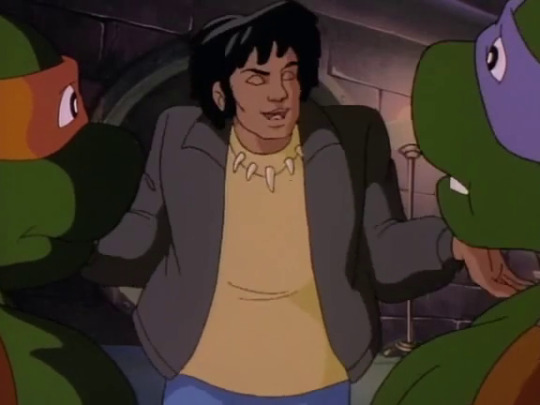
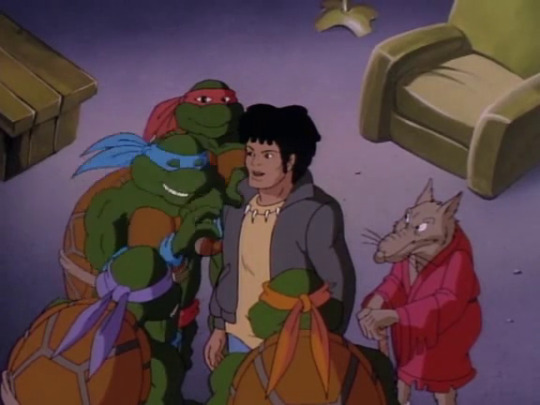
The Turtles, having been separated from the giant mutant who saved them, return to their Lair, lamenting that Carter appeared to have perished in the ship’s explosion. Now back in his normal form he returns to greet them, evasive in his explanation of how he escaped. Splinter remarks that “any young man who could survive such overwhelming odds surely has unusual powers”. Carter responds that he’s ready to begin his training under the team’s sensei, and now receives a warm welcome from the Turtles.
You might be able to sense my hostility in today’s entry towards the changes to the show’s dynamics being introduced here. While season seven saw a natural evolution and a necessary maturation for TMNT to keep pace with its now older viewership, season eight felt like a desperate roll of the dice to ensure the survival of the series, and while some aspects of this reinvention felt like an over-correction, I was surprised by how solid it was. We now find ourselves in a situation where somehow even this was felt to not be enough. There’s an insecurity on display here, the show second-guessing itself by redesigning the Turtles and April for a second time. The culmination of these changes has resulted in the series losing everything that made it visually appealing, looking instead like so much of the cookie-cutter animated dreck of the era (see the Double Dragon cartoon as an example of the glut of action shows which arrived following the success of Batman and X-Men, typically produced on a fraction of the budget with none of the craftmanship or charm, almost all of them long-forgotten). This occurs at the same time as yet another shift of animation studio, Dai Won being replaced by Shanghai Morning Sun Animation, who around this time were working on the similarly mundane American cartoon adaptation of Street Fighter. TMNT has certainly looked worse – there's nothing in here near the lows of the MW Dublin episodes – but much of the heart of the classic era is now gone.
Turtles has never been short of Scrappy Doos and Poochies – kid characters and/or super cool dudes who are supposed to be relatable to the audience and expand the appeal of the property beyond that of the main team. Zach and Mondo Gecko are obvious examples of this in the 1987 continuity, Keno serving a similar role in the live-action movies. Carter comes across as an attempt to find the sweet spot in a Venn diagram between all three. He reminds me of the common occurrence in long-running sitcoms where once the original child actors grow older a new, younger kid would be introduced to the show to recapture the magic of the early years. From the outset it’s clear that he’ll have an uphill battle winning over viewers who have gotten used to the dynamic of the Turtles as a quartet over eight years. He’s an interloper here, effectively inheriting the poisoned chalice of the “Fifth Turtle”, and based on my memories of seeing these episodes the first time around I have little faith in his ability to win me over in the short amount of time the show has left.
Similarly, Lord Dregg has big shoes to fill given that he replaces Shredder as the show’s main villain immediately following Oroku Saki’s reinvention as a competent character in season eight: how could any new guy come in this late in the day and possibly top the shocking destruction of the Channel 6 building? Tony Jay is no slouch as voice actors go, but so far Dregg is missing something. The Turtles have run into too many alien invaders over the years for this gimmick to be a novelty, and nothing in this episode elevates this warlord to the point where he feels like a significant threat to them, a challenge to our heroes big enough to justify him taking over from Shreds.
The evolution of TMNT in the Red Sky era continues, with further steps taken here towards long-form storytelling, teasing viewers with hints of events still to come such as the potentially-unstable mutations of the Turtles. We’ll see the continuation of that in the next episode, “Dregg of the Earth”.
#Teenage Mutant Ninja Turtles#TMNT#TMNT 1987#Carter TMNT#TMNT Carter#1995#Ninja Turtles#Turtlethon#Lord Dregg#Dregg#The Unknown Ninja
3 notes
·
View notes
Note
I very vividly remember reading about a David Wise episode where it was mentioned by the Turtles in the beginning that they had proof that Hamato Yoshi was framed by Oroku Saki for his actions against the Foot Clan and Shredder wanting to steal it.
Do you remember that episode, I'm trying to find it?
That would be The Missing Map!
1 note
·
View note
Note
With AJ Howard, I wonder if there's more to his mutant self hidden under a latex disguise or if he has a slug head with a normal body? The statue of his mutant form indicated his slug self was at least relatively human in shape, so I'm gonna assume he still has legs and fingers under the disguise, even if they're slimy.
As for J. Gordon Hungerdunger, I feel you could turn him into a playmates figure if you mutate him; undoubtably into a western setting animal like a Buffalo. Though then again that might be creeping into Cowboys of Moo Mesa's territory.
PS: The writers of the Dirk Savage episode sure knew the future when they did a plot of a powerful land mogul with his own tower persecuting minorities for his own power play!
I suppose Hungerdunger wouldn't even need to be a mutant animal to make it into the toy line, sometimes there are figures in there who appear conventionally human but every aspect of their look is turned up to 11 (like Tattoo or Pizzaface). Just make him the rootin'-est, tootin'-est guy ever, give him a comically oversized removable 50-gallon hat that's almost as big as he is, make his moustache as wide as his entire body, take that dollar sign bolo tie thing he had going on and make it a big chromed piece, go all-out.
(It's a shame that the flow of traffic in TMNT at the time seemed to go mostly one-way, we got a lot more characters introduced into the show who were created for the toy line than the other way around. Occasionally we'd get a highly requested figure like Mona Lisa and I still think it's incredible that in time they got around to sort-of doing both Super Rocksteady and Mighty Bebop, but the cartoon is full of characters and vehicles that would have made great toys, that just didn't happen - I'm tempted to compile a list, actually!)
Howard kind of got the worst of it from both sides: the requirement for his mutation to be a twist revealed halfway through his only episode meant his backstory was inevitably going to be underdeveloped, and he didn't receive a satisfactory exit. It can't have helped that he had to share screen time with Dirk Savage, plus all of the guest mutants. Maybe the Dirk Savage ep was another one from season seven that would have been better served by being a multi-part show. And yeah, something about him feels... almost like a quasi-mutation rather than a full one, closer to cat lady April rather than someone like Baxter whose transformation would be impossible to conceal. (That's actually something in itself that could be explored if things weren't so constricted: he calls himself the greatest mutant of all time, and maybe the rationale for his hate campaign was rooted in him convincing himself he's not like the other mutants. Behind the mask, he can continue to mingle in high society and act as if nothing had changed, a privilege not afforded to the people he's attacking.)
The comparison to Trump is well-observed, and something I didn't pick up on while writing about the episode. Howard is probably about as close as you could get to just putting Ross Perot in the show as a slug-man without risking legal action; giving him Richard Nixon's voice comes across as an obfuscation to be able to say he's not intended to represent any one person. But yeah, the tower named after himself and its gold interior suggests there was always a little of Trump in his NY property mogul era mixed in there too. Something that I didn't know until I was doing research to write the Dirk Savage Turtlethon entry was that Perot initially polled strongly in the 1992 presidential campaign before falling off. Trump basically borrowed his whole "I'm a successful man of industry, put me in the White House and I'll run it like a business" schtick from him, but had the advantage of not running as a third party candidate.
So I guess AJ Howard deserves at least an honourable mention as yet another Trump stand-in alongside McDonald Crump, Donald J. Lofty, Fenton Q. Hackenbrush, and in the UK Hero Turtles comics, Ronald Bump. There's probably more of these across the wider spectrum of TMNT media that I haven't discovered yet - it seems that wealthy buffoon / unscrupulous real estate kingpin / blustering con-man worked well as a foil for the Turtles at the time.
1 note
·
View note